TAMPA'S FIRST
PAID FIRE DEPARTMENT AND ITS FIRST CHIEF
This page is in the
process of being updated.
|
|
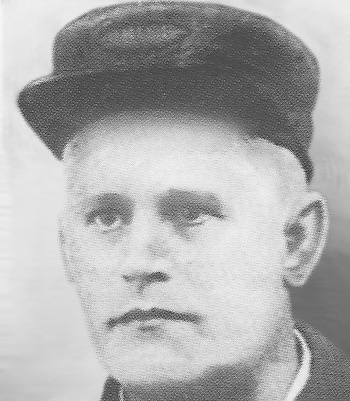 |
|
Photo of A. J.
Harris courtesy of TFD Capt. Bill Towsend's
"Tampa's Bravest" website. The source
of the photo is from a 1995 Tampa Fire Dept.
Yearbook. |
A.
J. HARRIS - TAMPA'S FIRST CHIEF ELECTED TO
TAMPA'S FIRST PAID FIRE DEPT.
Andrew J. Harris's
lifetime events presented here come from
various Tampa newspaper articles,
including two published at the time of his
death, and one a year later. One of
the two published at the time of his death
was an article in the Savannah Daily Morning
News which was reprinted in the Tampa
Tribune. Merged into the story is info
from newspaper articles in the Savannah
Daily Morning News while he lived in
Savannah and some after he
came to Tampa. Also included is info
gathered from articles in Tampa newspapers,
along with various other records such as
censuses, vital statistics death
certificates and web pages which present
history of the Tampa Fire Dept, such as the
Tampa Firefighters Museum and "Tampa's
Bravest."
FOR
HISTORY BEFORE CHIEF HARRIS SEE PREVIOUS PAGE, A. C.
WUERPEL |
|
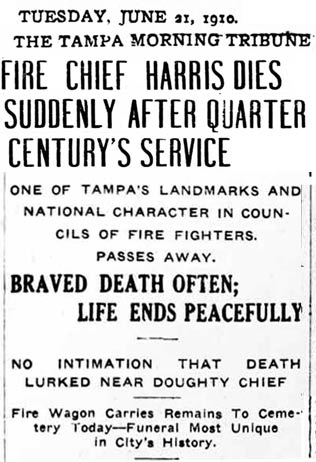 |
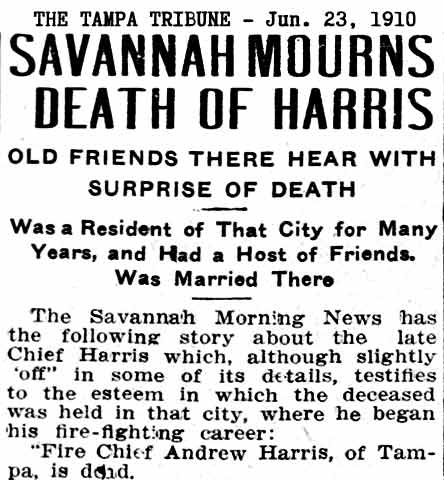
This Tribune article includes the
article about Harris's death which appeared
in the Savannah Morning News. When
information from this Tribune article is
cited in this feature, it will be cited as
from the Savannah Morning News of June 22,
1910, with an asterisk (*)
|
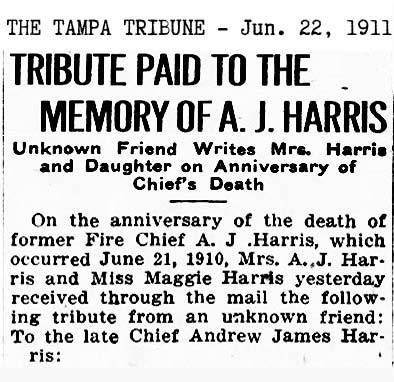
The letter from "A Friend, F.E.M."
claims Harris's middle name was James. |
|
|
A.
J. HARRIS - TAMPA'S FIRST CHIEF ELECTED TO TAMPA'S FIRST
PAID
FIRE DEPARTMENT
|
Andrew
Jackson Harris was born in
Liverpool England1 on Aug. 28, 18382 and
came to the States with his stepfather
when he was a boy of 16.3
It's not
yet known if his mother traveled with them or joined
them later.4
|
|
 1The
1938 death certificate of A. J.'s son,
Andrew Martin Harris, provides A. J.'s
middle name, Jackson, and birth place as
Liverpool. Information for the death
certificate of Andrew M. Harris was given by
his sister, A. J. Harris's daughter, Miss
Marguerite L. Harris. 1The
1938 death certificate of A. J.'s son,
Andrew Martin Harris, provides A. J.'s
middle name, Jackson, and birth place as
Liverpool. Information for the death
certificate of Andrew M. Harris was given by
his sister, A. J. Harris's daughter, Miss
Marguerite L. Harris.
2Calculated from
his reported age at death in the June
21, 1910
Tampa Tribune article
published the day after his death. The
month and year are in agreement with
his 1900 Census in Tampa.
3Tampa
Tribune, June 23, 1910 Savannah Mourns Death
of Harris, a reprint of an article in the
Savannah daily Morning News of June 22,
1910. His 1900 census shows he
immigrated in 1850 and had lived in the U.S.
for 50 years. If correct, he would have been
11 or 12 at the time he immigrated.
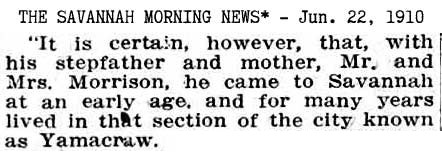 4Tribune
reprint of the article in the Savannah daily
Morning News of June 22, 1910 says that he
came to Savannah with his stepfather and
mother "at an early age." The article
incorrectly identifies them as "Mr. & Mrs.
Morrison" instead of Morris. 4Tribune
reprint of the article in the Savannah daily
Morning News of June 22, 1910 says that he
came to Savannah with his stepfather and
mother "at an early age." The article
incorrectly identifies them as "Mr. & Mrs.
Morrison" instead of Morris.
|
|
The Tampa Tribune article published the day
after his death says he was born in
Gibraltar, which was and still is a
territory owned by England. His ages
as described here calculate to a birth date
of Aug. 1838. |
The Tribune article published a year after
his death which uses an anonymous friend's
letter to Andrew's widow and daughter and gives
his middle name as James. |
|
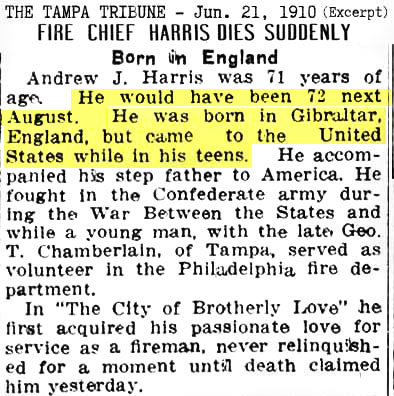
Harris enlisted with the Confederacy after
he moved from Philadelphia to Georgia.
|
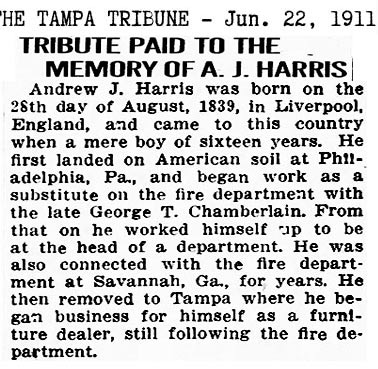
The "Friend, F.E.M." letter also claims he
was born a year later, Aug. 28, 1839, in
Liverpool, Eng. |
|
Why would this
source claim he was born in Gibraltar?
The answer is found in his half-brother's,
George Marshall Morris', background. |
|
|
Andrew J.
Harris in Philadelphia
Harris arrived (in 1850 according to his
1900 census) at Philadelphia and while a
young man there, he first acquired his
passionate love for service as a fireman, and never
relinquished it for a moment his entire life. He served
as a volunteer substitute in the Philadelphia fire
department along with George T. Chamberlain. From there
he worked his way up to the head of a department.
[Grismer, A History of Tampa, 1959]
Chamberlain was a
successful businessman and real estate developer of
Tampa. He served in Tampa city government as councilman
and on various committees including the fire
department.
|
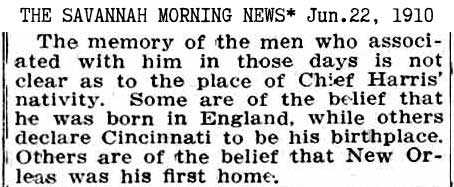
By the time of his death, there was no
consensus among his former friends in
Savannah as to where Harris was born. |
|
No records have yet been found for Harris in
Philadelphia.
Assuming he was born in 1838, he would have
only been 11 years old if he arrived in
1850. Considering that by 1862
(article below) he was in Georgia, he would
have been at most 23 years old while still
in Philadelphia and old enough to have
served as a volunteer substitute in their
fire department for five years.
(Assuming 18 was the minimum age.) |
|
|
|
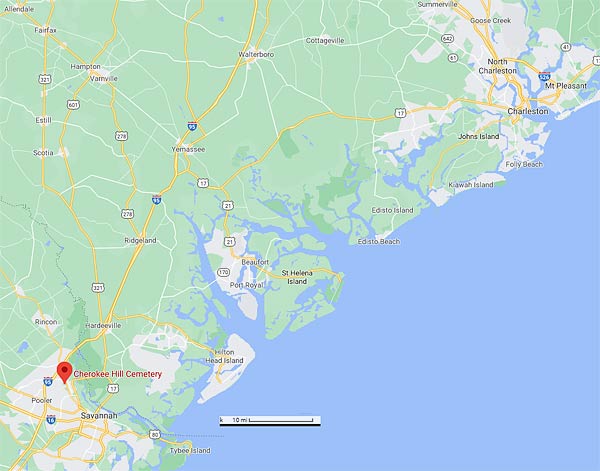 A. J. HARRIS IN SAVANNAH, GEORGIA A. J. HARRIS IN SAVANNAH, GEORGIA
From
Philadelphia, Harris came to Savannah, Georgia (with his
step father and mother, according to the Savannah
Morning News, Jun. 22, 1910) and
enlisted in the Confederate army during the Civil War.
By Jan. 1, 1862 he was stationed at Camp Iverson with
Co. A, 5th Georgia Regiment.
Camp
Iverson was originally located in Chatham County Georgia
five miles below Cherokee Hill, near the railroad. On
December 1, 1861 it was moved to Cherokee Hill, eight
miles above Savannah. A letter references the location
as being on the Charleston & Savannah RR and about
midway between the Savannah River and the central RR.
(Georgia
in the Civil War Message Board)
|
|
Muster Roll of the United Rebels, Co. A, 5th Georgia
Regiment
State troops stationed at Camp Iverson, Jan. 1, 1862
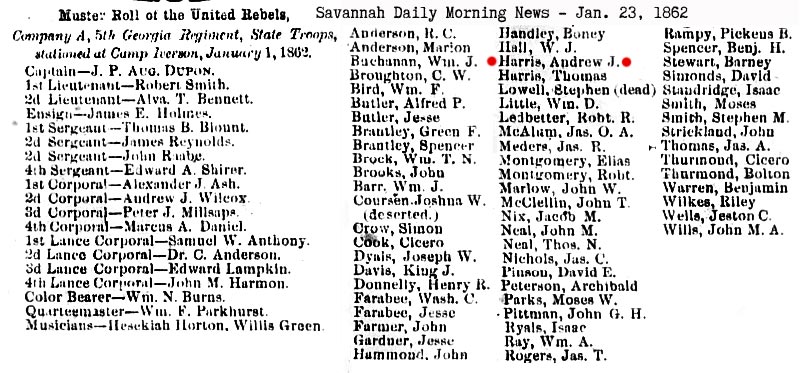
|
|
Harris was a furniture upholsterer by trade,
and soon became a leading member of a highly
accomplished, skillful volunteer fire
company in Savannah which competed with
other such companies all over the country,
easily defeating companies in such cities as
Boston and Philadelphia. He
was described as a "quick man and par one" in
studying fire conditions. He applied
himself to this work and was an assistant
engineer (Assistant Chief) later in the Savannah Department.5
5There was no mention of Harris achieving
the position of Assistant Chief by those who
knew him in Savannah according to the
Savannah Morning News article of June
22, 1910.
See more info later at the 1882 Fire Dept.
elections of Savannah.
 |
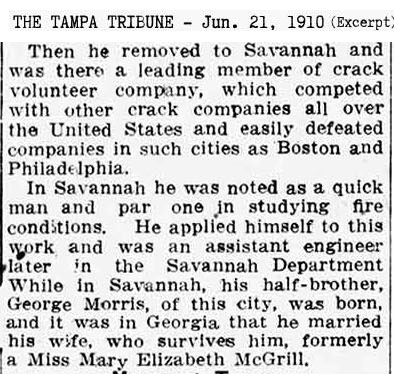
While in
Savannah, his half-brother, George Morris
(of Tampa) was born, and it was in Georgia
that Harris married Miss Mary
Elizabeth McGreal of Savannah.
|
|
1870
Census, Savannah, Ga.
It is the opinion here that the below is the 1870 census
of A. J. Harris's wife-to-be, Mary McGreal.
Mary Greal on
line 18 is living with four older Greals listed above
her, but none old
enough to be one of her parents. Mary and those
above her indicate born in
Georgia (Mary's 1880 Census in Savannah with husband
Andrew Harris shows she was born in Ga.)
On line
19 below Mary is Ellen Greal, born in Ireland, who is
almost certain to be
the mother of all others in the home due to her age (53), and she was born in Ireland.
Ellen was probably widowed and living with her children
here. Most importantly, columns 11 and 12 for Mary
and those listed above her indicate
both their parents were of foreign birth. (Mary
Harris's 1900 census in Tampa shows her parents from
Scotland. Her 1910 census in Tampa shows her
parents from Ireland.)
The entry
for this family was made on June
15, 1870 |
|
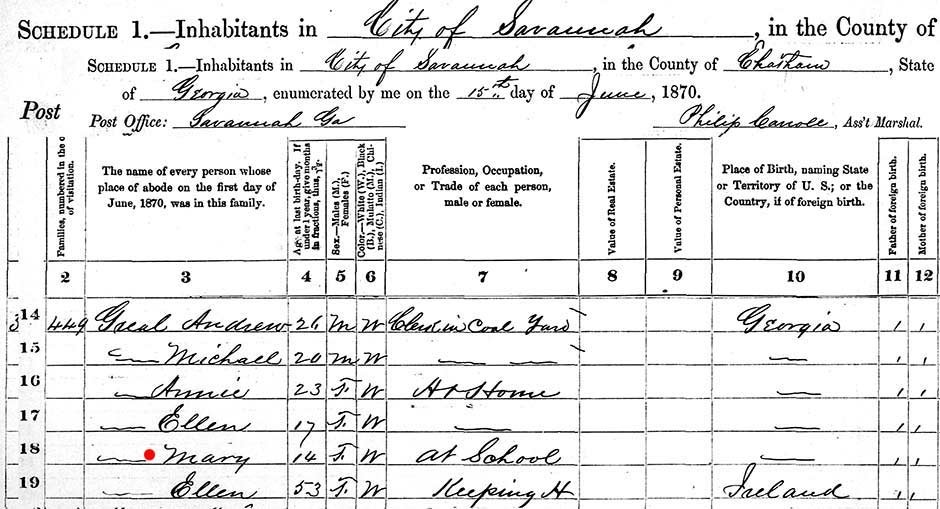
Harris has not
yet been found on the 1870
census. He was probably
living nearby and may have been
listed with surname Morris
instead of Harris.
1850 Census, Chatham Co., Ga.
Census of Andrew & Ellen McGriel
This record is excellent
evidence that the 1870 Mary Greal in Savannah is Mary
Elizabeth McGreal
who married Andrew J. Harris.
Here is the same Ellen, mother of Mary Eliz., at age 35
with Andrew McGriel at age 40
above her who most surely was
her husband. Both indicate
they were born in Ireland ("Do."
is "Ditto.) On line 7 is
Andrew, Mary's brother, here at
age 9, here listed as born in
Ireland. On line 8,
"Honora" (female) age 5, born in
Ga., who probably married by
1870 and is not in their 1870
household. On line 9 is
Michael, age 1, born in Ga.,
same one on the 1870 Census in
Savannah. Finally, out of
chronological order is Mary Jane McGriel, at age 16. She is
listed out of order
indicating she isn't a child of
the head of house. Mary
Eliz. McGreal who
married Andrew Harris was not
yet born in 1850. She was
born in 1855-56.
1850 Census, Chatham Co., Ga

|
|
|
Harris was an upholsterer and worked at his
trade during the time he lived in Savannah.
An Apr. 2, 1884 article in the SMN presented
further down shows he served as Secretary of
the Wavers Company.
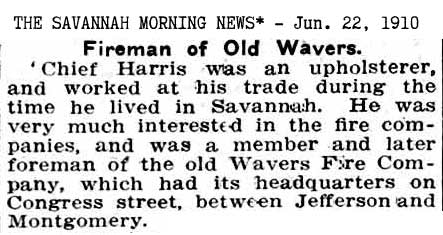
The paper refers to him as "Chief" because
of his position in Tampa. No mention of an
Assistant Chief position in Savannah. |
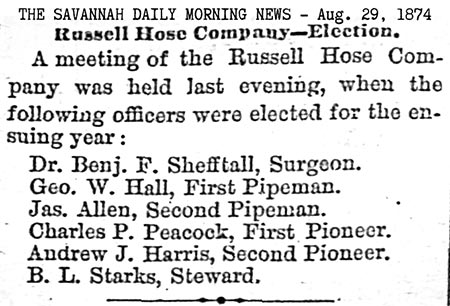
Andrew J. Harris was elected Second Pioneer
of the Russell Hose Company on Aug. 28, 1874.
His membership in the Wavers Co. came later. |
|
Andrew J.
Harris and Mary Elizabeth McGreal were
married in Chatham, Ga. on Sep. 15, 1874,
according to
Georgia, County Marriages.
|
|
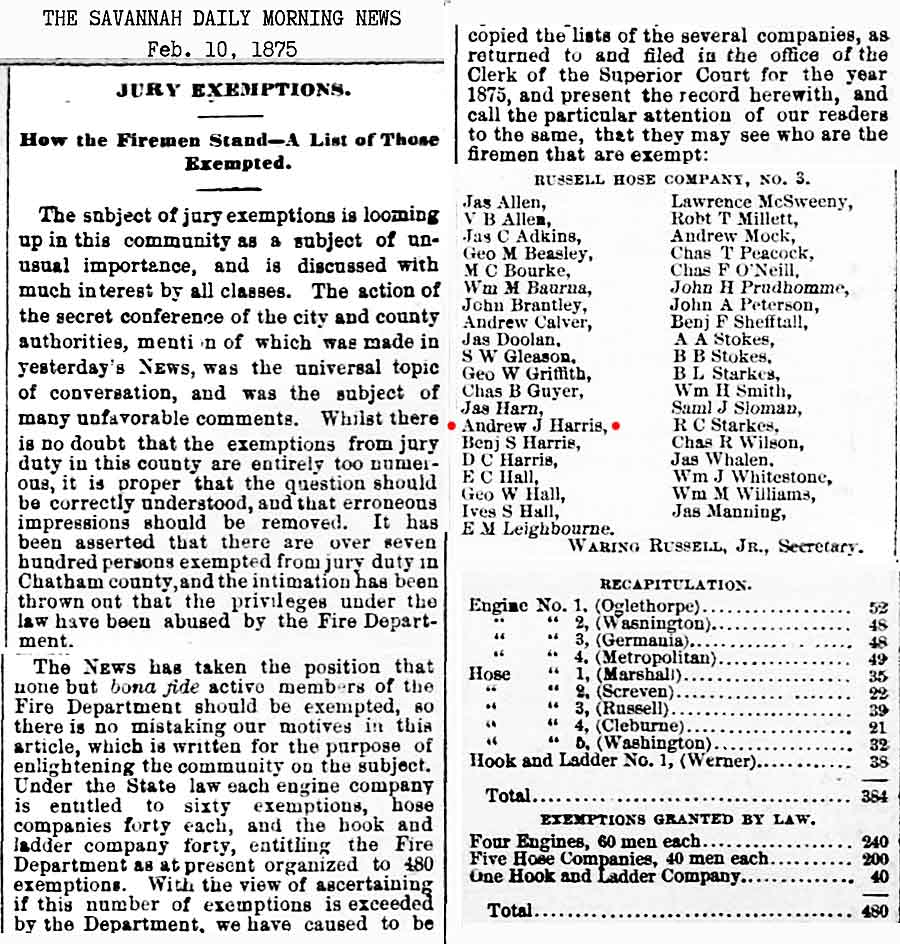 |
In Feb. of
1875, the topic of jury exemptions was
apparently a hot issue, and so the Savannah
Daily Morning News undertook to investigate
the fire department to see if they were
exceeding the maximum number of
state-allowed exceptions of 480.
They found
that only 364 exemptions were being
claimed by the department.
The article
at left has been edited and rearranged so
that only the Russell Hose Company appears,
along with the recap of all the companies at
the end.
|
|
If you wish
to see the entire article showing the names
of the exemptions for all 10 companies, click
here to see the full article larger,
then click it again to see it full size. |
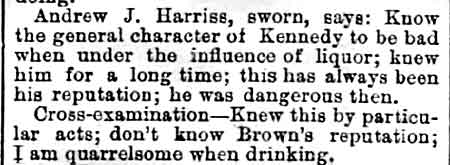 On
March 20, 1876, Harris was one of the character
witnesses in the State of Georgia vs. Dukes Brown, a
murder trial. Harris testified as to the character of
the victim, whom he had known for "a long time." On
March 20, 1876, Harris was one of the character
witnesses in the State of Georgia vs. Dukes Brown, a
murder trial. Harris testified as to the character of
the victim, whom he had known for "a long time."
You can see the whole article here at the Georgia
Historic Newspapers website. It is a free site. |
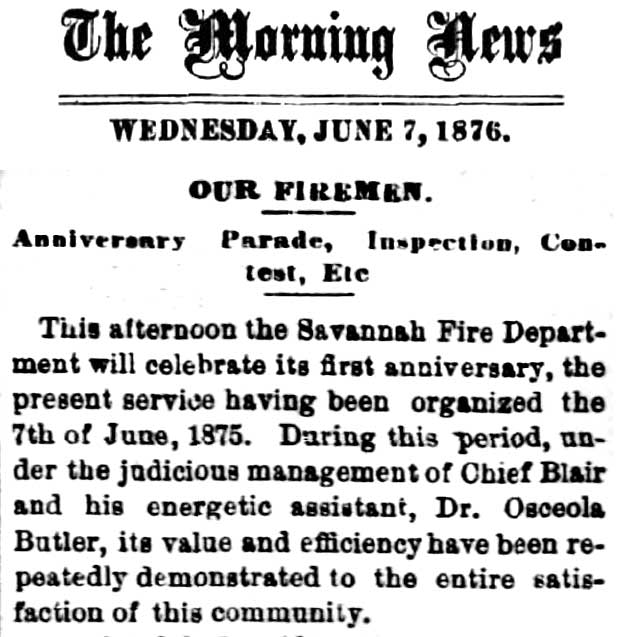 THE
SAVANNAH DAILY MORNING NEWS THE
SAVANNAH DAILY MORNING NEWS
June 7, 1876
(See the entire page of this article at the
Digital Library of Georgia.)
Transcript
of entire article:
OUR
FIREMEN
Anniversary Parade, Inspection, Contest, Etc
This afternoon the Savannah Fire Department
will celebrate its first anniversary, the
present service having been organized the
7th of Jane, 1875. During this period, under
the judicious management of Chief Blair and
his energetic assistant, Dr. Osceola Butler,
its value and efficiency have been
repeatedly demonstrated to the entire
satisfaction of this community. That this
fact is appreciated finds evidence in the
presentation by Mr. Adam Moffat, general
agent of the Liverpool and Loudon and Globe
Insurance Company, to Assistant Chief
Butler, of a basket of champagne for the
reunion to day, the gift being accompanied
by a very complimentary letter upon the
efficiency of the department, whereby
insurance companies have been saved on
several occasions considerable amounts. We
understand that like tenders have been
received from other citizens. This is not
only exceedingly creditable to the
department but most be’ gratifying to Chief
Blair and Assistant Chief Butler, who have
certainly proven their eminent fitness,
judgment and discretion for the responsible
positions they occupy.
The
celebration to-day will be quite
interesting, the introduction of the contest
between the steamers being a new feature and
one that will be exciting, and show the
department to advantage.
The
following programme has been decided upon,
and will be carried out in detail:
The line will form on South Broad street at
Fireman's Hall at 3 o’clock, the right
resting on Abercorn street, facing east in
the following order :
Werner Hook and Ladder Company.
Music.
Washington Steam Fire Engine and Hose Reel
No. 1.
German Steam Fire Engine and Hose Reel No.
2.
Bartow Steam Fire Engine and Hose Reel No.
3.
Cleburne (auxiliary) Hose Company and Mutual
Protection (auxiliary) Hose Company.
The
procession will move precisely at 3½ o’clock
as follows: South Broad to East Broad, East
Broad to Bay, Bay to West Broad, West Broad
to South Broad, South Broad to Drayton,
Drayton to Bay, to Ex change, where the
inspection will take place by the Mayor and
Board of Aldermen.
After the
inspection the contest between the different
companies will be conducted as follows:
German Fire Company engine No. 2 and reel
will start on the striking of box 17, take
plug and play water on Fireman’s Hall. The
Hook and Ladder will also respond, throw
ladder up against Fireman’s Hall, a man will
ascend to the top and immediately descend in
ten minutes from the time of the first tap
of box 17. One tap will be given, and
repeated in five seconds, calling engine No.
1 and reel (Washington), which will respond
and take plug and play water on Fireman’s
Hall in ten minutes from the first tap
calling engine No. 1. Three taps will be
struck, and in five seconds repeated,
calling engine No. 3 and reel (Bartow),
which will respond, take ping and play water
on Fireman’s Hall. No engine will be allowed
to steam up until the alarm is sounded that
is to call her. After the contest the
apparatus will be drawn up in front of
Fireman’s Hall, on South Broad street, and
the different companies repair to the hall,
where a collation will be spread, winding up
the programme of the day. |
| |
SAVANNAH
DAILY MORNING NEWS - June 7, 1877
The Savannah fire department celebrated its
two-year anniversary.
Excerpt of article to show participating
companies:
 |
|
See the results of the contests which took
place at this 2nd anniversary celebration. |
|
1880
Census, Savannah, Ga., Zubby Street
Andrew & Mary E. Harris
 |
|
Andrew J.
Harris and wife Mary E. Harris lived in the same
dwelling as Charles Clark, a painter from Maine.
A. J. was a cabinet maker. Both his parents were
from England, his wife Mary E. was born in Georgia,
circa 1853-54.
This census indicates both her parents were from
Georgia, but later censuses show they were born in
Ireland and Scotland, and her 1870 census with her
mother Ellen shows Ellen born in Ireland. A.J.'s
age here is quite a bit underreported, he would have been 41 or 42 in
1880. It is probable that Charles Clark provided the info
for this record,
and gave his best guess. This would also
explain why Mary's parent's birth places were listed as
Georgia.
|
| |
|
|
Read about the 6th anniversary celebration
of the Savannah fire department in the
Savannah Morning News on June 8, 1881. |
| |
|
|
January 18,
1882 - The city council of Savannah
passed a resolution to instruct the clerk of
the council to start advertising in the
official newspaper that the city would be
electing a Chief and an Assistant
Chief for the fire department.
Feb. 2,
1882 - The newly elected officials were
announced:
Chief:
Osceola Butler, a long-time Assistant
Chief of the old department, a former member
of the Metropolitans fire company.
Asst.
Chief: George Mouro, former Secretary of
the old department for many years, Secretary
of the current department, and former
Foreman of the Washington Fire Co. (of
Savannah.)
Other
candidate in the election for Chief: Adolph
Fernandez, former member of the old
department, Assistant Chief of the present
dept. for a number of years, and since the
resignation of Chief Blair, had been acting
Chief. |
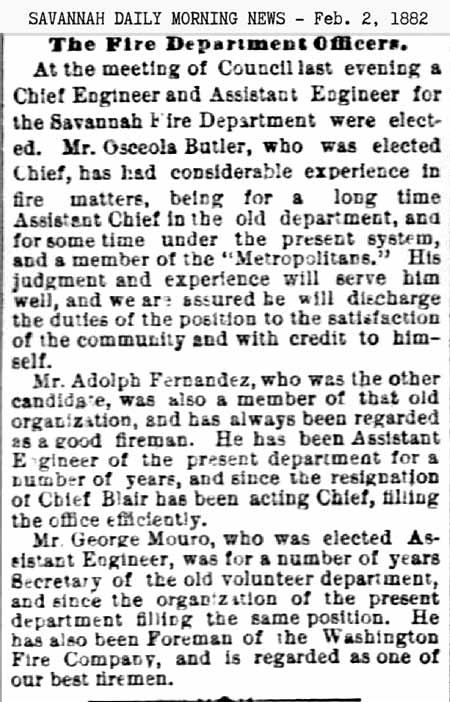
No mention
of Andrew Harris.
|
|
Read about the 7th anniversary celebration
of the Savannah fire department in the
Savannah Morning News on June 8, 1882.
Savannah Morning News, Aug. 18, 1882 - List
of Registered voters in Chatham County. |
|
Apr. 2, 1884 - Harris was elected as Secretary of the Wavers Steam Fire
Engine and Hose Company to replace John McGuire who
resigned to become a paid member of the department.
|
Oct. 22, 1884
- This article has been edited to show only
the bills related to the fire department.
|
|
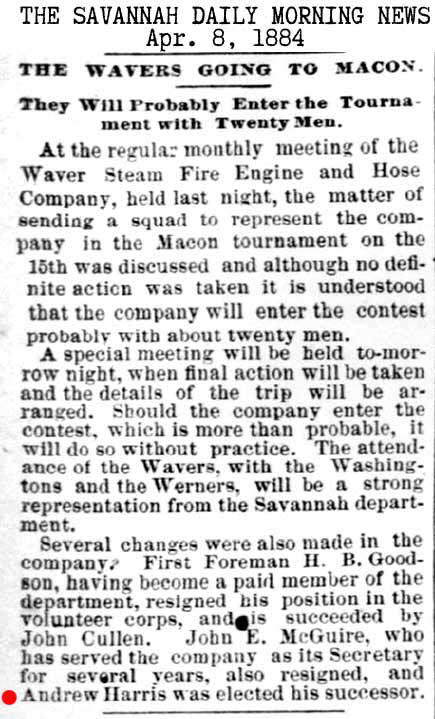
|
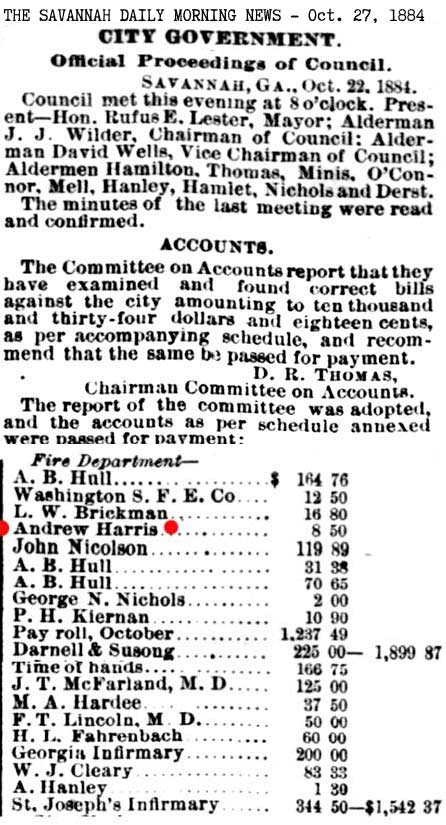
|
|

AT LEFT:
Harris explains his actions at a fire of the
previous day, May 30, 1886, concerning a
verbal confrontation he had with the Chief.
Harris, whose engine was first at the scene
of a fire, came up short of hose after
laying it out. He asked the driver
reel No. 3 to lengthen his line and the
driver told him he would after he laid out
his own line of hose. Since
Harris had his laid out already, he told the
Chief about it. Harris claims the
Chief told him that "if I did not shut up he
would have me arrested." Harris goes
on to describe the situation as he assessed
it.
On June 15, 1886,
Harris was involved in an altercation
between a Savannah police officer and a
suspect being arrested for being drunk on
the street and trying to break into a house.
Now, Harris is the "former foreman of the
No. 2 Engine Co., just two weeks after his
incident with the Chief.
The arresting officer, Hall, had
the suspect in custody and was leading him down the
street when a crowd began to gather. Officer McDermott,
who from his office saw Hall having difficulty
restraining the suspect, went out and across the street
and offered to restrain the suspect while Hall went to the station for a wagon to take the suspect to the
barracks. Then, someone in the crowd remarked, "Here
comes another officer" and shortly, someone in civilian
clothes (Officer Rogers) arrived in "hot haste,"
grabbing the suspect by the collar with one hand and
struck him on the side of the head with the other.
McDermott
remonstrated with Rogers at which point Rogers
struck McDermott in the face with his fist. McDermott
later said to The Daily News, that after being struck,
he turned the suspect over to officer Hall who had just
returned, and "immediately returned the blow with
interest."
By this
time a large crowd had formed and "pressed close around
the policemen." Rogers told The Daily News that
McDermott caught hold of him to pull him away, and then
tried using his club, but someone knocked him (Rogers)
down. While Rogers was down, he was kicked in the back
and about his body by someone in the crowd. As Rogers
sprang up, he drew his pistol and kicked at the nearest
man to him, who happened to be A. J. Harris, former
foreman of the No. 2 Engine Co. Harris told The Daily
News the next day that he was not a willing participant
in the disturbance, he was just passing along on the
street with his wife on their way home when he was
struck by someone in the crowd, whom he afterwards
recognized as Officer Rogers.
Rogers
finally pointed his revolver at the crowd which quickly
gave the men plenty of room. All the while the scuffle
was going on, Officer Hall was struggling with the
suspect (Edward Paine) so Hall was unable to assist
Rogers, who was hit in the face and sustained a slight
cut under his chin. After order was restored, Rogers
helped Hall take the prisoner to the barracks. The
crowd followed but gave no more trouble.
Harris
went to the Magistrate and had a warrant issued for the
arrest of Officer Rogers. Later, Rogers, who had good
reputation on the force, and was known as a "plucky"
officer, stated that Harris was one of the crowd who had
attacked him. McDermott told the Savannah newspaper that
the only mobbing Rogers received was administered by him
(McDermott.)
The article below
describes Harris as "formerly foreman of the No. 2
Engine Company."

|
|
Ultimately, several names were placed on the docket for
this case, and "a lively time" was expected Friday
morning before the Mayor. On the 17th, the Morning
News published an article (below) with McDermott's and
Harris's version of the event but nothing concerning the
court session was printed through Monday, June 21 in the
Savannah Daily Morning News. On June 23 the SDMN
reported "the docket cases against Constable Frank
McDermott were dismissed yesterday morning by the
Mayor." |
|
Below is the
last mention of Harris in the local papers online, before he came to Tampa.
There was another Andrew Harris in another county who
was in the papers for run-ins with the law.

Between 1875 and
1890 Savannah Fire Rescue phased out its volunteer
companies and replaced them with full-time professional
firefighters.
The SMN article below says that when the
paid fire department began, Harris "severed his
connection with the department." This seems
to be more of an effort to describe when he left
and not why he left.

The above places his move to Tampa at
1886, and which time he quickly became affiliated with a
volunteer department that was already set up.

|
|
THE A.
J. HARRIS FAMILY COMES TO TAMPA
|
A. J. Harris
came to Tampa with his wife in the fall of
1886, continuing his career in furniture as
a dealer in mattresses and furniture, also
doing work as a general
upholsterer. |
|
At right:
Even though the Savannah Morning News
article stated that he "went to Tampa 24
years ago" (placing his departure in 1886),
in the next paragraph it claims he came in
the fall of 1885. His June 1886
altercation with policeman Rogers indicates
he was still in Savannah in the summer of
1886.
|
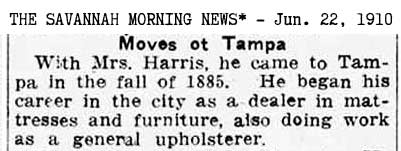 |
|
Harris's mattress and
upholstering business was doing quite well
in Sept. 1887. He would also install awnings
and repair furniture.
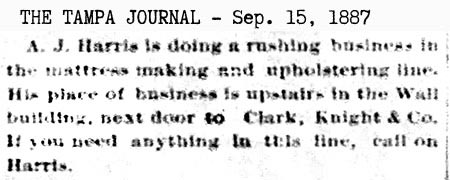 
The Wall
building was the location of the late Billy Washington
Wall's mercantile business, which became Clarke &
Knight's hardware when Billy Wall died suddenly. Billy Wall's son, Perry G. Wall
(future mayor of Tampa) was a minor when his father
passed away, so his uncle, E. A. Clarke (another future
Tampa mayor) controlled Perry's interest in the business
until Perry turned 21. At which point, Clarke & Knight
became Knight & Wall Hardware. Read about Knight & Wall
and these events here
at this TampaPix feature.
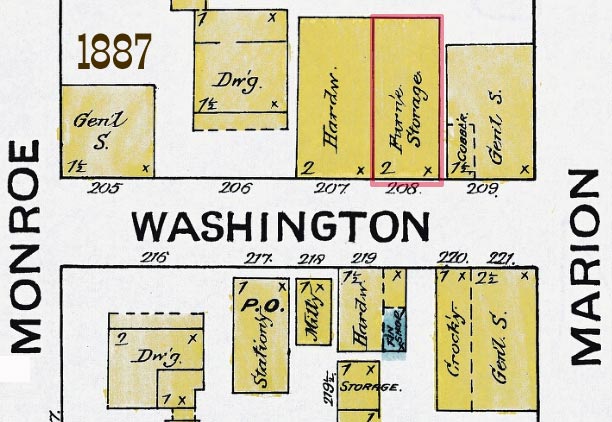
This 1887
Sanborn map from the UF Digital Library Maps Collection
shows a block of Washington St. between Monroe (later
named Florida Ave.) and Marion St. with the only
furniture-related business next to a hardware store in a
2-story structure.
WHOSE IDEA WAS IT TO START THE FIRST FIRE DEPARTMENT
IN TAMPA?
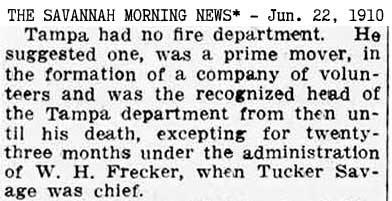 At right:
The Savannah newspaper article published at
the time of Harris's death in 1910 claims
Tampa had no fire department when Harris
arrived. Such was not the case, it had
a volunteer fire dept. It also credits
him for
suggesting a fire department upon his
arrival in Tampa, as do others published in
Tampa at that time, however, the process of
creating a fire department in Tampa had
begun before Harris arrived here. At right:
The Savannah newspaper article published at
the time of Harris's death in 1910 claims
Tampa had no fire department when Harris
arrived. Such was not the case, it had
a volunteer fire dept. It also credits
him for
suggesting a fire department upon his
arrival in Tampa, as do others published in
Tampa at that time, however, the process of
creating a fire department in Tampa had
begun before Harris arrived here.
|
|
The following sections in this
color contain events repeated from
the feature about A. C. Wuerpel
in order to provide a better
context for A. J. Harris
events-- TAMPA'S
FIRST FIRE DEPARTMENTS
(These events are covered in more detail in
the A.
C. Weurpel feature.) |
|
Hook & Ladder Co. #1 was
organized on Jun. 2, 1884; a
volunteer department with W. B.
Henderson as foreman, Fred
Herman, assistant foreman, and
C. P. Wandell, treasurer. Other
members were P. F. Smith, Dr. Duff Post,
Ed Morris, J. C. Cole, E. L. Lesley,
Phil Collins, S. P. Hayden, Frank Ghira,
H. L. Knight, A. J. Knight, C. L .
Ayres, S. B. Crosby and A. P .
Brockway. In 1885, A.C. Wuerpel
was appointed to be the department Chief, a
year before Harris's arrival in Tampa.
However, due to a
relative lack of fires and lack of interest
of the members along with their desire for
public recognition, the fire-fighting
organization formed in June of 1884 became defunct.
[A. C. Wuerpel's resignation letter of
1890.]
Disastrous
fires of 1885 and May 1886 caused
interest to revive the fire department
and Wuerpel again was chosen as its chief with
seven "bucket brigades" organized to
serve the city. |
|
The
Mugge Pumper
Immediately after the Baldwin
house/Miller & Henderson fire of May
12, 1886, Wuerpel
and Tampa's leading citizens
convinced the town council that it
would be wise to invest in a fire
engine so a $600 "hand pumper" was
ordered. Paid for by successful
liquor dealer Robert Mugge, it
became known as the "Mugge Pumper."
It arrived July 30, 1886 along with
350 feet of two-inch hose and a hose
reel. Almost everyone in town
turned out the next day to see the
engine tested. The hose was run down
to the river and six of the
strongest firemen began laboring on
the pumps. The results were a
splendid-a stream of water which was
thrown clear over the top of John T.
Lesley's two story building at
Franklin and Washington.
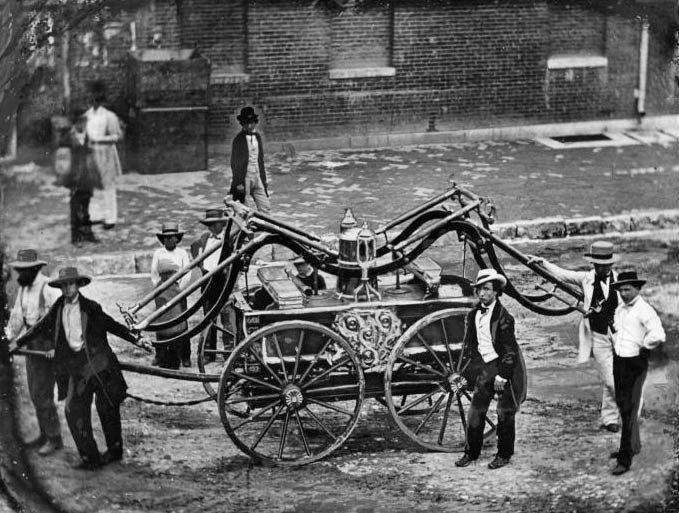
Example of a hand-drawn pumper truck
which could be powered by six
firemen.
Image from "Hand Pumped Fire
Engines" by Flags Up at Pinterest
|
TAMPA VOLUNTEER FIRE COMPANY ORGANIZED,
Aug. 30, 1886
[Grismer,
A History of Tampa, etc., 1959]
To make effective use of the new
equipment, the Tampa Fire Company
was organized on August 30, 1886,
with A. C. Wuerpel as president,
Robert Mugge as secretary, and
Herman Glogowski as treasurer.
Other members were G. B. Sparkman
(later the City of Tampa's first
mayor and judge of the circuit
court}, Odet Grillon, H. Hearquist,
C . O. Pinkert, John R. Jones, Leon
Dartize, Charles G. Lundgren, J. O.
Nelson, Vicente de Leo, and Ernest
Gerstenberger.
[A. J.
Harris would likely have been a
member of this fire company had he
been in Tampa by this time.]
These men, and the members of the
Hook & Ladder Company, served
without pay. The new hand engine
and supply of hose did some good in
the fire of Sept. 1887*. But that
fire showed the necessity of a
reliable water supply and again the
council was receptive to equipping
the department as it stood at this
time.
**Allusion
to this fire comes from A.C.
Wuerpel's resignation letter of June
1890. "The council, then in
charge of the city's affairs,
appreciated the necessity of
fire protection and at my
solicitation a hand engine and
supply of hose was provided,
which did good service in
checking the conflagration of
September, 1887."
Wuerpel may have been recalling
the fire at "Rotten Row" in
August 1887.
During the next two years the firemen did the best they could with the
hand pump engine. It served fairly
well when the fire was near the
river but was useless, of course, if
no adequate water supply was close
at hand. Many buildings burned to
the ground which could have been
saved if water had been available.
Everyone rejoiced, therefore, when
the waterworks company announced
that water soon would be turned into
the mains.
A. J.
Harris arrived in Tampa in the fall
of
1886 and most likely joined the
volunteer fire department in the
two-year period referred to
above.
THE CITY
OF TAMPA ESTABLISHED - JUNE 2, 1887
 The
City of Tampa was established on Jun 2,
1887 when under special act of the state
legislature, the Governor approved a
bill that granted the city of Tampa a
new charter, abolishing the town
governments of Tampa and North Tampa.
Section 5 of the charter provided for a
city-wide election for mayor, eleven
councilmen and other city officials, to
be held on the 2nd Tuesday in July. The
new charter also greatly expanded the
corporate limits of the city. Tampa now
took in North Tampa, Ybor City and some
land on the west side of the
Hillsborough River. The
City of Tampa was established on Jun 2,
1887 when under special act of the state
legislature, the Governor approved a
bill that granted the city of Tampa a
new charter, abolishing the town
governments of Tampa and North Tampa.
Section 5 of the charter provided for a
city-wide election for mayor, eleven
councilmen and other city officials, to
be held on the 2nd Tuesday in July. The
new charter also greatly expanded the
corporate limits of the city. Tampa now
took in North Tampa, Ybor City and some
land on the west side of the
Hillsborough River.
The
first city election under the new
charter was held July 12, 1887, and the
new mayor, George Bascom Sparkman, took
office on July 15, 1887, the date
considered to be when Tampa was
organized.
It was
a bitterly fought and controversial
election, accompanied by deplorable
behavior on the part of many Tampa
citizens.
Read more about this period in
Tampa's history at the
TampaPix feature about James T.
Magbee.
|
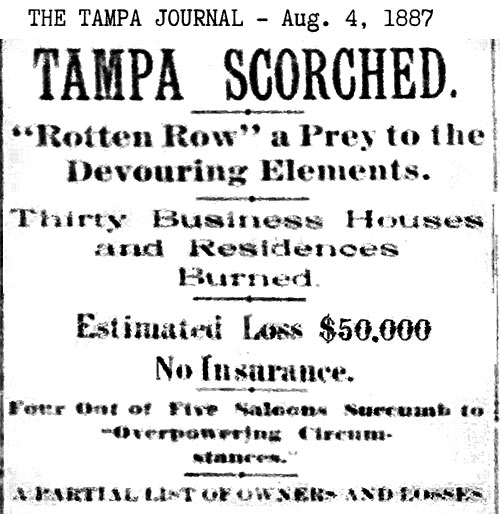 THE FIRE AT "ROTTEN ROW"
on Aug. 4, 1887 THE FIRE AT "ROTTEN ROW"
on Aug. 4, 1887
About two o’clock this
morning a fire broke out
near the center of what is
known as “Rotten Row,”
composed entirely of one and
two story wooden buildings,
and occupied mostly by small
tradesmen such as fruit
stalls, retail groceries,
barber shops, etc. on one
side of the street, and
principally by saloons on
the the other.
The fire
seems to have originated
either in Cole’s restaurant
or Thomas’ barber shop, the
flames spreading rapidly
each way from the starting
point and soon enveloping
the entire block in flames.
It was some time before any
kind of effort could be made
to control the fire, and for
a time it looked as though
the whole business part of
the city must surely go, and
the absence of any wind was
probably what saved the best
portion of it. The fire
department, however, soon
got down to business, and by
the almost superhuman
efforts of the firemen the
flames were prevented from
being communicated to the
buildings across Lafayette
street, extending north,
thus saving the Opera house,
Gunn & Seckinger’s large
grocery store and other
valuable business blocks. It
was the prevailing opinion
that nothing could be done
to save the buildings on
either side of Franklin
street between Lafayette and
the ditch, and all the
efforts of the firemen were
directed to preventing the
spread of the flames to the
adjoining blocks, and that
they were successful in this
measure was certainly not
due to the completeness of
our water works system, but
to the untiring efforts of
the people.
Read more detail about this
section including the entire
Rotten Row fire article of the
Tampa Journal (transcribed) as
well as an article about this
fire in the Savannah Morning
News
at the A. C. Wuerpel feature. |
|
|
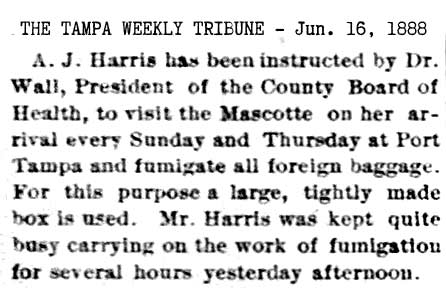
HARRIS CALLED ON TO
DISINFECT BAGGAGE
June 16, 1888 - A.J.
Harris was called on by Dr. Wall to fumigate all foreign
baggage arriving on the Mascotte at Port Tampa.
Fumigation was a method
used in the 19th century to disinfect clothing and
cargo. It was usually used for immigrants and passengers
arriving from foreign countries. Clothing was placed in
an apparatus that produced a partial vacuum, then
superheated steam was introduced, fully disinfecting the
clothing. Afterward, a partial vacuum was recreated to
quickly dry the clothes.
|
The fumigation process was often
destructive, damaging clothing and goods. Some steamship
lines fumigated passengers' baggage with sulfur fumes
for no less than 6 hours.
A rise in
population in Tampa from 750 in 1880 to 5,000 in 1887
was caused by two breakthroughs -- the arrival of Henry
B. Plant’s railroad in 1884, providing a cross-state
link to the North, and the coming of the cigar industry
in 1886, that initiated a tremendous economic
development which totally transformed Tampa from a
sleeping fishing village to a thriving industrial port
city. The Plant Steamship Company’s steamers Mascotte
and Olivette began docking at Port Tampa in June, 1888.
Prior to that time they had to anchor in Hillsborough
Bay, cargoes and passengers being carried to and from
the ship on smaller steamers.
The
Olivette was a 250-foot ship built in Philadelphia under
the supervision of Capt. James McKay, Jr., and launched
February 16, 1887. Captain McKay brought the vessel in
April 29, 1887 [to Tampa] and thereafter served as her
master. The Olivette and Mascotte were named by Plant
after two of his favorite operas.*
The
Mascotte once was a ship of some importance plying
between Port Tampa and Havana. Tampa as a port was of no
importance at that time, but the citizens of the
community had dreams of the day when Tampa would have a
port, and especially of the day when the Mascotte would
steam up the channel to dock in Tampa. That time never
came. Time passed, and with the succeeding years Tampa
became a port, but the Mascotte became old and
worm-eaten, roach-ridden and green with age. She gave
way in the early 1930s to more pretentious ships.
 *Sanchez,
Arsenio M. (1994) "The Olivette and Mascotte of the
Plant Steamship Line," Sunland Tribune: Vol. 20 ,
Article 7. Available at:
http://scholarcommons.usf.edu/sunlandtribune/vol20/iss1/7 *Sanchez,
Arsenio M. (1994) "The Olivette and Mascotte of the
Plant Steamship Line," Sunland Tribune: Vol. 20 ,
Article 7. Available at:
http://scholarcommons.usf.edu/sunlandtribune/vol20/iss1/7
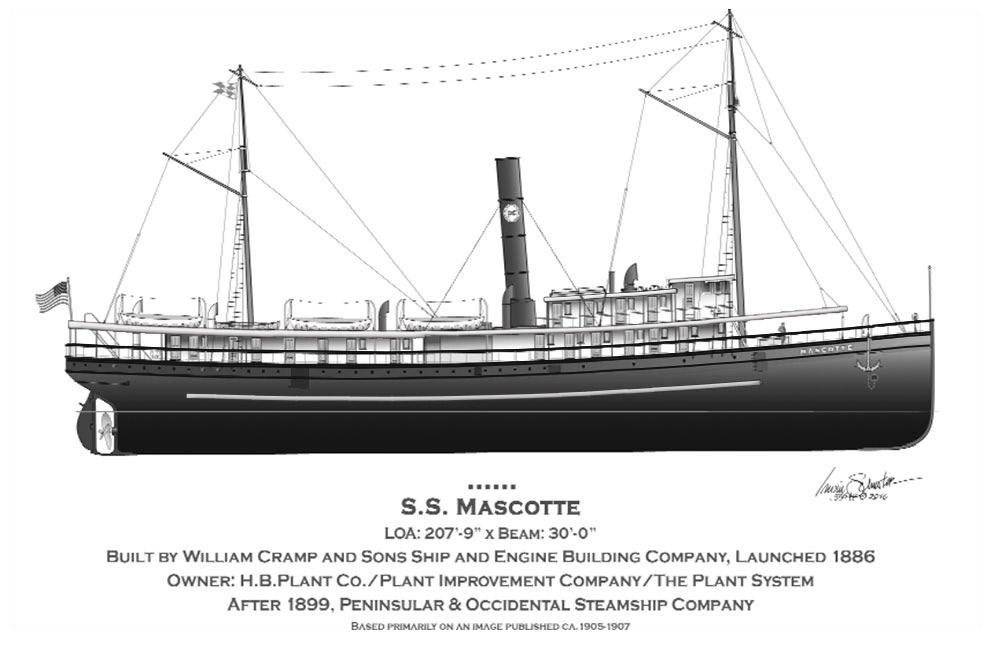
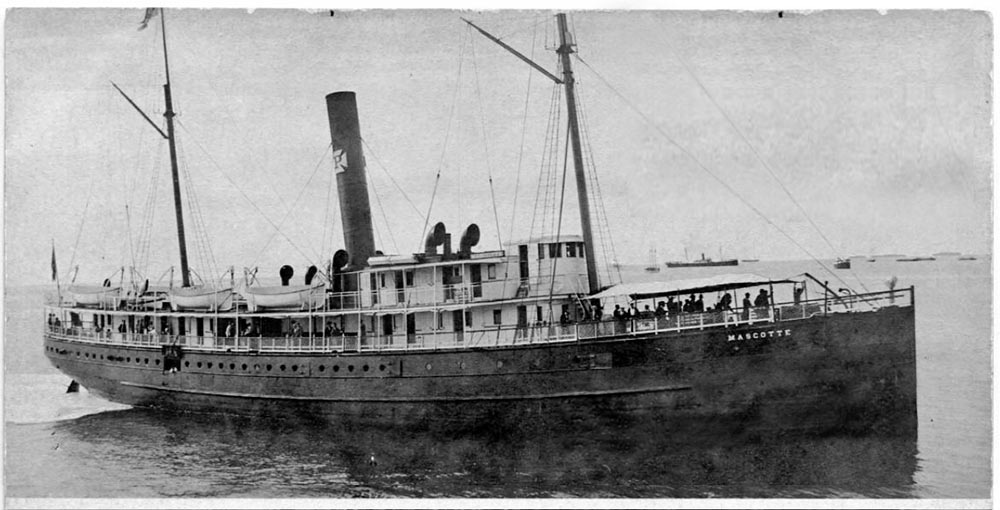
Mascotte images courtesy of
SS Mascotte of the Plant Line, 1885-1931 by
Irwin Schuster, where an interesting history of the Mascotte
is presented and how it came to be
misrepresented on the City of Tampa seal. A historically
inaccurate representation of the Mascotte appears on the
City of Tampa's seal, as well as the on the City of
Mascotte, Florida's seal. See
SS Mascotte of the Plant Line, 1885-1931 by
Irwin Schuster where these images of the city seals and
the SS Mascotte appear.


|
|
|
|
THE
VOLUNTEER FIRE DEPARTMENT IS ESTABLISHED BY CITY
ORDINANCE NO. 40, April 22, 1889
While
plans were being made to build a new city hall/fire
department headquarters at Lafayette St. and Florida
Ave, the city council passed ordinance No. 40 on
April 22, 1889 authorizing the establishment of a
volunteer fire department.
See this
ordinance in its entirety in the feature about
A. C. Wuerpel.
HARRIS
APPOINTED FIRST ASSISTANT TO CHIEF WUERPEL
On May 5,
1889, A. J. Harris was appointed by City Council as First
Assistant to Chief Augustus "Gus" C. Wuerpel of the
volunteer department, with Manuel Rodriguez as second
assistant.
HARRIS
RESIGNS FROM ALERT HOSE FOREMAN POSITION
A.J.
Harris resigned as the foreman of the Alert
Hose Co. so he could take the position as
First Assistant Fire Chief. Jeff Pierce was
elected to fill Harris's position as
foreman.
|
|
Karl Grismer in his History of Tampa,
1959, makes an
erroneous
statement concerning the appointment of
Harris as chief of the fire department, as
does D.B. McKay in Pioneer Florida:
On May 18, 1889, A. J. Harris was
appointed chief and competitive fire drills
were held regularly. An electrical fire
alarm system was installed December 9..."
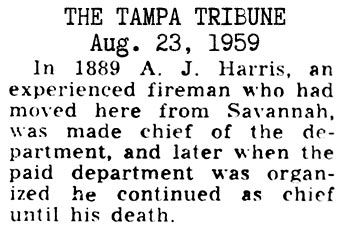 In
the Aug. 23, 1959 Tampa Tribune, D. B. McKay
recounted his memories of the volunteer fire
department in a Pioneer Florida column
"Chief Soaked in Jackson Street Ditch
Water." About halfway through the
column, McKay made the same erroneous
statement as you see at right. No
surprise since D.B. McKay was
Grismer's editor. McKay's memories at
that point were 70 years old. In
the Aug. 23, 1959 Tampa Tribune, D. B. McKay
recounted his memories of the volunteer fire
department in a Pioneer Florida column
"Chief Soaked in Jackson Street Ditch
Water." About halfway through the
column, McKay made the same erroneous
statement as you see at right. No
surprise since D.B. McKay was
Grismer's editor. McKay's memories at
that point were 70 years old.
It wasn't
until after Wuerpel's resignation in June of
1890 that the city appointed Harris as
Acting Chief to lead the department and
improve training.
NO. |
|
FIRE CHIEF AND ASSISTANTS
OFFICIALLY ELECTED BY FIREMEN
On May
29, 1889, as set forth in Ordinance No.
40, elections were held by the six fire
companies around the city to select
their chief. A. C. Wuerpel was chosen over
G. R. Macfarlane by a margin of 67
votes. A. J. Harris and Manuel
Rodriguez were elected as first and
second assistants, respectively,
with no opposition.
See the individual vote counts
and more detail about this
period at the feature on A. C.
Wuerpel |
VOLUNTEER FIRE DEPT.
SHOWS ITS SKILL AT A FIRE DRILL
DEMONSTRATION
On
July 4, 1889, Tampa held a
demonstration of its volunteer
fire department's proficiency by
presenting a competitive fire
drill to the people of Tampa.
The
department was comprised of
these 6 companies for a total of
196 men, with A. C. Wuerpel as
Chief, Andrew Harris as First
Assistant Chief, and Manuel
Rodriguez as Second Assistant
Chief.
Read about this event in detail
and see the entire July 11, 1889
Tampa Journal article at the feature about A. C.
Wuerpel. |
|
On
July 11, 1889, the Tampa
Journal reported that Jeter &
Boardman had contracted for 17 additional fire hydrants,
seven hose reels were ordered,
City Council advertised for
lots around the city on which to build brick hose and reel
houses, and Chief Wuerpel was
instructed to determine the cost
of an electric fire alarm
system. |
|
On July 17, 1889, Chief Wuerpel asked for another hose
reel, and a report by the Council Special Committee recommended
recommended the purchase of the old Stringer house property on
which to build a new city hall. |
|
On
August 1, 1889, the Tampa Journal reported that
a communication was received from the Chief of
the Fire Dept. in regard to the cost of an
electric fire alarm system. It was referred to
the committee on Water Works and Fire Dept. for
immediate action. |
|
Around
this time, Chief Wuerpel decided to devote more time and
attention to his businesses as its increasing demands
required it, so he tendered his resignation to the council. But due to the Council's
"earnest solicitation" he not resign. Wuerpel consented
to remain and continued to finish the work at hand.
[A. C. Wuerpel resignation
letter of Jun. 10, 1890] |
|
In
mid-August, 1889, Chief Wuerpel visited Savannah
to take a look at their Gamewell electric fire
alarm system which he planned to recommend for
use in Tampa.
Wuerpel received cost propositions from
Gamewell, but the lowest one was still $700 over
what had been appropriated for it. He planned
to leave for New York the next day to see if he
could get a better deal. |
|
Sept. 13, 1889
- While Chief
Wuerpel was away in talks with the Gamewell
Company in New York, Asst. Chief Harris filled
in as Acting Chief in a meeting of the Board of
Fire Wardens. |
|
After considerable delay, the
alarm system arrived but there was another delay to
installing it until the present council authorized Chief
Wuerpel to build it as he deemed best. The city having
limited funds for that purpose, he spent as little as
possible on terms that payment not be made in full to the
seller until the system was installed and working properly,
which meant that any delay in its installation was no
expense to the city.
Below is a Burgert
Brothers re-photograph of one that appeared in
the mid-winter special edition of the Jan. 21,
1900 Tampa Tribune. The tower is often referred
to as a "cupola" and it initially was
to house the
fire alarm bell for this district. To the left
of City Hall can be seen a portion of of the
gable of the Stringer house. The horses and
wagons on Florida Avenue appear to be the Tampa
fire department or this may be a funeral
procession.
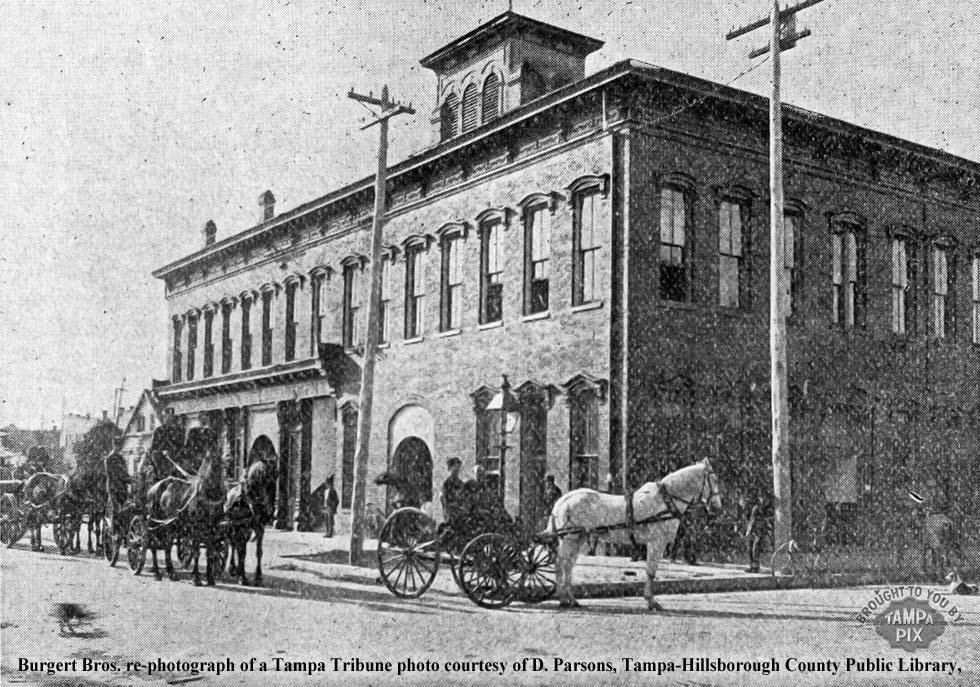
The disastrous
fire of Oct. 28, 1889
Firemen blame insufficient water pressure for
the spread of a disastrous fire at a Tampa
Heights cigar box factory,
lumber mill, and the round house of the street
railway.
Jan. 29th, 1890 - Annual Parade
of the Fire Department
The
fire companies participating at this time were:
Mirta Hook & Ladder No. 1, Alert Hose Co. No. 1,
Resolute Hose Co. No. 2,
Active Hose Co. No. 3, Phoenix Hose Co. No. 5,
Vigilant Hose Co. No. 6, Relief Hose Co. No. 7,
Union Hose Co. No. 8,
and Humanity Hose Co., No. 9.
The question of placing the
tower in the 1st Ward caused
further delay. The Chief
wanted a separate tower next to
the new city hall currently
under construction, but the
Board of Public Works wanted and
ordered the bell hung on top of
the city hall, and so he was
forced to wait until completion
of that part of the building.
April 3, 1890 - Fire Chief Wuerpel wanted to
have a tower built for the fire alarm bell on
the city hall construction site instead of
placing it in a cupola on top of the building.
April 30, 1890 - The fire alarm system was
connected to the battery and was being tested by
Chief Wuerpel and his assistants.
Just when the new city hall
was being completed and Wuerpel was told all was ready for
installation, disagreements arose between Wuerpel and the
Board of Public Works over the weakness and lightweight
construction of the building's cupola, and where to locate
the fire alarm bell because of it, but the Board of Public
Works disagreed and said it was of sufficient strength.
(Poor construction of the cupola would come back to bite the
Board in nine years.)
The bell
apparatus was installed and by then, other
portions of the system had been completed,
except for the cable across the river which had
not yet arrived.
Wuerpel tested
the system and it worked perfectly, but due to
the "natural stiffness of the new
machinery and owing to the weakness of the
timbers in the City Hall cupola, a part of the
striking machine broke and caused further delay
until it could be fixed."
Read a detailed description of
the Gamewell electric fire alarm
system at the Wuerpel page.
The Board of Public Works did not agree with Wuerpel's
assessment to install a separate bell tower adjacent to the City
Hall building. City Council clarified that this was not their
decision, but that of the Board of Public Works: "The Board refused to allow the city hall to be
mutilated by attaching a tower for the alarm bell, and providing
a place in the cupola for it is all that the Board had to do
with it."
Read about the history of the
Gamewell electric telegraph
alarm systems.
Now by this time, a new city
council had taken office due to a recent election (March 1889), to which the
Chief requested the passing of an ordinance to protect the new
system so as to prevent "idle and malicious interference with
it, and authorizing the employment of a competent electrician"
to maintain the new system, which by then needed prompt
attention.
Wuerpel recommended George E.
Will, the former first assistant chief of the Jacksonville fire
department who installed the Jacksonville system under Wuerpel's
instructions, being fully competent. He recommended a yearly
salary of $720 which would save the city money considering the
cost of fixing a deteriorating system left to neglect or
improper care.
Chief Wuerpel's request was
referred to the Committee on Water Works, etc, who returned it
with a recommendation that a reliable man be appointed to
superintend the system. The decision was laid over and
Councilman George E. Harris recommended Robert Mugge's electrician, C. C.
Radabaugh, who
would "put the alarm in perfect working order for $25 and keep
it in good working order for $20 a month." Robert Mugge,
successful Tampa businessman liquor dealer, was the first in
Tampa to electrically light city streets when he had built and
electric power plant and had electric lamps built around his
home.
Finally, at the most recent meeting of the city
council (early June, 1890), the council received and accepted a bid
from C. C. Radabaugh who up until that time had no
connection to the fire department, to take charge of
the alarm system without any reference to Chief
Wuerpel having any more control of it.
FIRE CHIEF A. C. WUERPEL RESIGNS -
June 10, 1890
Much information about
the early history of the volunteer fire department
previously described comes from this letter.
See it in its entirety at
the feature on A. C. Wuerpel.
In his resignation letter of June
10, the Chief expressed his opinion of keeping the fire alarm
system under the supervision and authority of the Fire
Department, and because he previously consented to stay on board
to complete the installation of the alarm system, a work now that was now taken out
of his hands, "I saw plainly that the present council was not in
harmony with me in my efforts to foster and uphold the Tampa
fire department and in consequence, and being rendered useless
to the department, I resigned."
[End of repeated events from A.
C. Wuerpel feature.]
|
|
|
Upon Wuerpel's
resignation, A. J. Harris was appointed Acting
Chief.
|
|
STATE FIRE
DEPARTMENT CONTEST, JUNE 17, 1890
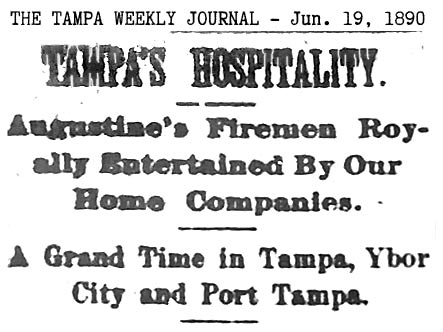 On
June 17, 1890, the various companies of
the Tampa volunteer department competed
against the Ponce de Leon company of St.
Augustine. This
Tampa Journal article published
Thursday, June 19, 1890 describes the
St. Augustine's firemen's arrival in
Tampa on Monday, June 16 and the TFD
festivities held in Tampa on Tuesday,
June 17, 1890. It is filled with
details of the numerous contests between
the volunteer fire companies and the
celebratory atmosphere that prevailed in
Tampa. On
June 17, 1890, the various companies of
the Tampa volunteer department competed
against the Ponce de Leon company of St.
Augustine. This
Tampa Journal article published
Thursday, June 19, 1890 describes the
St. Augustine's firemen's arrival in
Tampa on Monday, June 16 and the TFD
festivities held in Tampa on Tuesday,
June 17, 1890. It is filled with
details of the numerous contests between
the volunteer fire companies and the
celebratory atmosphere that prevailed in
Tampa.
Read
the entire article, click it after it
opens to see it full size.
|
|
Excerpts
from the article:
The St.
Augustine Fire Company arrived on Monday
night by mail train. They were met at
the depot by various hose companies of
the city and escorted to the Booz
House where they were staying. The
parlor and halls of the hotel soon
thronged with jolly fire laddies.
Supper was announced and all filed into
the long dining room making a notable
showing of good looks and muscle. The
evening's entertainment closed with an
address of welcome by City Clerk Lamont
Bailey. Response of appropriate words
followed by the Chief of the St.
Augustine Fire Dept. John H. Dowd.
(Contest article continues after Booz House detail below.)
|
THE BOOZ HOUSE (Not from
the article)
The old Palmetto Hotel
on Franklin St. went up for
sale on Jan. 3, 1889 and
took nearly a
year-and-a-half to sell.
In
the meantime, J. W. Booz
became manager of the hotel
in early 1890 and would
continue as the manager
after its sale to Capt. R.
F. Webb for $10,000 was
announced May 1, 1890.
(In 1912, Tampa City Council
wanted to purchase the
property to build Tampa's
new City Hall. The
sale price was $145,000.) |
| |
|
|
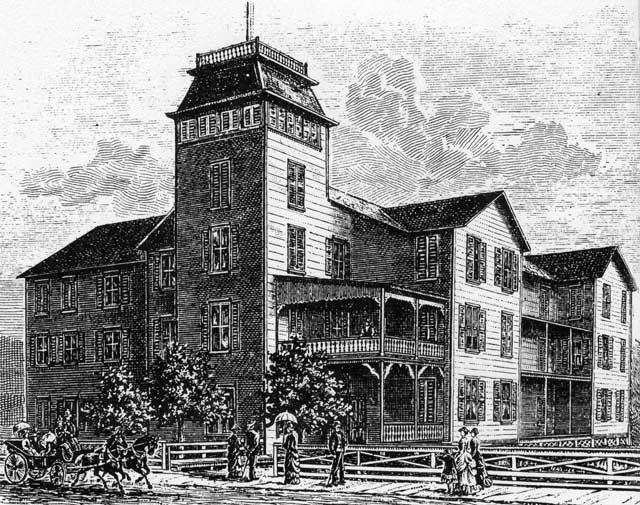
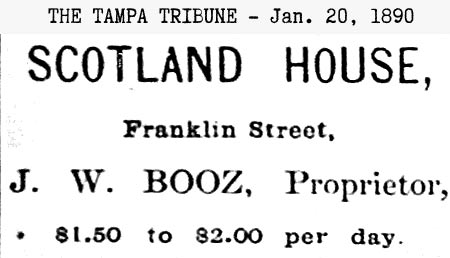 |
 |
|
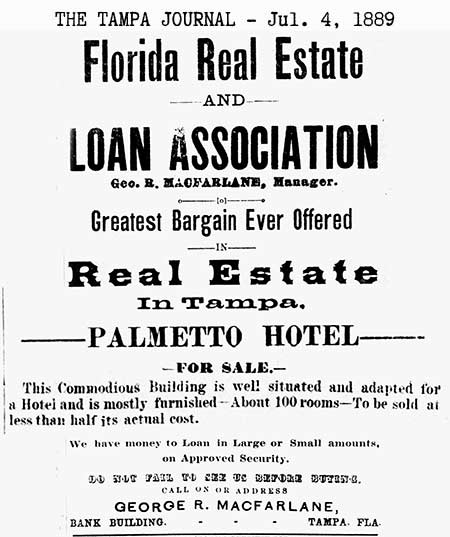 |
| |
|
|
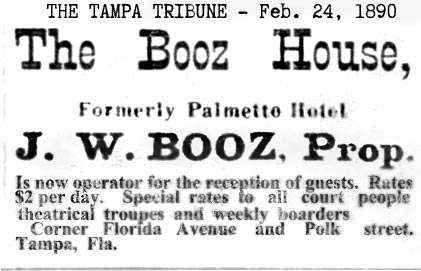 |
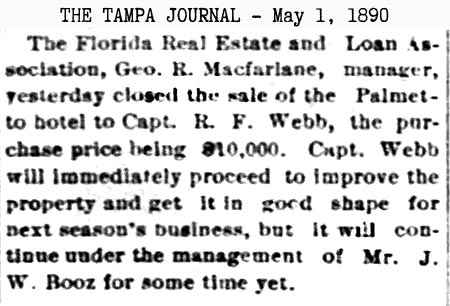 |
| |
|
STATE FIRE
DEPARTMENT CONTEST continued
Tuesday's contest: By 7 a.m., various
Tampa fire companies were assembling at
their reel houses. Everywhere in the
streets, groups of people were forming
to watch the events. By 9 a.m. the
streets were crowded along Lafayette
between Franklin and Ashley. It was a
sunny day. Shortly after 9 a.m. the
judges and timekeepers took their
places.
The
Alert hose company was the first to
run. On their first run a kink in their
hose kept them from attaching the nozzle
correctly and they failed to hit the
flag with their first try. They made a
2nd attempt and their total time was 45
seconds. The Resolute hose company was
next. They hit the flag without mishap
at 35 seconds. The Ponce de Leon
company of St. Augustine was next,
comprised of 17 men. Their time was 47
seconds. The Humanity company was
next. It was comprised of "our Cuban
citizens from the Fourth Ward." "Our
nimble-footed Castilian citizens made an
astonishing run." Their time was 41
seconds. The Invincibles was next.
They were comprised of the juvenile
company of Tampa; boys from age 10 to 13
residing in the First Ward. They were
given a half-distance starting point
"amid laughter and cheer of the crowd."
They passed the hydrant at 30 seconds
and the timekeeper "lost the record" and
the exact time wasn't kept. Spectators
marked their time at 40 seconds but the
exact time wasn't kept. The "kids" were
highly elated at their record.
Round
after round of cheers was given by all
for the victorious Resolutes. The
crowds dispersed at 11 a.m. and all
boarded the train for a trip to Ybor
City.
On
arrival in Ybor City, they formed in a
line in this order. Chief of Police,
Squad of Police, Secretary Lamont Bailey
and Second Assistant Chief Barbentine
[Balbontine], the Ancient City Coronet
Band, the Chief of the St. Augustine
fire department and foreman of the Ponce
de Leon Company, the Ponce de Leon Fire
Company, the Tampa Companies: Resolute
Hose Co., Humanity Hose Co., Phoenix
Hose Co., Alert Hose Co., and Mirta Hook
and Ladder Co.
Marching to the music of the band, they
paraded to Station No. 2 of the Tampa
Fire Dept. where refreshments were
served and a speech made by Acting
Chief A.J. Harris. Secretary of the
Fire Department Lamont Bailey introduced
George T. Chamberlain, Chairman of the
Committee on Water Works and Fire Dept.
of the former Council and "as the man to
whom the City is largely indebted for
its present ample and efficient
protection against fire." Some "laddies
indulged in private contests on the
ladders" and a good time was had by all.
At noon
the march resumed to the reel house of
the Relief Hose Co. for the inspection
of the apparatus. Then they boarded the
12:30 train and returned to Tampa for
dinner. [We call it lunch now.]
Picnic
at Port Tampa - Firemen and their
guests, along with the Ancient City
band, took the Tuesday 2:30 train to
Picnic Island where refreshments were
served: coffee, sandwiches, ice cream,
cake and lemonade. Sea bathing,
swinging and informal dancing was
"indulged in by the care-free throng.
Hammocks provided by the managers of the
island were in constant use, and the
shady grounds proved a pleasant
retreat."
The
Firemen's Ball - It took four coaches on
the 7:30 p.m. train to take the firemen
and their lady friends to the grand ball
in the pavilion at Picnic Island.
Programs for the ball had been made in
advance by the Ponce de Leon Fire Co. of
Jacksonville. Well-arranged and carried
out to the letter, the band furnished
excellent dance music. The refreshment
saloon adjoining the dance hall was
liberally patronized throughout the
evening.
At
10:30 the crowd was startled by the
sudden illumination of the grounds with
colored lights which created a magical
and weirdly beautiful effect arranged by
the managers of the island. The
lights
then faded leaving the area in relative
darkness.
The
next morning, Wednesday at 7:30 a.m.,
the Ponce de Leon's were escorted by
officers and members of the Tampa
companies to the train and bid them
farewell. The St. Augustine fire chief
called his men into line and thanked
them, then was followed by three cheers
and a tiger three times over in honor of
the Fire Chief and officers, then for
our bonny fire laddies and lastly for
the Mayor and citizens in general from
whom they had received many courtesies.
Words of praise were given for the
generous entertainment provided.
|
ACTING
CHIEF HARRIS ANNOUNCES BID FOR FIRE CHIEF
On June 26, 1890, the Tampa Journal
announced "Mr. A. J. Harris who has
tendered his resignation as assistant
chief of the fire department explains
that it is not to take effect until his
successor is appointed and qualified.
Mr. Harris further states that he has
resigned the position so that he may be
unencumbered in the race for chief which
he proposes to enter." |
On July 28, 1890, the Savannah Daily
Morning News reported that up until June
30th of that year, the Tampa fire
department has cost $14,174.14.
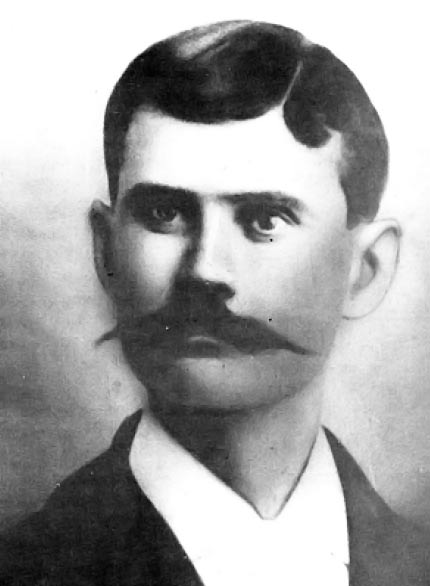 On
August 11, 1890, the new main fire
station of the Fourth Ward (Ybor) was
dedicated. It was for use by the Mirta
Hook & Ladder Co. No. 1 and the Vigilant
Hose Co. No. 6. Present at the
dedication was President of the City
Council, R. H. Webb; presiding, Acting
Chief A. J. Harris, City Clerk Lamont
Bailey, Foreman of the Mirtas-- Francisco
Puglisi, and Acting First Assistant B.
M. Balbontine. The Humanities Hose Co.
was also offered quarters in the main
station, but they declined because they
would have been at the rear of the
building making it "impossible for them
to get out to a fire as quickly as the
Mirtas or Vigilants." On
August 11, 1890, the new main fire
station of the Fourth Ward (Ybor) was
dedicated. It was for use by the Mirta
Hook & Ladder Co. No. 1 and the Vigilant
Hose Co. No. 6. Present at the
dedication was President of the City
Council, R. H. Webb; presiding, Acting
Chief A. J. Harris, City Clerk Lamont
Bailey, Foreman of the Mirtas-- Francisco
Puglisi, and Acting First Assistant B.
M. Balbontine. The Humanities Hose Co.
was also offered quarters in the main
station, but they declined because they
would have been at the rear of the
building making it "impossible for them
to get out to a fire as quickly as the
Mirtas or Vigilants."
Francisco
Puglisi photo
courtesy of The Sunland Tribune,
Journal of the
Tampa
Historical Society,
Vol. 3, No. 1 - Nov. 1977, Hampton Dunn,
editor,
"The
Italian Heritage in Tampa" by Tony
Pizzo.
A. J.
Harris - Acting Chief
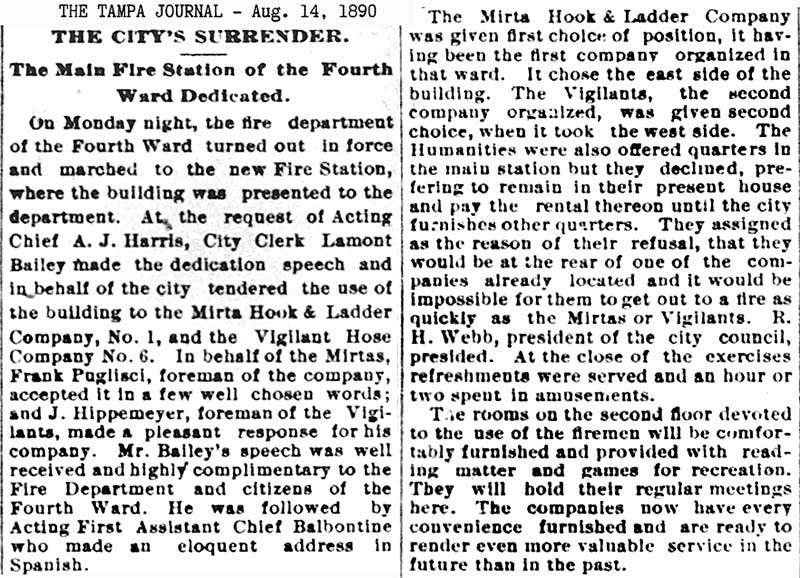
|
|
Thomas C. Taliaferro, 2nd elected chief
of the Tampa volunteer fire department
In a
special
election held on Aug. 29, 1890, T. C.
Taliaferro was chosen as Fire Chief over
C. E. Harrison, and B. M. Balbontine was
chosen as First Assistant Chief over A.
J. Harris. It isn't known why
Harris ran for Asst. Chief instead
of Chief, but judging from the vote
tallies, it appears that the voting was
restricted to fire department personnel. Other matters handled at this
session of the City Council meeting have
been edited out.
|
|

|
 |
|
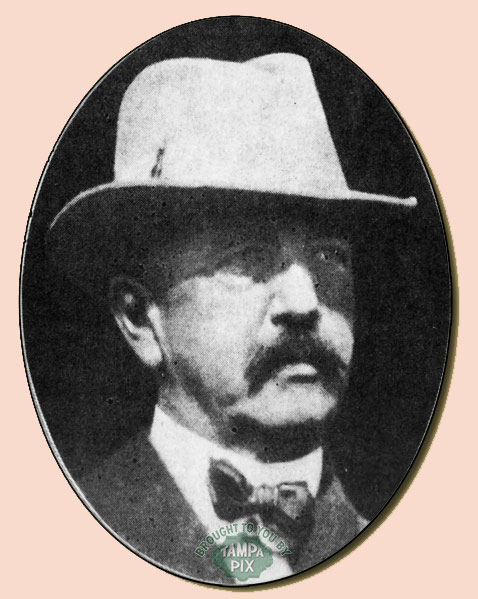 |
|
Thomas Carson
Taliaferro
From a Jan. 3,
1993 ad about
the merger of
First Florida
Bank with
Barnett Bank, in
Florida Today
(Cocoa Beach)
|
THOMAS CARSON TALIAFERRO
2nd elected Chief of the
Tampa volunteer fire
department
(From Karl Grismer's History
of Tampa - Biographies pp,
337-338)
Thomas Carson Taliaferro was
born July 19, 1859 at Orange
Courthouse. Va. When a young
man he went to Jacksonville,
engaged in the lumber
business, and then joined
the banking firm of Ambler,
Marvin & Stockton, the
oldest bank in East Florida.
In the fall of 1885 members
of the banking firm founded
the Bank of Tampa and Mr.
Taliaferro came here to
become cashier of the
institution, the first bank
Tampa ever had.
On May 6, 1886, the bank
received a national charter
and its name was changed to
the First National Bank.
Mr. Taliaferro served as
president of the bank from
1903 to January, 1927 when
he was made chairman of the
board. He was directing
head of the bank for 47
years.
In his younger years he was
active in sports and often
umpired baseball games in
Tampa. He also served as
chief of the volunteer fire
department. In later life he
devoted his full time to
banking and succeeded in
making the First National
one of the leading banks of
Florida.
T.C. married in Tampa to
Stella Morrison, daughter of
William A. Morrison and
Elizabeth Hinton, whose
homestead was known as the
Morrison Grove.
T. C. Taliaferro died April 11, 1928 in
Baltimore, Md. He was
survived by his widow and
five children: Edmund
Pendleton, William M.,
Thomas C. Jr., Mrs. M. B.
(Stella) Withers, and Mrs.
Andres Iglesias. He was
also survived by two
brothers, the former U.S.
senator James Pendleton
Taliaferro of Jacksonville,
and W. R. Taliaferro of
Charlotte, N.C, and a
sister, Lucy Taliaferro, of
Orange Courthouse, Va.
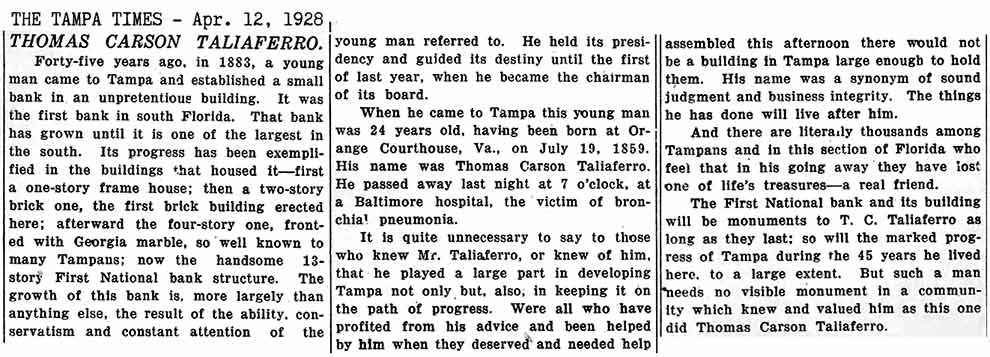
The photo below can be found
numerous times on the web
with white lettering
on the front facade sign
board, "First National Bank
of Tampa." In Tampa Bay
History Magazine, journalist
Hampton Dunn states that the
structure was located on
Washington St. near Franklin
St. and that an early-time
photographer painted the
"First National Bank of
Tampa" lettering on the
negative (white lettering on
the print indicates black
lettering on the negative.)
This was the first home of
The Bank of Tampa, but the
photo was taken LONG after
they vacated it. In fact,
the Bank of Tampa did not
become the First National
Bank until they moved into
their third location, a
4-story bldg. at Franklin
and Madison St. around
1900--evidence that the
photo was taken after 1900.
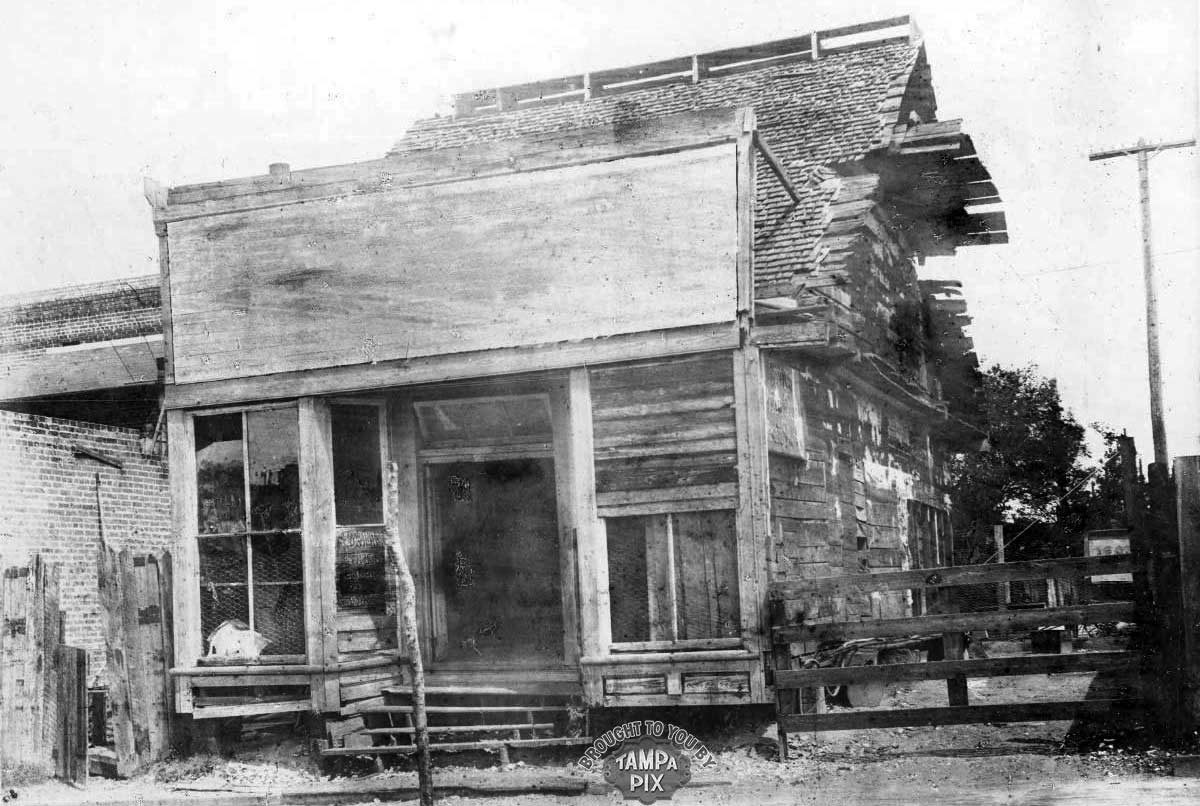
See the bank's 2nd location,
the first brick building in
Tampa, at the feature about
Fire Chief A. C. Wuerpel
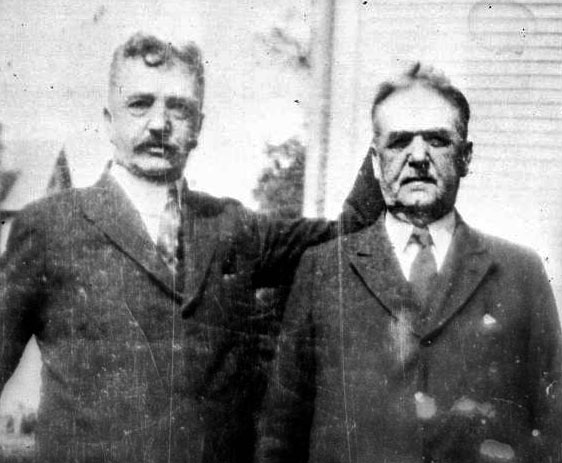
Thomas
Carson Taliaferro, Sr. and
his brother, U.S. Sen. James
Pendleton Taliaferro. Circa
1920s.
Photo courtesy of State
Archives of Florida, Florida
Memory project.
In 1883, Henry B. Plant
began building his South
Florida Railroad and Tampa
started booming as it had
never boomed before. And
because of the boom, Tampa
got its first bank, an
affiliate of Ambler. Marvin
& Stockton, of Jacksonville,
the oldest bank in East
Florida. The senior member
of the banking firm, David
Griffith Ambler, had close
connections with Plant and
knew that the South Florida
would be completed. So did
Ambler's business associate,
James P. Taliaferro, and his
bank partners, John L.
Marvin and John N. C.
Stockton. The four men
agreed that, with the
railroad in sight, Tampa was
a city with a future, and
they joined forces to
establish Tampa's first bank
which they named the Bank of
Tampa. It was opened Nov. 3,
1883, in a small building on
Washington Street, with Thomas
Carson Taliaferro,
younger brother of James
Taliaferro, as cashier. The
first day's deposits totaled
$5,636. (From
Karl Grismer's History of
Tampa, p. 306)
When Vicente Martinez Ybor
purchased the first 40 acres
in what became Ybor City,
Ignacio Haya allowed Ybor to
take the first step in real
estate. Once he was
convinced of its success, he
purchased land, forming the
Sanchez and Haya Real Estate
Company. Haya then
constructed a two story
wooden factory at the corner
of Seventh Avenue and 15th
Street. During construction,
he visited a local Tampa
banker, Thomas Taliaferro,
to inform him that he and
Sr. Ybor need an institution
of credit to facilitate the
transactions involving
purchases, sales,
collections, and wages for
their employees. At the
time, the business of the
bank was so slim, the young
cashier in charge, T.C.
Taliaferro, came within a
hair of leaving town. In
fact, he’d already packed
the fixtures and was ready
to return to Jacksonville
when the good news came. At
first, Taliaferro was unsure
about the success of the
cigar business in Tampa, but
when Haya assured him that
initial salaries would
amount to more than $10,000
a month, Taliaferro now
decided his future was in
Tampa. Thanks to the
influence of Sr. Haya, he
became a successful Tampa
banker, and founder of
today's First National
Bank. (From
The Sunland Tribune, Volume
6, No.1 November, 1980
Journal of the TAMPA
HISTORICAL SOCIETY Tampa,
Florida.)
Tampa City Council - August
13, 1885 – August 13, 1886
William T. Haskins,
President, Harry L. Branch,
William Benton Henderson
[two year term], Thomas
Edward Jackson [two year
term], Silas A. Jones, Henry
Laurens Knight, George
Bascom Sparkman, Thomas
Carson Taliaferro [two
year term], Dr. John Perry
Wall [two year term]
Note: The four new members
cast lots at the new
council's organizational
meeting on 8/13/1885 and
determined that William T.
Haskins and Thomas Carson
Taliaferro would serve two
year terms.
From Tampa's City Councils |
|
 Sept.
11, 1890 - THE TAMPA JOURNAL: "Chief
Taliaferro is taking an interest in the
fire companies and is getting the
organization on a business basis, which
demonstrates the fact he is the right
man for the position." Sept.
11, 1890 - THE TAMPA JOURNAL: "Chief
Taliaferro is taking an interest in the
fire companies and is getting the
organization on a business basis, which
demonstrates the fact he is the right
man for the position."
At right:
The quarters for the fire department in
the new City Hall building in the First
Ward were yet to be completed.
See issues with the contractor in the
A.C. Wuerpel feature.
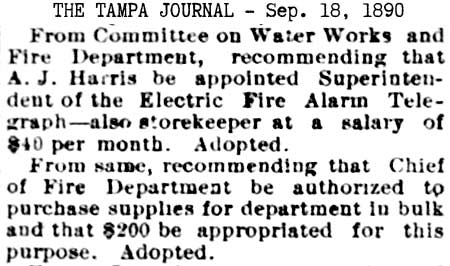 Sept.
18, 1890 - THE TAMPA JOURNAL Sept.
18, 1890 - THE TAMPA JOURNAL
A. J.
Harris was
appointed Superintendent of the Electric
Fire Alarm Telegraph--also storekeeper
at a salary of $40 per month.
Oct.
16, 1890 THE TAMPA JOURNAL
The plasterers are at work in the
firemen's headquarters in the city hall.
The intention is to have the room
completed before the meeting of the
State Firemen's Association.
STATE FIRE ASSOCIATION CHAMPIONSHIP
CONTEST
The
State Fire Association held a
championship contest in Tampa on Oct.
28, 1890. Teams represented were
from Tampa, Key West, and Orlando (who
arrived with two teams.)
The
rules were to be:
-
The board
course as prepared to be
adopted as the course for the coming
contest.
-
Each team could
use any regular fire apparatus they
wanted and each team consisted of
one man for every 75 lbs in weight
of reel, hose-cart and hose.
-
Hose teams run
200 yards from start to hydrant and
shall connect the hose, make 2nd and
3rd couplings, unreel 400 feet of
hose from hydrant and put on pipe to
throw water. The time was
taken when water first flowed from
the pipe.
-
All couplings
were to be made spanner tight.
The
first, third and fourth rules were
adopted, but the second rule was change
to read "Each team shall consist of 9
men and carry the same weight of reel
and hose."
At
least 4,000 spectators were on hand the
following morning for the contest. The
article states "..because they [Orlando]
could not run the convention and make
the rules to suit themselves, they
withdrew." So only teams from Key
West and Tampa participated.
Click article to see larger, then click
it again to see full size.

Contest
Results
|
Team |
City |
Time (MIN:SEC) |
|
Enterprise
Hose #2 |
Key West |
1:32 |
|
Resolute Hose |
Tampa |
None due to
failure to break and make
2nd coupling |
|
Humanity Hose
#9 |
Tampa |
1:42.5 |
|
Lightning
Hose |
Key West |
1:23 |
|
Active Hose |
Tampa |
1:34.5 |
|
Tiger Hose |
Key West |
1:29.5 |
|
Vigilant Hose |
Tampa |
2:10.5 |
|
Young Americans Hose |
Tampa? |
None due to failure to make
1st coupling |
|
Alerts Hose |
Tampa |
1:19 |
|
Key West Hook & Ladder |
Key West |
:49*
|
|
Relief Hose #7 |
Tampa |
1:27 |
*Probably a typo in the article due to
them not winning the cup.
The cup
was awarded to the Alerts of Tampa:
J. T. Brown, Foreman, Will Whaley, Asst.
George Wills, A.M. Sanford, John Moneham,
Will Himes, James Mooney, James Cardy,
R.L. Law.
About the Orlando teams, the article
says,
The Orlando firemen looked fine
as they marched up the streets yesterday
with the championship cup in the hands
of their chief. They are a fine
looking body of men and anyone viewing
them will know at a glance that they are
firemen that will do to depend upon in a
crisis, though everybody acknowledged
that they made a mistake in not taking
part in the state contest.
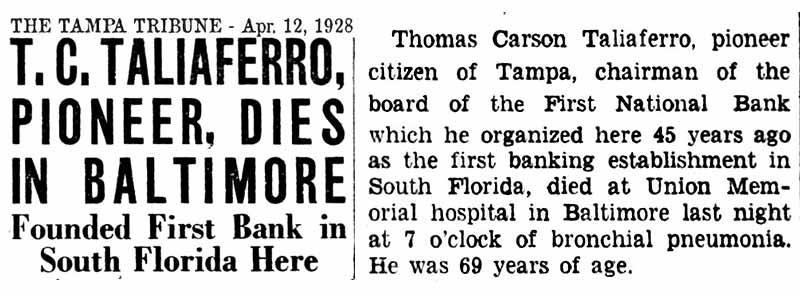 Taliaferro's
obiturary makes no mention of his years
as fire chief. Taliaferro's
obiturary makes no mention of his years
as fire chief.
Read his entire obit, it's all about his
banking achievements.
|
|
Dec. 5,
1890 - The Savannah Daily Morning News
reported that Capt. Dixon presented the
Tampa fire department on Thanksgiving
day with a check for $200 and a
receipted bill for lumber amounting to
$51 in recognition of their services in
saving his mill during the late fire in
Tampa.
MAY 22, 1891 -
TAMPA'S WATER WORKS & FIRE DEPT. PUT TO THE TEST
A representative (Fred
C. Calkins) of the Tariff Association in Atlanta was
in Tampa since May 22, 1891, conducting inspections
of the new Jeter & Boardman water works as to water
pressure and effectiveness for fire fighting.
The Association sets the cost of fire insurance
premiums for cities according to their waterworks
systems. This inspection wouldn't affect
Tamapa's rates because they had already been lowered
to the lowest possible rate two years prior.
A test of the
waterworks and volunteer fire dept. was made on
Monday, May 25th, on Franklin St. around the Almeria
Hotel. Participating were the Alerts No. 1,
Resolutes No. 2, Phoenix No. 5, Humanity No. 9, and
Relief No. 7. And the sound of the fire alarm, the
hoses were switched on and the streams were over 60
feet high. The test lasted around 10 minutes.
Calkins paid the firemen a high compliment saying he
never saw a dept. take more interest in their work
and he was more than pleased. The test was
done entirely with gravity pressure. Of the 6
streams, 4 were full and strong and two not as good
because they came from the dead ends of the mains.
The water was thrown on the top of the Almeria
hotel, a 3-story building and the highest in the
city.
At issue was the fact
that the superintendent of the waterworks, Mr.
Cambpell, said the system would not put direct
pressure into the mains at any time. Mr.
Calkins was surprised at this because every
Jeter-Boardman water system he tested could do so.
The reporter called attention to the fact that
Jeter-Boardman claimed direct pressure was one of
the advantages of Tampa's system. The Journal
intended to call the attention to this matter to the
public.
The stand pipe
pressure is ample and perfectly safe for our
protection in all ordinary fires, but the time
may come when direct pressure will be needed.
Superintendent Cambell claimed that the contract
with the city did not call for it and therefore
has refused to provide it although he has given
it serveral times in the past without injury to
the mains. It is necessary that the contract
should be investigated by the Council and some
definite understanding with the waterworks
company be arrived at in this matter. The
city should have arrangements for direct
pressure if necessity should demand it.
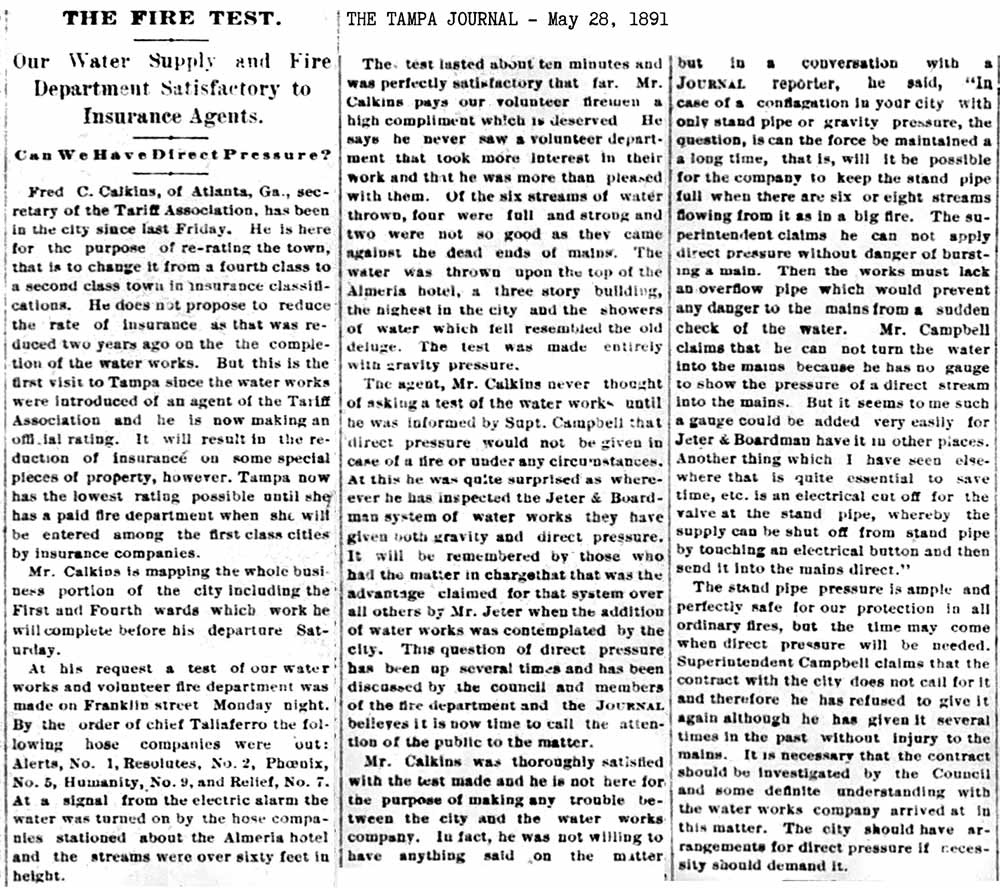
Click on the article to see it
larger. |
|
May 25,
1891 - The city clerk published this
notice to inform the members of the
various fire companies that they will
meet on May 27 to choose a chief and two
assistants. |
On May 26,
1891, Chief Taliaferro requested that
the election include a third assistant
chief. His request was granted. |
|
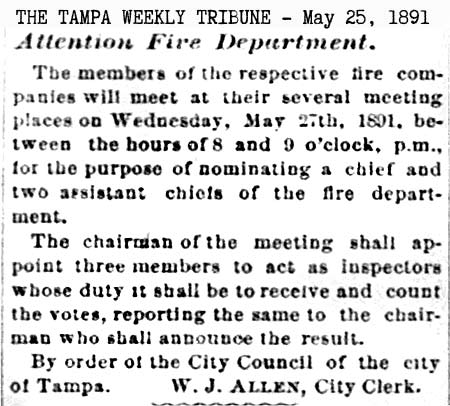 |
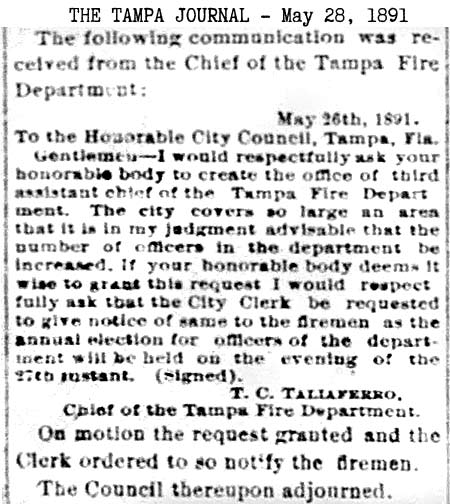
|
|
ELECTIONS FOR FIRE CHIEF - RECAP
In late
April of 1889,
Ordinance No. 40 established a
volunteer fire department. As
provided in the ordinance, the City
Council appointed A. C. Wuerpel
as Chief in early May. The
ordinance also provided for the election
of a Chief by the firemen when at least
four fire companies had been organized.
By the end of May, there were six
companies, so an election was held on
May 29, 1889. A. C. Wuerpel
was elected over George R. Macfarlane,
113 to 46. Harris and
Rodriguez were elected as 1st and
2nd assistants, having run unopposed for
the positions. These were 2-year
terms so their terms would end May
28th, 1891.
However, Chief Wuerpel resigned
in early June of 1890, at which
time A. J. Harris was appointed
as Acting Chief and still served
as 1st Assistant.
Harris
served in those positions until a
special election was held on Aug.
29, 1890 to fill the position of
Chief through May 28th, 1891
(when Wuerpel's term would have ended,
as well as the assistants' terms, Harris
& Rodriguez.)
Although Harris had previously announced
he was resigning as 1st Assistant Chief
while serving as Acting Chief, to run
for the position of Chief, it appears
that he instead ran for First Assistant
again. In that Aug. 29, 1890
special election, T. C.
Taliaferro was chosen as Fire Chief
over C. E. Harrison, 130 votes to 61
votes, and B. M. Balbontine was
chosen as First Assistant Chief over A.
J. Harris, 113 to 77.
So now,
on May 27, 1891, it was time for the
firemen to choose another Chief and
Assistant Chiefs for a 2-year term.
|
|
On May 28,
1891, Chief Taliaferro's term ended
due to having been chosen in the special
election to fill the remainder of Chief
Wuerpel's term. The results of the
regular election were
published, indicating T. C. Taliaferro
was again elected as Chief for a
2-year term in an overwhelming vote over
Otto Kammerer, 493 to 10.
-
1st Asst. - Emilio Pons
over S. J. Bowers, 316 to 184.
-
2nd Asst. - C. W. Ayres over
J. H. Hippenmeier, 334 to 168.
-
3rd Asst. - L. Garcia,
apparently unopposed, with 501
votes.
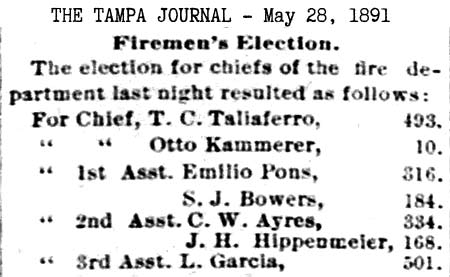 |
On June
8, 1891, A. J.
Harris was elected Vice President of the
Alert Hose Co. .
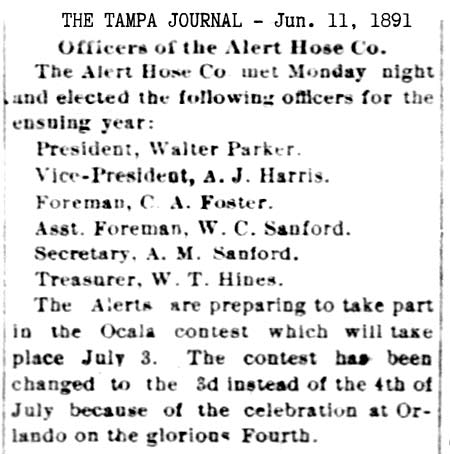 |
|
So Chief
Taliaferro would serve a 2-year term
which should end on May 28, 1893. |
|
Praise for Tampa's Water Works and Fire
Dept., Criticism of its Electric
Utilities
On Aug. 25, 1891, an expert
inspector J. S. Altreds of the Liverpool
& London and the Globe Insurance Co.
gave report to the Tampa Tribune of his
conclusions concerning Tampa's water
works, fire department, and electrical
systems. The water works and fire
department received accolades, but the
city's electric lighting system and
power lines were poorly designed and in
very bad condition.
The
electric fire alarm system telegraph
should have been built in at least 3
circuits. Instead, it was all on one
circuit, so if any part of the system
failed, the whole system failed. One
such failure took place while conducting
his investigation. A storm caused a
power line to fall and cross the alarm
telegraph lines, apparently not
short-circuiting it, but to prevent
damage to the the system, Chief
Taliaferro had to disconnect all the
alarm boxes and bells.
Of the
city's electric light system, he stated:
"Your electric light construction,
if it can be called such, is open to
the severest criticism. Inferior
material has been used, particularly
for outside construction. Wires
have been run in all directions and
are attached to buildings, sheds and
roofs, at the most convenient points
and transformers are also
promiscuously located on buildings,
sheds, roofs and poles. That you
have not had serious accidents to
both life and property is
wonderful. The time is not distant
when the insulation, already so
defective, will become so defective.
will become so entirely worthless
that accidents will be certain to
occur. Your city is also festooned
with dead wires belonging to the
plant discontinued some time ago.
No time should be lost in removing
them as they are a constant menace
to life and property.
He goes
on to describe the dangerous condition
of inside wiring all over the city,
citing as an example the Western Union
telegraph fuse box. In closing, he says
he was impressed with how advanced
Tampa's water works and fire protection
system was compared to other cities, and
had confidence that Tampa would repair
the electric lighting system to
satisfaction.
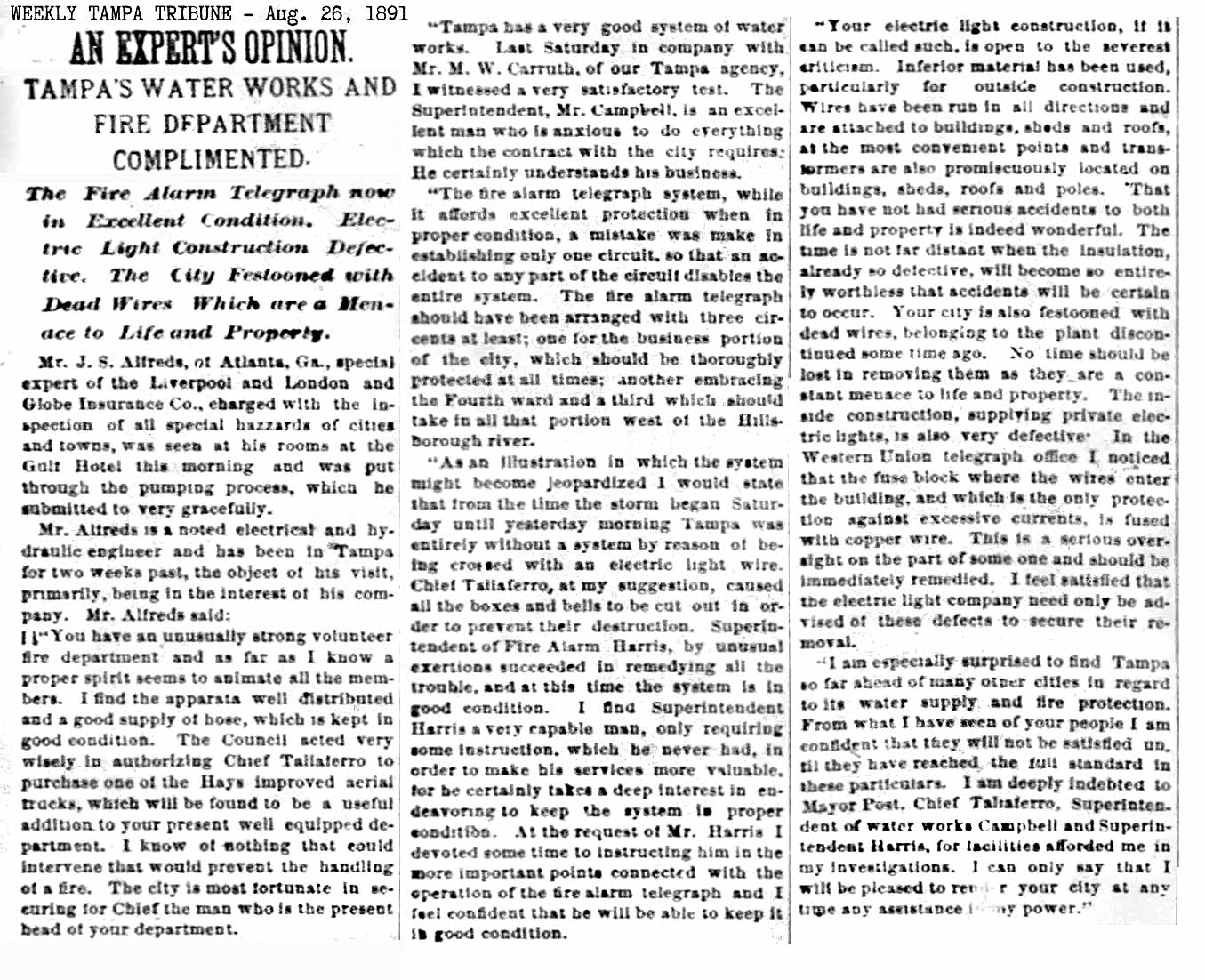
Click the
article to see it larger |
DISASTROUS FIRE IN YBOR CITY
On Nov. 12, 1891, the Sanchez & Haya
cigar factory in Ybor City caught fire.
Firefighters were hampered by alarm and
telephone wires in poor condition, and
low water pressure. Eight fire
companies were on scene but the wooden
buildings burned like match boxes. It
only took half an hour for a small hotel
to burn to ashes.
[Grismer, A History of Tampa, 1959]
Nov. 12,
1891 - A fire breaks out in the
Aurelio Campos restaurant on 7th Avenue,
between 14th and 15th Streets. At the
end destroys two and a half city
blocks
[Cigars
of Tampa]
The
fire consumed 2 hotels, a boarding
house, 4 warehouses, 3 barber shops, a
drug store, 4 restaurants, 6 grocery
stores, 6 dry goods stores, a jewelry
store, a boot and shoe store, and the
market house. The article claims that
all the buildings in the Fourth Ward
were gone, with losses estimated at
$350,000 and only about $125,000
insured.
[Pensacola
News, Nov. 13, 1891]
|
|
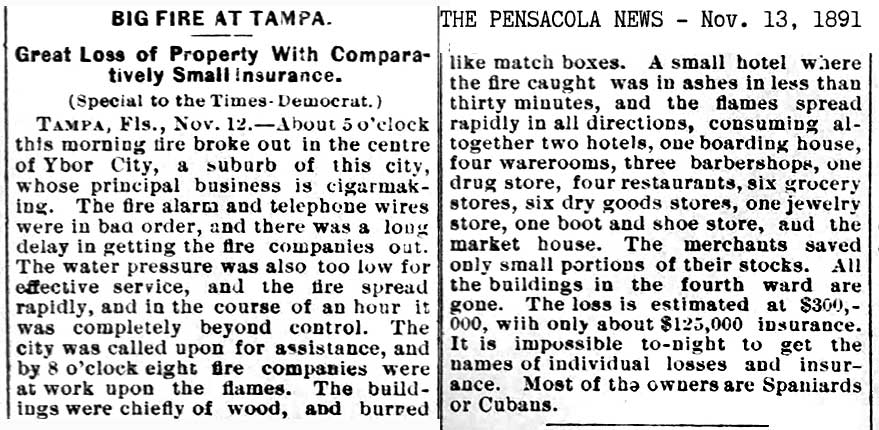 |
| |
During
the fabulous pioneer days of Ybor City
the famed Hotel De La Havana was located
on the corner of 15th St. and 7th Ave..
The three story frame structure was the
first hotel erected in the Latin
Quarter. Its proprietors were Jose Rubin
and Jacinto Olavarria. The hotel was
headquarters for newly arrived tobacco
workers and Cuban political exiles. The
building was destroyed during Ybor
City´s first great fire in November
1891.
[Historic
Markers Across Florida]
|
One of
the restaurants supposedly* destroyed was Las Novedades which was located in the
middle of the block where the red circle
indicates.
*TampaPix has researched the beginnings
of Las Novedades and believes that as a
restaurant, it did not exist until 1899
at the earliest, and that it first was a
bakery only. |
|
Before the Fire
B=Barber
shop, C=Cigar factory, D=Dwelling,
H=Hotel, M=Meat market (circle marks
where Las Novedades cafe was said to
have been located in
1891), R=Restaurant, Rx=Drug store,
S=Saloon,
?="El Bazar" possibly a hotel.
Sanborn
Fire Insurance Map from University of
Florida digital map collection
|
|
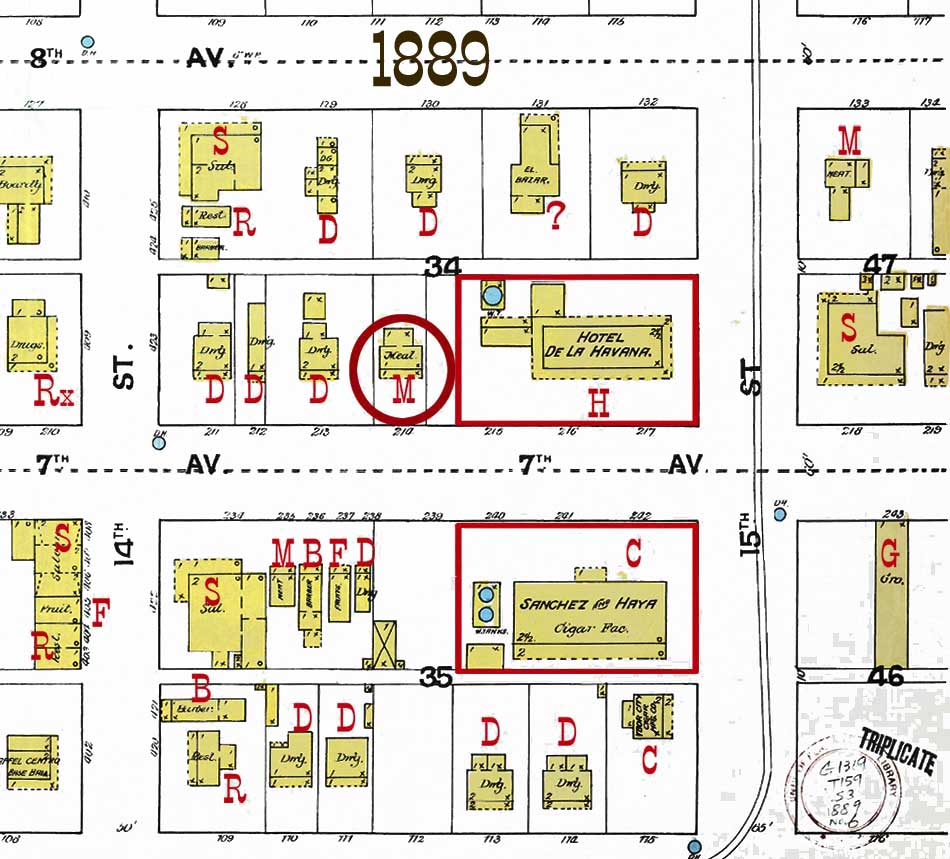 |
| |
TRI-WEEKLY
TAMPA TRIBUNES FOR 1892 ARE MISSING
1891 Tribunes are
correctly dated up to and including Oct. 30, 1891.
Then the months become incorrect:
Oct. 1891 indexed as Nov. 1891, repeating the same
publications for Oct. 1891 but presented as Nov.
1891:

Oct.
2, 1891 indexed as 1891-11-02
Oct. 5, 1891 indexed as 1891-11-05
Oct . 7, 1891 indexed as 1891-11-07
Oct. 9, 1891 indexed as 1891-11-09
Oct. 12, 1891 indexed as 1891-11-12
Oct. 14, 1891
indexed as 1891-11-14
Oct. 16, 1891 indexed as 1891-11-16
Oct. 21, 1891 indexed as 1891-11-21
Oct. 23, 1891 indexed as 1891-11-23
Oct. 26, 1891 indexed as 1891-11-26
Oct. 28, 1891 indexed as 1891-11-28
Oct. 21, 1891 indexed as 1891-11-21
Oct. 30, 1891 indexed as 1891-11-30
Index then
jumps to 1892-04-04 (Years become incorrect)

Apr. 4, 1893
indexed as 1892-04-04
Apr. 11, 1893 indexed as 1892-04-11
Apr. 18, 1893 indexed as 1892-04-18
Apr. 25, 1893 indexed as 1892-04-25
May. 2, 1893 indexed as 1892-05-02
May. 16, 1893 indexed as 1892-05-16
May. 23, 1893 indexed as 1892-05-23
May. 30, 1893 indexed as 1892-05-30
Jun, 6, 1893 indexed as 1892-06-06
Jun, 15, 1893 indexed as 1892-06-15
Jun, 22, 1893 indexed as 1892-06-22
Jun, 29, 1893 indexed as 1892-06-29
Jul 6, 1893 indexed as 1892-07-06
Jul 13, 1893 indexed as 1892-07-06
Jul 20, 1893 indexed as 1892-07-06
Jul 27, 1893 indexed as 1892-07-06
Aug 3, 1893 indexed as 1892-08-03
Aug 10, 1893 indexed as 1892-08-10
Aug 17, 1893 indexed as 1892-08-017
Aug 24, 1893 indexed as 1892-08-24
Aug 31, 1893 indexed as 1892-08-31 (only 1st two
pages scanned)
Dates then
become correct:
Aug 31, 1893
indexed as 1893-08-31 (all 8 pages scanned)
Sep. 7, 1893 indexed as 1893-09-07
Sep. 14, 1893 indexed as 1893-09-14
Sep. 21, 1893 indexed as 1893-09-21
Sep. 28 , 1893 indexed as 1893-09-28
So missing
are the Tribunes from
Nov. 1891 through Dec. 1891
All of 1892
Jan. 1893 through Mar. 1893.
An analysis of Sanborn fire
insurance maps for this period of years shows that the fire
alarm bell was never reinstalled in the City Hall cupola after the
replacement parts arrived. Instead, a wooden structure was
built at the southwest corner of the building to house the
alarm bell, just as Chief Wuerpel had wanted from the time he
voiced his opinion on the weakness of the cupola. (See
1901 photo later below.)
Apr. 18, 1893 -
Jefferson Sanders of the Eagle Hose Co. #10 was
eulogized for his heroism at the Sanchez & Haya fire
of 1891.
No mention is made of how or why he died, and no
other info could be located.
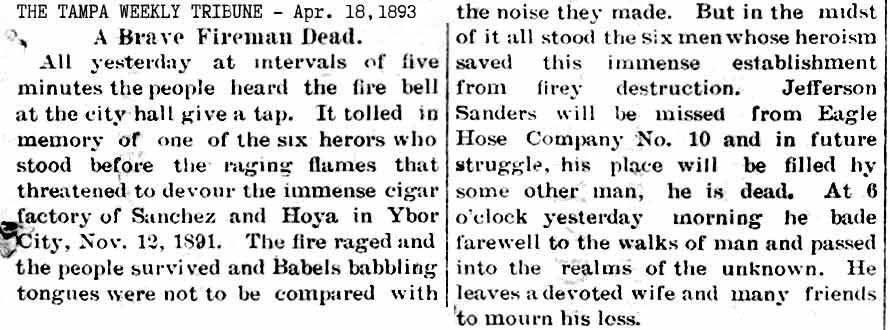
 
April 25, 1893 - Mayor
Salomonson brought up the subject of Tampa
needing a paid fire department and
referred the
reporter to superintendent of the fire alarm system,
Harris.
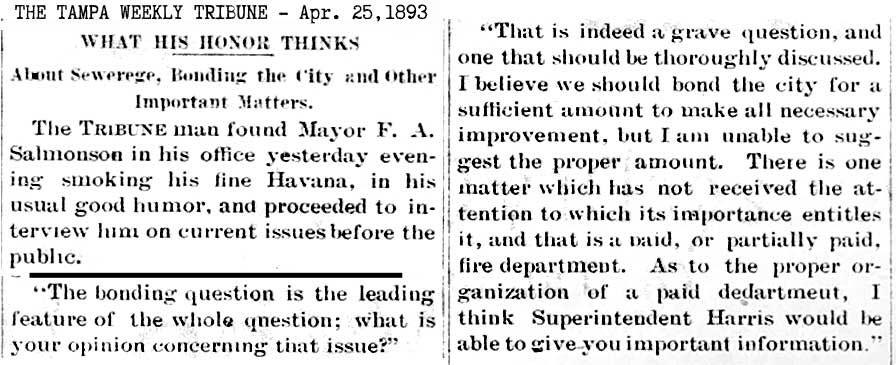
FIRE CHIEF GEORGE RAE MACFARLANE
|
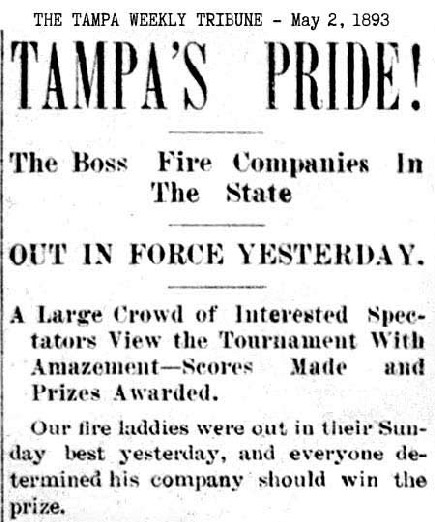
On May 1,
1893, the annual firemen's competition
was held in Tampa.
Read the whole article here, click
the image when it opens to see it full
size.
Companies
competing and their times:
|
Company |
Captain/Foreman |
Time |
|
Humanidad No. 9 |
Casimiro de la Rosa |
0:32.5 |
|
Eagle
Hose No. 10 |
John
Baker |
0:30 |
|
Commercio No. 6 |
Juan
Barose |
0:31.5 |
|
Relief
No. 7 |
Wm. E.
Campbell |
0:29 |
|
Gulf
City No. 13 |
Fred
Lenfesty |
0:30 |
|
Resolute No. 2 |
J. H.
Miller |
- |
|
Invincibles No. 11 |
Alge
Lee |
0:31 |
Judges: L. Ransdale, W.J.
Dombrowsky, B. M. Balbontin, M. L.
Sanchez, J. C. McNeill, and R. R. De
Armas. Herman Glogowski was the
starter for the first run then J. C.
McNeill took over as starter for the
rest of the contest.
|
Of
interest in this article is that George
A. Macfarlane who was present at
the contest was referred to as
Chief. This was actually George R.
(Rae) Macfarlane, a cousin of Hugh
Macfarlane. (On May 29, 1889, A.
C. Wuerpel was chosen for volunteer
dept. Chief over G. R. Macfarlane by a
margin of 67 votes.)
Also
present was A. J. Harris who was
referred to as Superintendent, which
would be his position in charge of the
fire alarm system.
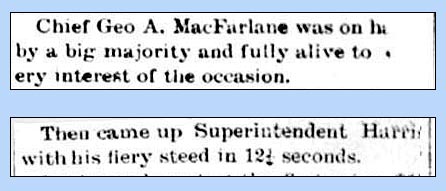
Assuming
Chief Taliaferro served the allotted
2-year term as Ordinance 40 had provided
for, his regular election on May 27,
1891
would have ended May 27, 1893.
So why does this May 2, 1893 article
refer to George Macfarlane as Chief?
If Chief
Taliaferro was out of town at the time,
then his First Assistant Emilio Pons
would have stood in for the Chief.
Macfarlane was neither 1st, 2nd or 3rd
assistant.
If during
Taliaferro's 2-year term the City
Council changed the fire chief term to 1
year, Taliaferro should still have
served out his 2-year term.
The
missing Tampa Tribunes from Nov. 1891
through Mar. 1893 would likely answer
this question.
George Rae
Macfarlane was a first cousin to Hugh. George R. Macfarlane
was the only son of Andrew
Macfarlane and Margaret Rae.
Andrew was son of Thomas, who was also
grandfather of Hugh. George
emigrated to America in 1887, and was in
the real estate business at Tampa. He
first married Susan B. Gaunt. His
censuses in Tampa indicate that he was
born in Scotland in 1862; thus was about
11 years younger than Hugh. According to
his great-granddaughter, he came to
Tampa because he had family here
already. George was also a collector at
the US Customs. He was married to Nellie
Harden and had a daughter named Mary Rae
Macfarlane, born circa 1898. |
|
|
|
ELECTION
FOR FIRE CHIEF - MAY 24, 1893
This
election should have been to elect a new
Chief at the time Chief Taliaferro's
full 2-year term should have expired.
This May
16, 1893 article claims W. J. Dombrowsky
was elected to Chief of the fire
department. The article
should have read "In the selection of
Mr. W. J Dombrowsky" and not "election."
For the reason that on May 24th, the
firemen were going to meet at their
respective hose houses to select
delegates who were to meet at City Hall
on the 31st to ELECT a fire
chief. Perhaps some of the fire
companies had chosen Dombrowsky as a
candidate in this election.
|
|
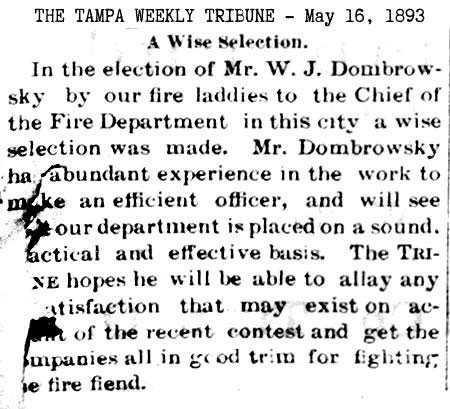 |

|
|
|
|
|
SECOND MAYORAL TERM OF FRED A.
SALOMONSON -
A. J. HARRIS ELECTED TO FIRE CHIEF, May 31,
1893
A. J.
Harris defeated
W. J. Dombrowski
overwhelmingly
for the
position
of Fire
Chief.
Newspaper articles are joyful reporting
"Honored
again.
An
Efficient
Officer
Enthusiastically
RE-ELECTED by a
flattering
vote."
A.
J. Harris' prior election was Asst.
Chief in 1889.
His previous
time as
Chief
was as
Acting
Chief,
which
was an
appointment at
the time
Wuerpel
resigned.
C. E.
Amsworth, N. Madrougha and D. B. Givens
were elected as first, second and third
assistant chiefs.
|
|
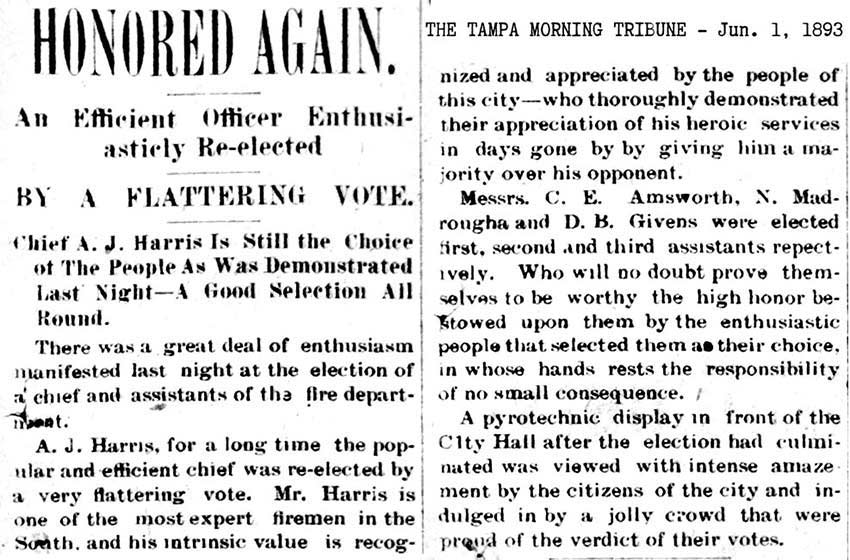
CHIEF
HARRIS INHERITS A RICKETY DISORGANIZED
VOLUNTEER FIRE DEPT.
The
Tribune had a short talk with new Fire
Chief Harris and questioned whether or
not it was legal for him to also be
superintendent of the alarm system as
well. It was Harris's
understanding the the city was going to
consolidate the two offices under one
management, and that would give Harris
an increase in pay. It was rumored
that four of the fire companies were
disbanding: the Invincibles, Resolutes,
Tampas, and Truck No. 2, but Harris said
if that happened, as soon as his
election was confirmed, he would
organize new companies in their places.
The Tribune ends with "Something is
necessary to place our fire dept. on a
sound practical basis."
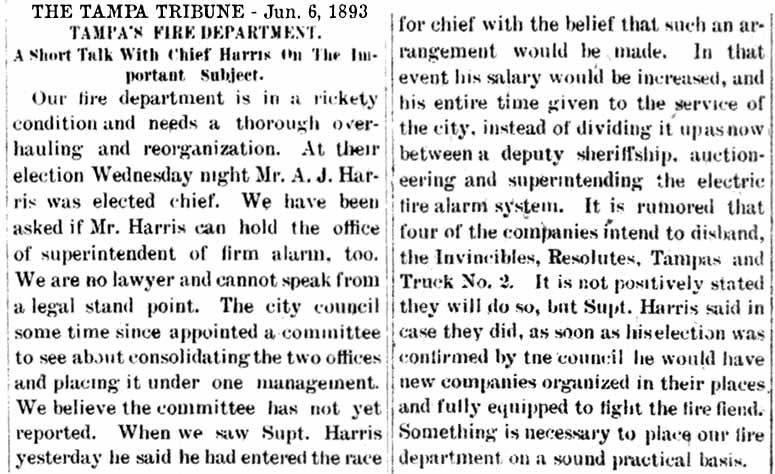 |
|
|
|
|
|
|
|
Jun. 24, 1893 - Tampa Fire Chief A. J.
Harris traveled to Savannah, Ga.
The article says he had served as
Foreman of the Waver Steam Engine Co.
No. 2 in Savannah and had left there for
Tampa "a little less than 8 years ago"
putting his departure at early as 1886.
Articles presented here earlier
concerning his altercation with police
officers confirm he was there in June
1886. |
Nov. 3, 1893 - Member of the committee
to investigate the condition of the fire
dept. equipment, George T. Chamberlain,
reported that all the hoses were tested
at highest possible pressure and were
able to throw a stream of water high
enough to reach the top of any building
in Tampa. |
|
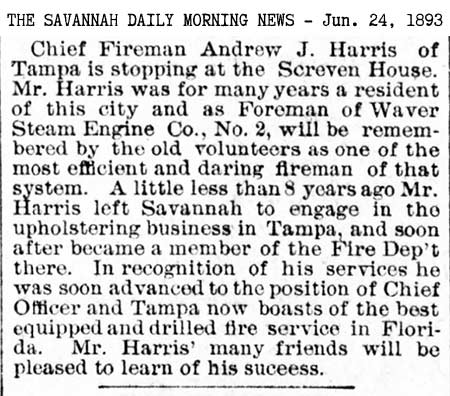
Below:
Nov. 3, 1893 - The first paragraph of a
longer article:
Chief Harris and superintendent of the
water works, W. A. Campbell, reported
that water company customers weren't
turning off their lawn sprinklers when
fire alarms were being sounded (thus
causing low pressure to fight fires.)
They asked for an ordinance to assess a
fine for patrons violating the
ordinance. |
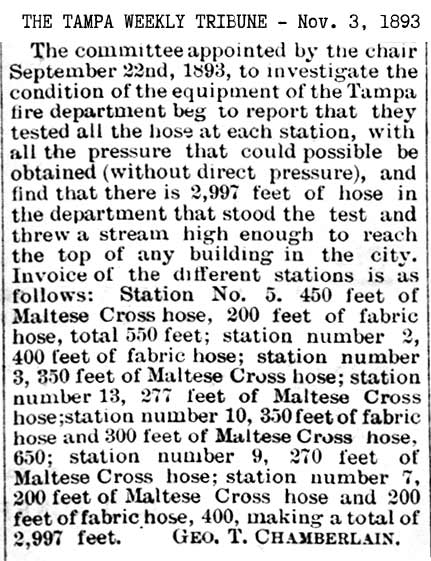
Below: Dec. 29, 1893 - Chief Harris
was training two recently purchased
horses for fire department use. The
horses were named Peter O. in honor of
councilman Peter O. Knight, and George
T., in honor chairman of the finance
committee and former fire committee
member George T. Chamberlain. |
|
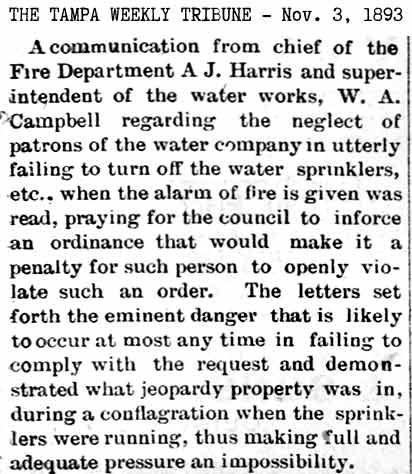
The rest of the article above:
In another communication received by the
city council, Chief Harris called
attention to the neglect of the various
electric light and street railway
companies in conforming with the rules
of the Southern Tariff Association (fire
insurance rates.) |
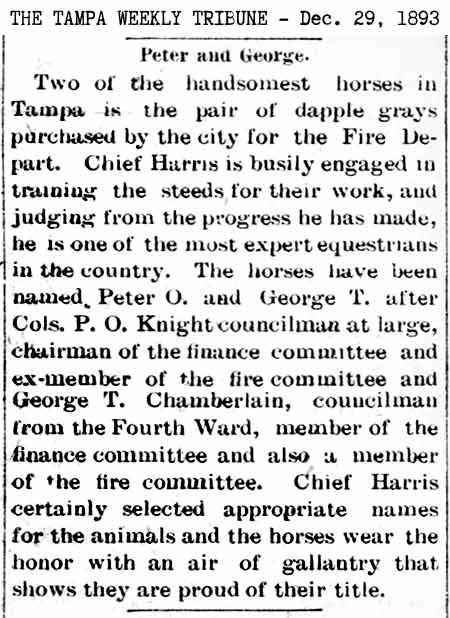 |
|
Trolley systems were
supposed to use guard wires over their
trolleys but were neglecting to do so.
He cited an instance on Oct. 14th when a
telephone wire at 8th Ave. and 13th St.
contacted a trolley wire, setting off a
fire to the telephone switchboard in the
central office, and since the telephone
lines are connected to many buildings in
the city, "it was a miracle that we did
not have a fire at a dozen places at the
same time." He goes on to say that
Tampa was enjoying the lowest rates of
insurance of any city or town in
Florida, and if they wanted to keep
those rates, they needed to remedy this
problem.
In another communication received by the
city council, due to the committee
investigation into the wants and needs
of the fire department, it was
determined that the hose reels were
damaging the hoses more than their use
at the fires so they needed to be fixed
to prevent them from further cutting
into the hoses. Chief Harris was
authorized to get bids for: 2 one-horse
fire wagons, fully equipped, 3,000 feet
of fabric hose 2.5 in. in diameter, four
dozen blown-glass lanterns with T.F.D
stamped on the frame, 2 dozen fire axes,
and 1 dozen crowbars with T. F. D. stamped
on all, buy a water gauge not to cost
over $35, 3 dozen hose couplings and 72
rings, 3 dozen hose straps, 12 hose
pipes and 5 dozen hose spanners. Also
to install a fire alarm box at the
corner of Florida Ave. and 8th Ave, move
the bell tower from the corner of Fla.
Ave. and Constant St. to a point on Fla.
Ave. to be named later, and at once
employ 2 men to keep the reel houses
and fire equipment of the city in order
and to attend all fires at a salary of
$45 per month for each man.
Chief Harris also notified the City
Council of the bids received for 3,000
feet of hose, along with samples, which
were read and were authorized for Harris
to get the hose he considered best.
Hose at 80 cents per foot was selected.
See the entire article here. Click the
image again to see it full size. |
| |
|
THE GREAT FIRE AT SPENCER LIVERY BARN, DATE
NOT SPECIFIED
From an article by D. B. McKay, Aug. 23, 1959,
Tampa Tribune, "Pioneer Florida"
The
most spectacular fire in Tampa within my
memory--before we had a paid fire
department--occurred at John B.
Spencer's livery barn. The big
two-story structure extended from Water
Street to Tampa Street on the south side
of Jackson Street. Stables for the
stock were on the ground and the loft
was filled with hay, grain and vehicles.
When
discovered, the fire had a good start,
but the volunteers responded promptly to
the alarm and checked the flames before
they had reached the most flammable
material. The horses, mules and
valuable Spanish jack were released and
ran wild in the streets.
The
department's equipment consisted of a
hand pump operated by four men, and the
water supply was the Jackson Street
ditch, which was the full width of the
street from Morgan Street to the river,
with an average depth of 25 feet.
During the rainy season the ditch was
filled to street level. Robert Mugge
presented the pump to the department and
other citizens gave hose carts and hose.
At this point,
McKay goes on to describe another great
fire, but comes back to the story of the
Spencer stable fire near the end of his
column. He wrote,
I
was standing near T. C. Taliaferro
watching the valiant fight of the
volunteers. A portion of the roof had
been cut off to give better access to
the flames. We could see Chief Harris
battling desperately to prevent the fire
from reaching the large hay storage
loft. Mr. Taliaferro realized that
Harris was in great danger and he
ordered the hose man who was near him,
"Turn turn that stream on the chief and
soak him thoroughly. His clothes are
smoking!" The order was obeyed so
efficiently that the chief was knocked
down and out of danger.
When did this great fire take place?
McKay doesn't say, but he does give some
clues that can help determine when this
fire took place. The question is, how
accurate are his memories at least FIFTY to
SIXTY years later?
Following
is an analysis of these events for the
purpose of determining when this fire
occurred so that McKay's references to the
department still being on a volunteer basis,
and A.J. Harris was the chief at the time.
When did
the Spencer livery stable extend from Water
St. to Tampa St?
Below is seen the J.B. Spencer livery stable
across an eight year span. Stables on
the Sanborn maps were indicated by diagonals
on the structure. As McKay stated, stated,
the fire department was a volunteer
department. Spencer's livery was located on
the south side of Jackson St. and at the
time of the fire, it stretched from Water
St. to Tampa St. McKay also stated that the Mugge pumper was in use; it arrived July 30,
1886, and A. C. Wuerpel was Chief.
|
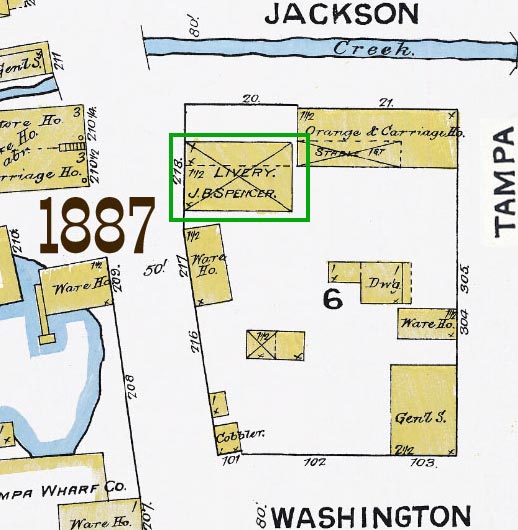 |
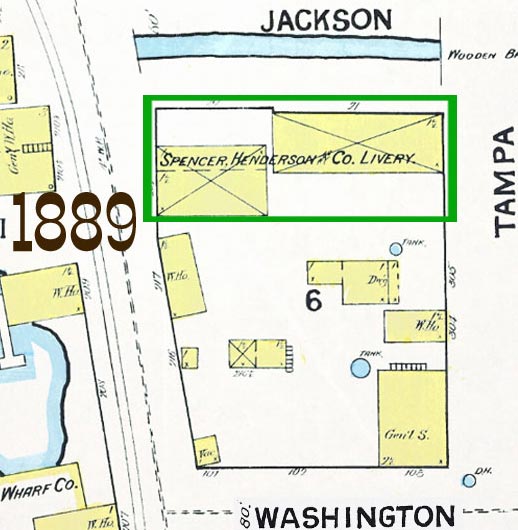 |
|
1887 -
Mugge pumper in use, department
was volunteer, but here the
Spencer livery doesn't extend to
Tampa St. The other building
behind it is an orange and
carriage house (with a smaller
stable on the ground floor.)
Both structures are 1½
stories--a ground floor and a
loft. A.C. Wuerpel was still
chief. |
1889 - not
much structural change to the
area, but now Spencer has become
Spencer Henderson & Co. Livery
and has taken up both structures
along Jackson St. On April 17,
1889, the unorganized volunteer
fire dept became organized with
the passage of city ordinance
no. 40. A.C. Wuerpel was still
chief. |
| As
covered earlier on this page:
An
election was held on
May 29, 1889. A. C. Wuerpel
was elected over George R. Macfarlane.
Harris and
Rodriguez were elected as 1st and
2nd assistants, having run unopposed for
the positions. These were 2-year
terms so their terms would end May
28th, 1891.
However, Chief Wuerpel resigned
in early June of 1890, at which
time A. J. Harris was appointed
as Acting Chief and still served
as 1st Assistant. Harris
served in those positions until a
special election was held on Aug.
29, 1890 to fill the position of
Chief through May 28th, 1891
(when Wuerpel's term would have ended,
as well as the assistants' terms, Harris
& Rodriguez.) In that Aug. 29, 1890
special election, T. C.
Taliaferro was chosen as Fire Chief
over C. E. Harrison, 130 votes to 61
votes, and B. M. Balbontine was
chosen as First Assistant Chief over A.
J. Harris, 113 to 77. On May 27, 1891, it was time for the
firemen to choose another Chief and
Assistant Chiefs for a 2-year term.
So T. C. Taliaferro was the elected
Chief in Sep. 1890. Harris ran
for first assistant but was
defeated, so he was
still with the Alert
Hose Co., in Sept. 1890. On June
8, 1891, A. J.
Harris was elected Vice President of the
Alert Hose Co. .
|
|
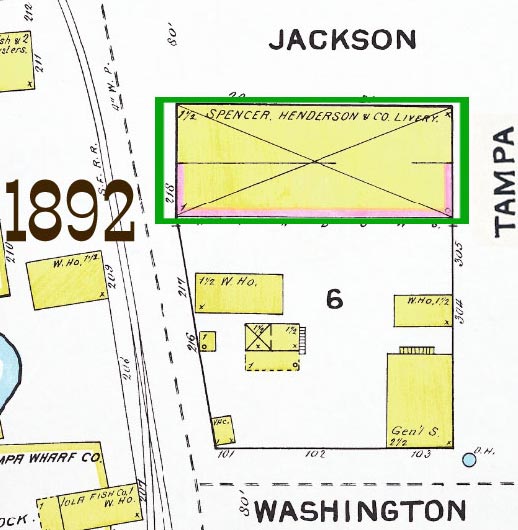 |
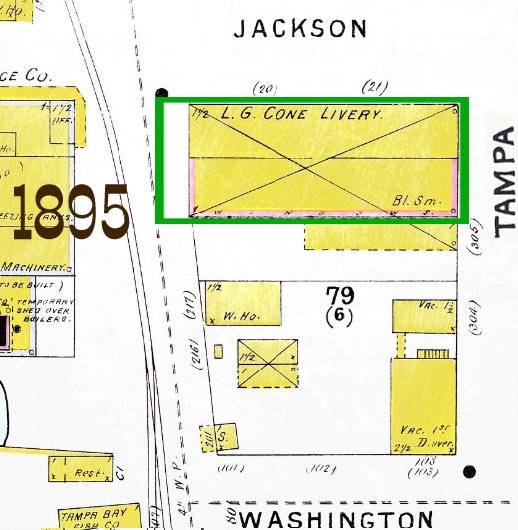 |
|
1892 -
The dept.
was still volunteer,
now
Spencer Henderson's livery
extends the entire block from
Water to Tampa St.
This construction could have
taken place any time after the
1889 map was created.
The Jackson St. ditch no longer
exists. Either T.C.
Taliaferro or George Macfarlane
was Fire Chief, with Macfarlane
still serving until end of May,
1893 when Harris was elected. |
By
early May 1893, George R.
Macfarlane was Fire Chief.
On May 31, 1893, A. J. Harris
was elected Fire Chief.
The fire department was still
volunteer. By 1894 L. G.
Cone owned the livery barn.
(From a newspaper ad.) |
| |
|
PUTTING THE CLUES TOGETHER
McKay says the Mugge Pumper was
in use and the water was drawn
from the Jackson St. ditch.
But in 1892 the ditch no longer
existed. Harris was
Acting Chief until Aug. 29,
1890. He became Chief at
the end of May 1893, so
there is no overlap where these
two conditions existing at the
same time. McKay's memory
must be incorrect about some
conditions, they are some 50
years after the event, and he
does say "that he could
remember."
If
the fire occurred in 1893 while
Harris was Chief, why would he
be out there fighting the fire
instead of supervising his men
and directing the situation?
Why would Taliaferro even be at
the fire in 1893 or afterwards
since he was no longer Chief?
How could he be in a position to
direct the firemen?
The more plausible situation is
that McKay's memory of who was
Chief at the time is incorrect.
Even in the time of Chief Harris'
death, he is alluded to as being
the Chief for longer than he
actually was. The logical
conclusion and simplest
explanation is that Taliaferro
WAS in fact the Chief during
this fire, and
Harris was with the Alert Hose
Co when his time as Acting Chief
ended. So the fire would
have taken place in 1890 or 1891
when the Jackson St. ditch could
still have existed, the Spencer
Henderson barn could have
stretched from Water St. to
Tampa St., Harris was with the Alert Hose Co,
and Taliaferro was Chief.
But McKay is also mistaken about
which livery barn was destroyed
in the fire. The S&H
livery barn that stretched from
Water St. to Tampa St. was not
involved in the fire, but it WAS
an S&H livery barn that was
destroyed. It was the one
on the waterfront, not the one
between Water St. & Tampa St.
Evidence is shown below the
article.
The article
below, the devastating fire at
the Fuller warehouse and the
Spencer Henderson livery
stable/carriage house on the
waterfront on Dec. 21, 1890,
fits the above scenario except
for mention of the hoses being
turned on Harris. It's
doubtful the newspaper would
have missed this, so McKay may
be confused with some other
fire, or the passage of time
created an imagined reality. |
SEE THE
ARTICLE LARGER
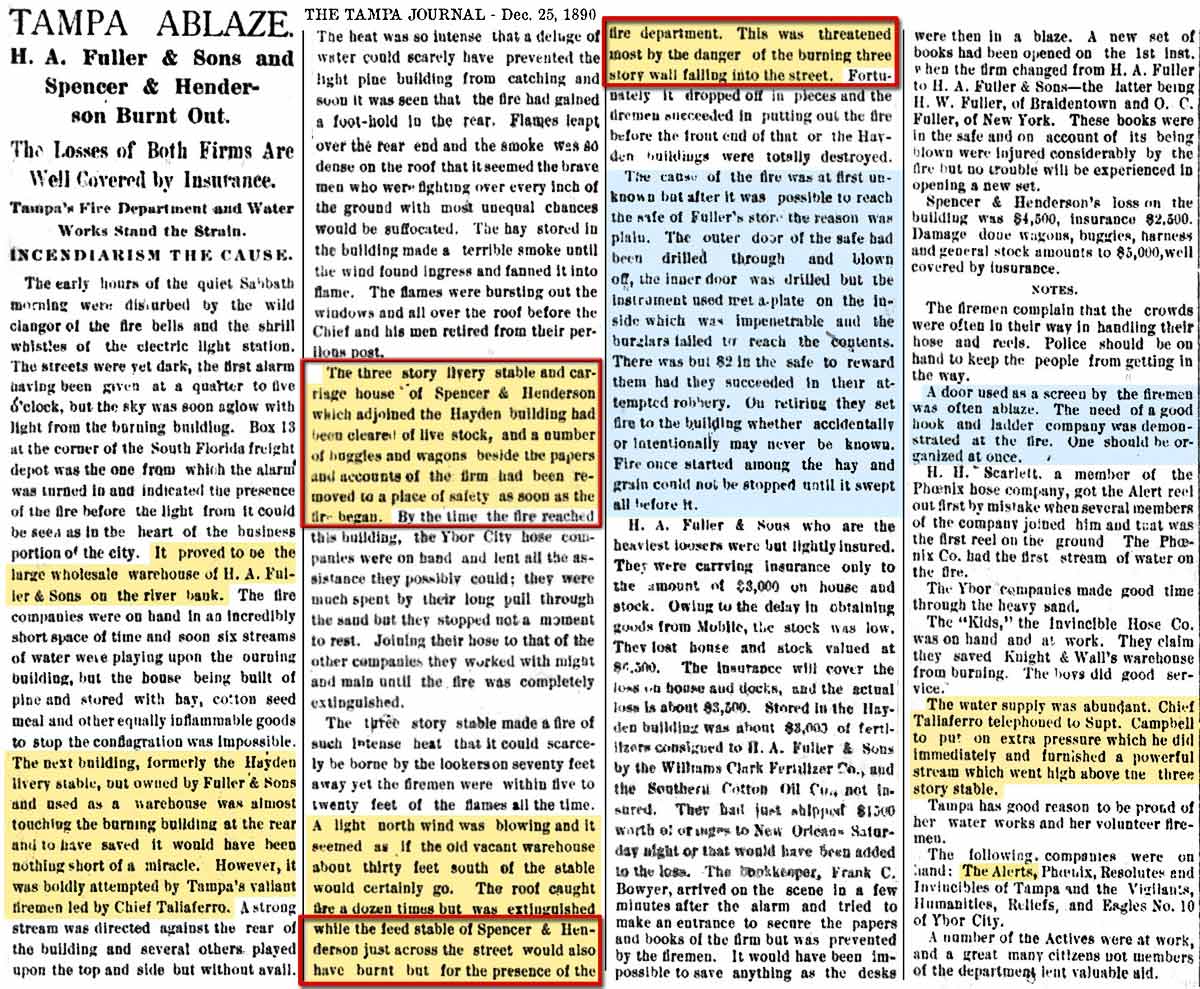
The fire started on the waterfront at
the warehouse of H. A. Fuller & Sons
(1).
There was an adjacent building almost
touching the warehouse, which was
formerly the Hayden livery stable, but
then owned by Fuller and also used as a
warehouse (2). Both these buildings
were destroyed. A THIRD building,
which the fire reached, is described
consistently as a THREE-STORY livery
stable and carriage house of Spencer &
Henderson,
which had been CLEARED OF
LIVESTOCK and some buggies and wagons.
McKay says that horses were let loose to
run wild in the streets.
It is the ONLY 3-story building in the
area on the maps. (3)
A fourth building is described as an old
vacant warehouse about thirty feet south
of the stable, whose roof caught fire
several times but was extinguished (4).
In the same sentence, a FIFTH building
is described as the feed stable of
SPENCER & HENDERSON JUST ACROSS THE
STREET (5) would have been burnt if not for
the firemen, but was threatened by the
THREE-STORY WALL falling onto the
street. So a street is in between
these two buildings. (Water St.) CHIEF
TALIAFERRO was present, as was the ALERT
HOSE CO.
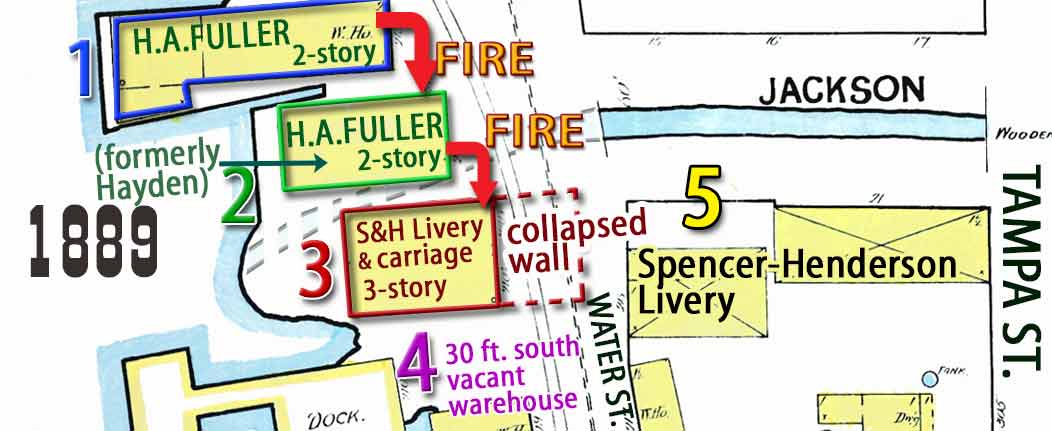
Above
shows that the Jackson St. ditch used to
flow at ground level all the way to the
river where Hayden's ferry service was
located.
By 1889, the ditch drained underground
to the river between the river bank and
Water St., and Hayden's ferry was gone
due to the completion of the first
Lafayette St. Bridge.
The 1892 map below
shows by this time the first building
was replaced by a larger one,
the 2nd building by a smaller
one, and the 3rd building was not
replaced.
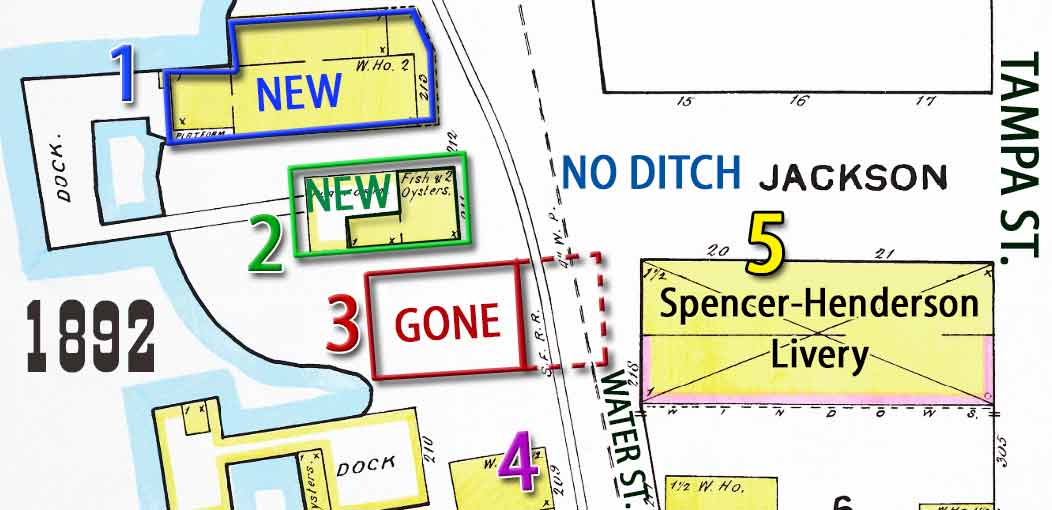
|
The photo below shows
Hayden's ferry crossing the Hillsborough
River sometime before 1887. The
photo was taken from the west bank of
the river from the Hyde Park side,
looking east to the (downtown) Tampa
side. The 3-story
Spencer-Henderson warehouse is the only
3-story building in the area. by
1889, the shack at the left edge, which
was Hayden's ferry landing on the east
bank, was replaced by a livery stable
and then became a warehouse for H. A.
Fuller.
|
|
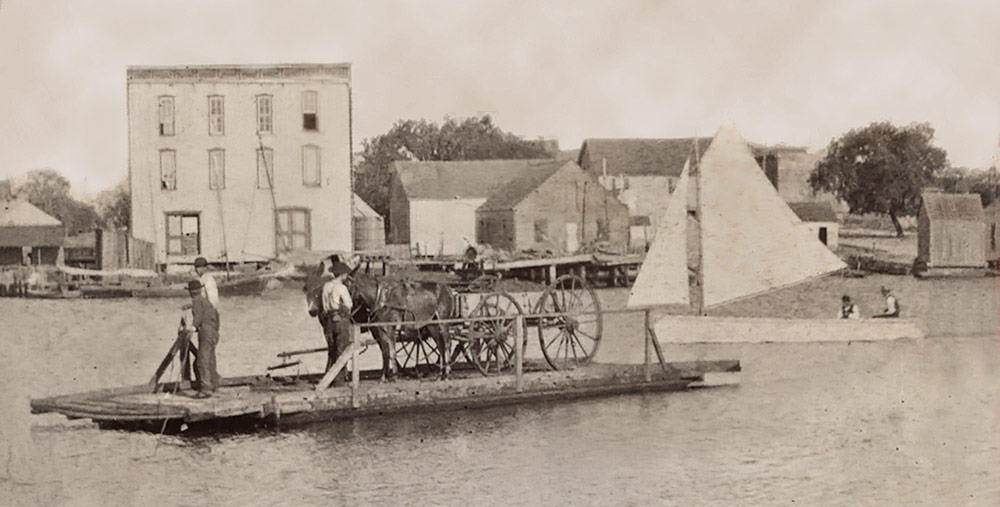
From the ROBERT N.
DENNIS COLLECTION OF
STEREOSCOPIC VIEWS (filtered
for Tampa) at The NY Public
Library Digital
Collections.
Below is a wider angle view taken a year
to a few years later, almost from the
same vantage point. In the
foreground is the ramp for Hayden's
ferry landing on the west bank (Hyde
Park side.) This photo matches up
well with what is seen in on the 1887
map, though it could be from as late as
early Dec. 1890 before the fire.
At the left edge can be seen the east
bank approach to the first Lafayette St.
Bridge.
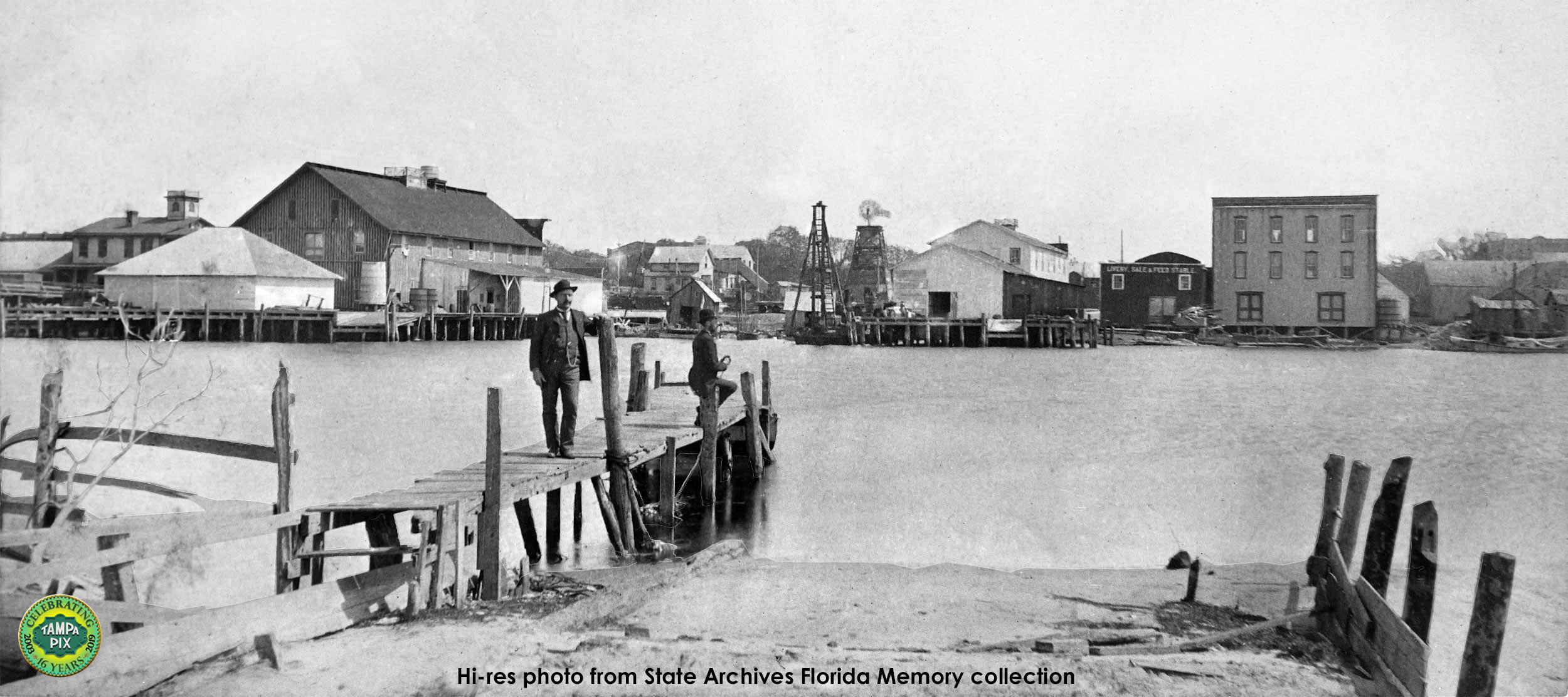
Photo courtesy of the State Archives
Florida Memory collection.
Below is a close up of the above photo
which shows the three buildings which
would be involved in the Dec. 21, 1890
waterfront fire.
 |
Today,
the site of the three buildings above are the
location of the swimming pool and patio of the
Sheraton Tampa Riverwalk
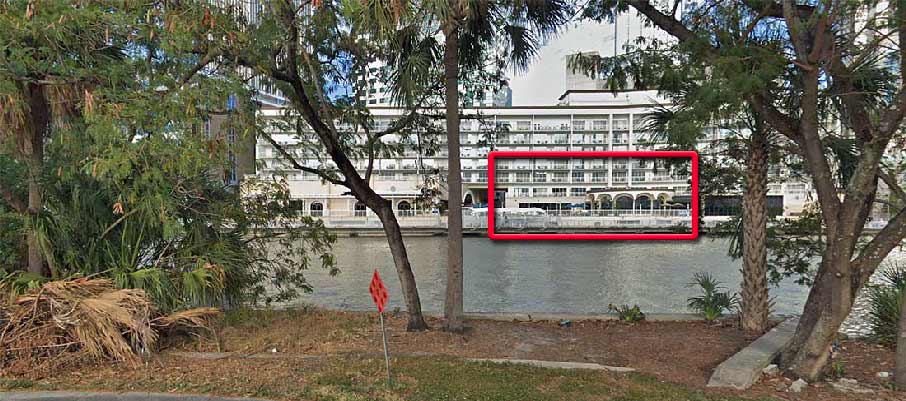
The entire view
of the first photo would fit in the angle seen below.
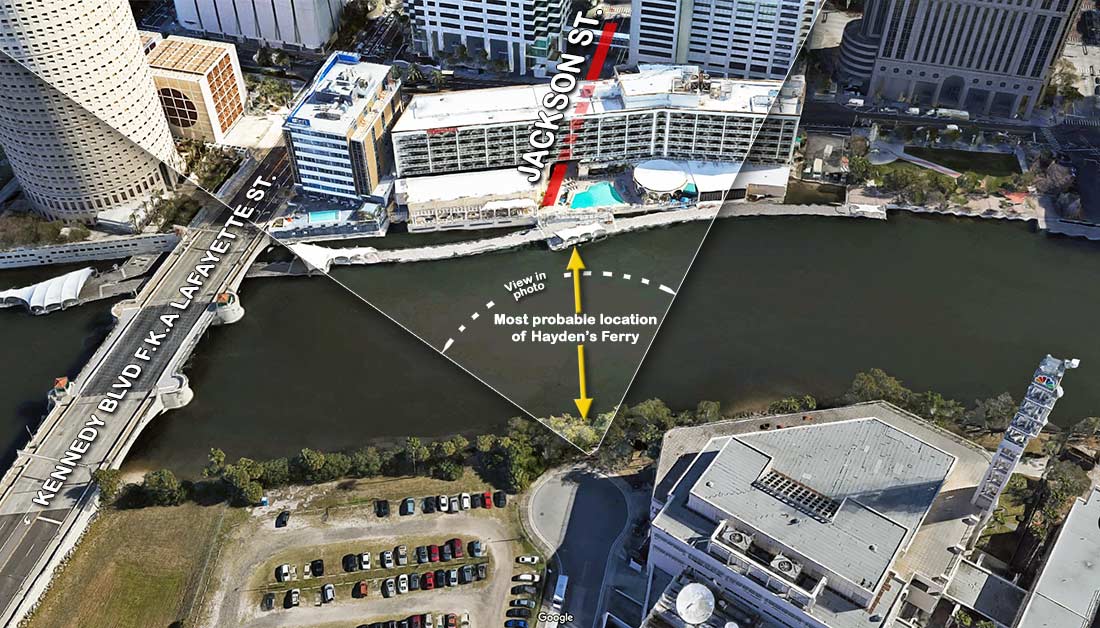
LEARN MORE ABOUT THE HISTORY OF HAYDEN'S
FERRY CROSSING
FIRES OF
1894
Tampa suffered a series of disastrous fires during
1894 (according to Karl
Grismer). In
addition to seven homes and three small business
places, the Tampa Lumber Company's plant was
completely destroyed on July 27, 1894 causing a loss
of $30,000.** (From
Grismer, History of Tampa.)
|
Below: The fires
mentioned by the Tribune for 1894.
Dates are that of the article. |
5 Jan
9 Feb
6 Apr
13 Apr
27 Apr
4 May
11 May
3 Aug
15 Jun
22 Jun |
W. S.
Knight of Knight's Station:
large barn, contents and a
horse.
Mrs. Dombrowsky - coal stove
explosion
2-story wood structure in the
scrub.
False alarm, 4th Ward; burning
grass
Old phosphate building on the
river (at right.)
Brush heap between the T.B.
hotel & laundry, fire dept. not called.
Brush fire in Tampa Heights
burns outhouses at Sawyer's place.
Disastrous fire at the Tampa
Lumber Co. (See article below.)
Midnight fire at Ybor City FC
& P depot - no valuables inside.
George Booth of Bay View loses
barn with $1,200 of wine. |
-
-
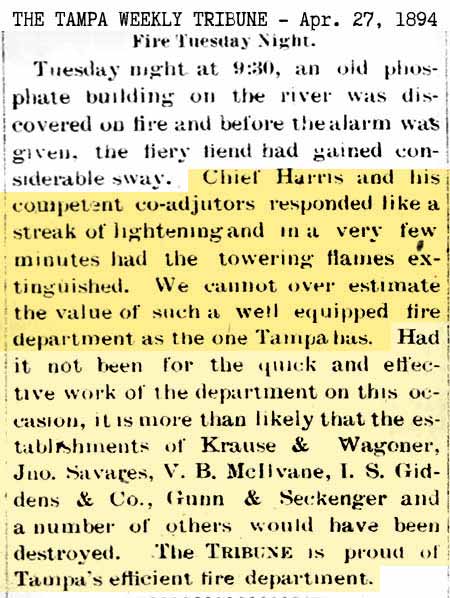
.
On May
18, 1894, the city council accepted the report of
the Water and Fire Protection committee
recommendation to add four new fire alarm boxes: 1)
Corner of Tyler and Franklin, 2) Division and 9th
St., 3) 11th Ave. and 17th St., 4) 14th Ave. and
20th St. |
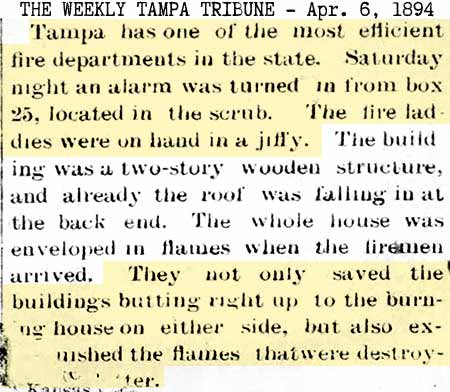
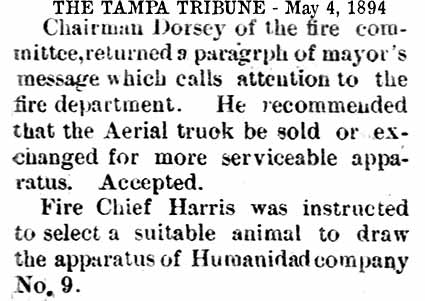
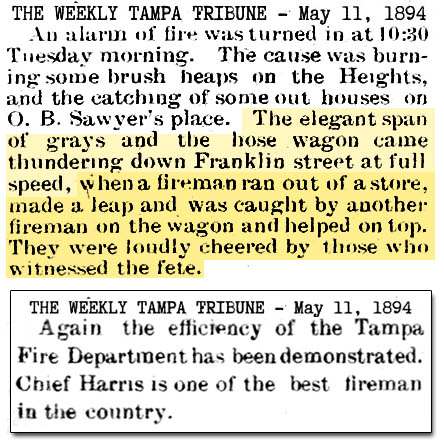
|
|


|
|
At their June 29 meeting, the city
council authorized the sanitation and
fire departments a loan because they had
no funds to pay their running expenses. |
In July, Chief A. J. Harris traveled to
Atlanta to convince the Association to
lower their fire insurance rates for
Tampa due to the recent improvements of
fire protection. |
|
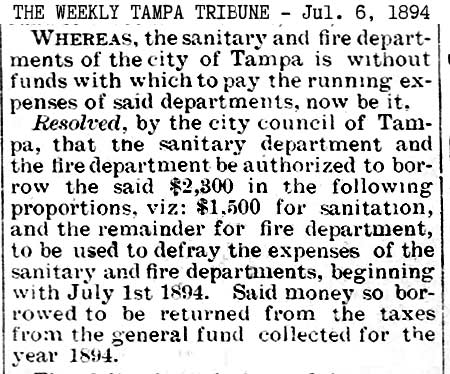 |
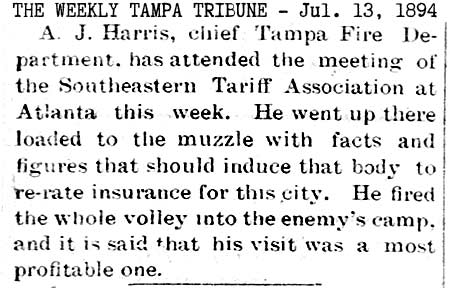 |
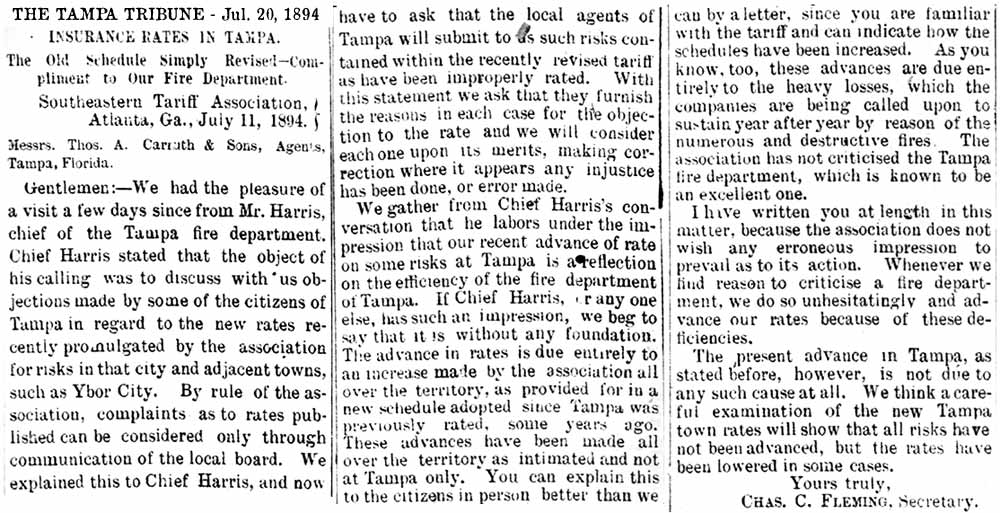
Catastrophic Fire at the Tampa Lumber Co., July 27,
1894

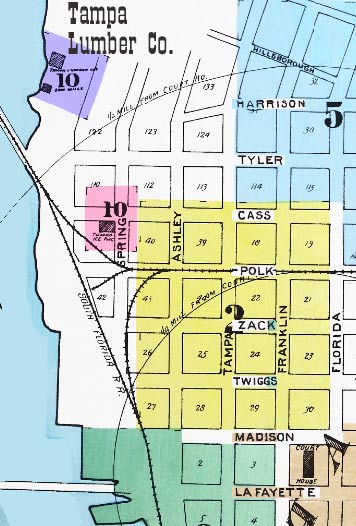
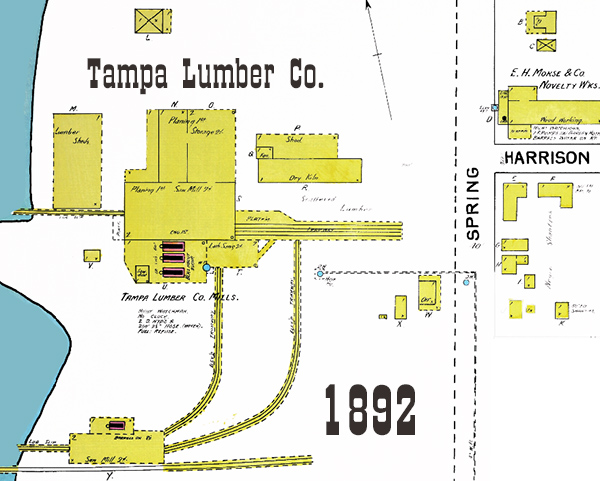
Today
this is the site of the Straz Center for the
performing arts.

TWO LA FRANCE FIRE
ENGINES ORDERED
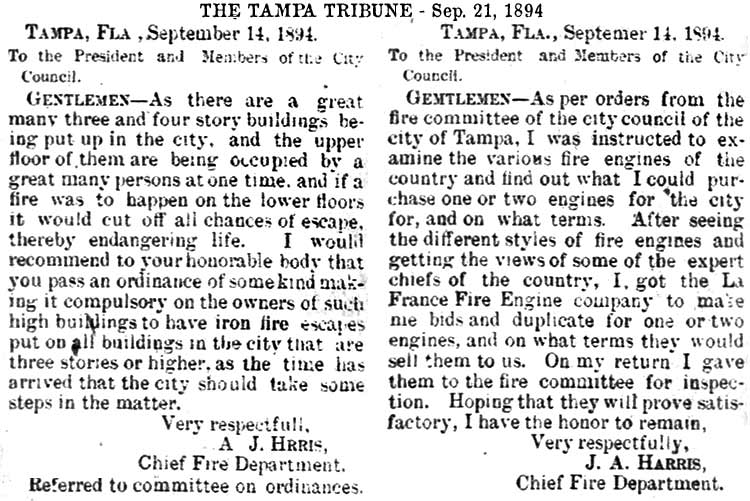 In
mid-Feb. 1894 Chief Harris thanked the City Council
for allowing him to travel to Montreal to consult
with other fire chiefs from the largest departments
from throughout the U.S. Two letters from
Harris to City Council of Sep. 14 were published in
the Sep. 21 Weekly Tribune. In
mid-Feb. 1894 Chief Harris thanked the City Council
for allowing him to travel to Montreal to consult
with other fire chiefs from the largest departments
from throughout the U.S. Two letters from
Harris to City Council of Sep. 14 were published in
the Sep. 21 Weekly Tribune.
In the
first one, Harris wrote that there were many three &
four story buildings being put up in the city, with
the upper floors occupied by a great many persons at
one time. If a fire started on the lower
floor, they would have no chance to escape. He
urged City Council to pass an ordinance requiring
building owners to install iron fire escapes.
His
second letter states that as he was instructed, he
examined various fire engines around the country for
the purpose of purchasing two and on what terms.
He obtained the opinions of expert fire chiefs and
chose the La France Fire Engine company to submit
bids on the terms they would sell for. He
submitted his findings to City Council and hoped
they would find it satisfactory and approve.
The
article continues on another page which is extremely
faded, it reads:
"After
considerable discussion pro and con, a motion was
finally made authorizing the city attorney to draw
up a contract for the purchase of two La France fire
engines at $6,000 to be sent on trial without cost
to the city, to be accepted only in case they prove
satisfactory. Terms $2,000 cash and the
balance in one, two and three years."
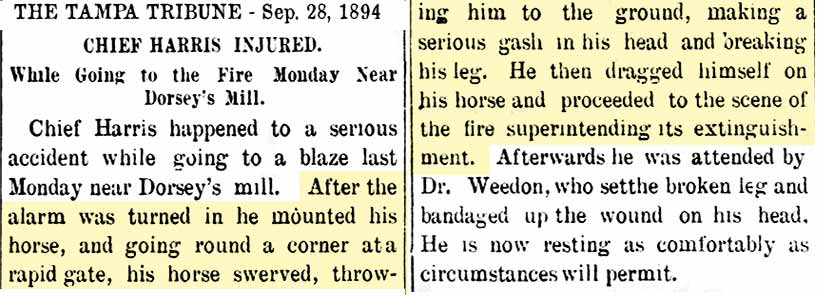
|
The
fires emphasized the fact that Tampa's volunteer
fire department and obsolete fire fighting equipment
were entirely inadequate to provide proper
protection. So a number of citizens pushed the city
to take additional action, The council was pressed
to act, and on December 31 ordered two modern La
France fire engines and all other equipment needed
to establish a first-class fire department. The
engines arrived in March and were named "Manrara"
and "Salomonson," in honor of the two men who
contributed money to buy horses to pull them. On
March 22, 1895, the city council authorized the
creation of a professional fire department of paid
employees. |
|
FIRE CHIEF
ANDREW JACKSON HARRIS
 |
TAMPA'S FIRST
PROFESSIONAL, PAID FIRE DEPARTMENT
On March 22,
1895, the city council passed ordinance #128
authorizing Tampa's first professional, paid
fire department. A. J. Harris was named
chief to preside over 22 firefighters in
five stations at an annual budget of
$18,000. The paid firefighters worked in the
stations for ten to twelve days at a time.
Most of the firefighters lived near their
duty stations and were permitted to go home
for meals, provided they could return within
one hour. Their salary was equivalent to
that of police patrol officers, about $600 a
year. By 1900 there were 5 fire
stations providing protection for the city.
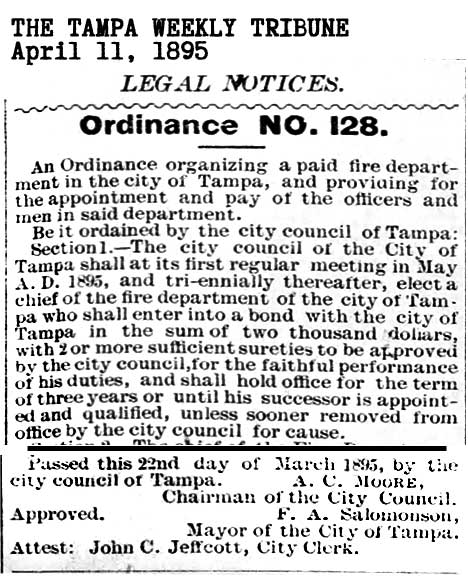 |
| |
Read the entire Ordinance No. 128 - Seven
sections long. |
ARTICLES TO
INSERT
Nov. 25,
1897 Trib - Harris sets up new station in Ybor No.4
June 15, 1899
Trib big carnival Chief Harris plans fireman's
competitions
Jun 14,
1903 Trib MAYOR NOW AFTER FIRE CHIEF'S SCALP,
Hearing begun last night, A Fired Fireman Sykes accuses
chief of the Heinous Crime of Hauling Brick in a Dept.
Wagon, great ado about a little.
(Accusations by a disgruntled dismissed fireman that
Chief Harris committed neglect of duty, use of a dept.
wagon for personal use, having a fireman do personal
construction at his home. All allegations were
exaggerated. It was no longer Harris' job to
inspect fire station #4, it was job of asst. chief.
Brick was hauled to exercise the horses, as directed by
vet. Fireman did brick work at Harris's house
while on lunch hour, paid for work, no complaints from
the fireman who verified whole affair.
(See "Tampa's
Bravest" website and history and City
of Tampa Fire-Rescue History. See for more detail)
1900 Census, Tampa, 218 Jackson St.

This census reports A. J. and Mary had been married for 26
years, which would mean they married around 1874 when Mary was around 20 and A.J was 35. Mary's parents were born in
Scotland. A J reported that he immigrated to the US in
1850 and was in the country for 50 years at this point.
Depending on what month he arrived, he would have been
at most, 11 or 12. He apparently had not yet become a
naturalized US Citizen. It looks like the
enumerator had written "Na" but then erased or rubbed it
out. Interesting to note that A.J. says his
mother was born at sea. Daughter
Margaret "Maggie" Leslie Harris born
Oct. 1887, son Andrew Martin Harris born Feb. 1888.
This 1901 photo of
Tampa's first paid fire department is courtesy of
Tampa's Bravest website

Notice the location of the
fire alarm bell tower at the left rear corner of the
building.
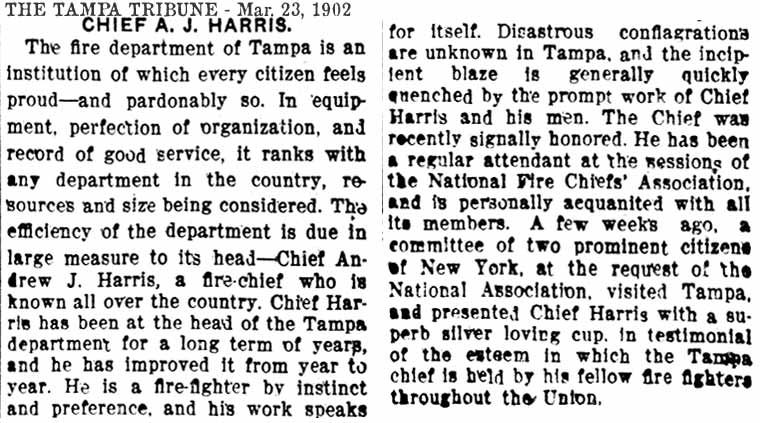
ORDINANCE 307 REORGANIZES THE FIRE DEPT AND SETS HIRING
AND CONDUCT RULES
In late
Feb. 1903, the City passed ordinance No. 307 to
reorganize the fire dept. and place the employment of
its personnel on a basis of merit, and to regulate
conduct and governing of the dept. Sec. 1 begins
with regulations on the appointment of a chief under the
rules of the city charter and hiring of personnel to be
based on fitness and merit which was to be determined by
competitive examination.
See all 20 sections of Ordinance 307
SURPRISE
BIRTHDAY PARTY FOR CHIEF HARRIS
Chief
Harris was given a surprise birthday party on the
evening of Aug. 28, 1903. Arranged with musical
entertainment, the party was given by Mrs. Harris,
daughter Marguerite, and A.J.'s half brother (and his
wife) George M. Morris. The house was brilliantly
lit by electric lights and hundreds of Japanese lanterns
swinging from the fence posts, orange trees and yard
plants.
A.J. is
twice described as "silver-locked" (his hair color.)
Also as "supple-limbed and young-hearted" chief.."who is
62 years old, 39 years a fireman, and 29 years a
benedict (a newly married man, especially one who has
long been a bachelor.) The Harrises indeed had
been married for 29 years, marrying in Savanna, Ga. in
1874 when A.J. was 36 years old. A fireman of 39
years puts the start of his career in 1864, a time when
he was in Savannah. But the big surprise is that
Harris was actually 65, not 62. He was born in
1838.
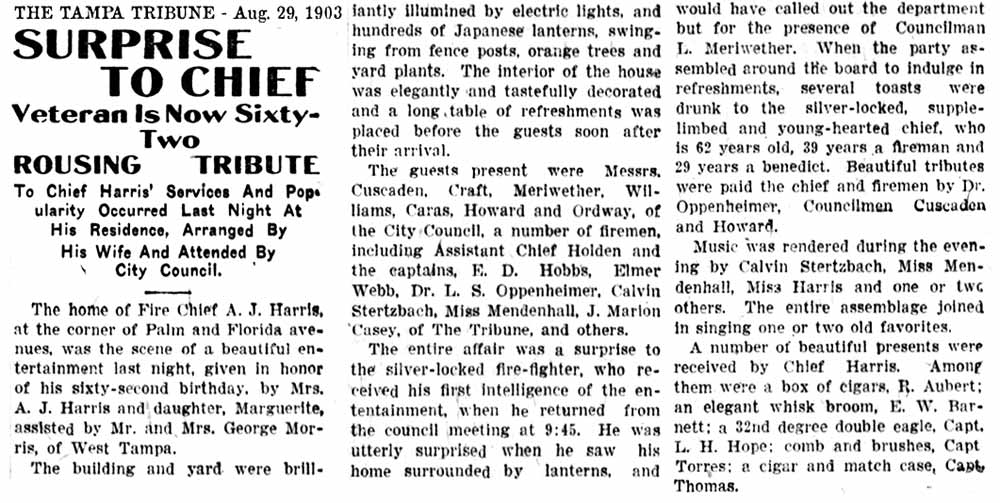
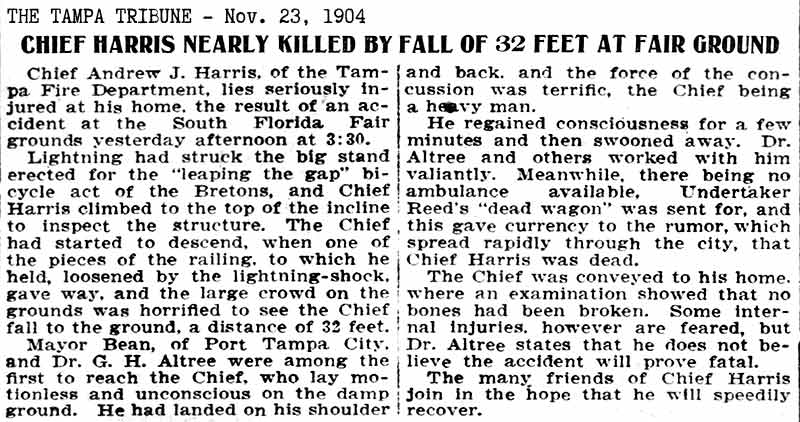 HARRIS
SUFFERS A SERIOUS FALL HARRIS
SUFFERS A SERIOUS FALL
Harris fell 32 feet to the
ground from a daredevil stunt ramp he was inspecting at
the South Fla. Fair. The ramp had been previously
struck by lightning and after he was done checking it
out, a railing he was holding on to on his way down the
ramp gave way.
He landed on his shoulder
and back and was knocked unconscious for a few minutes,
"...and the force of the concussion was terrific, the
Chief being a heavy man."
No ambulance was available
so he was taken home in Undertaker Reed's "dead wagon"
causing a rumor to spread quickly around the city that
Chief Harris had died.
It was believed that he
had no broken bones but had some internal injuries which
were thought to be non-fatal.
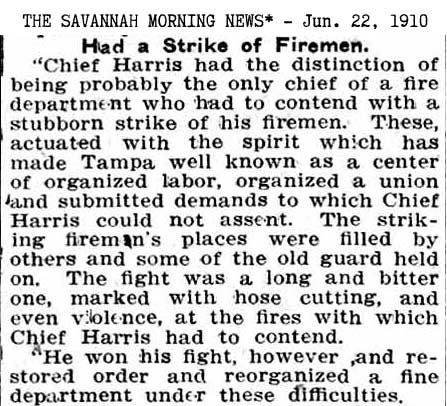
1905,
May 23rd - Fire in Tampa destroys one of Robert Mugge's
buildings
A fire
on May 23rd, 1905 destroyed Mugge's 2-story brick
building, 60 ft x 100 ft, on the northwest corner of
Franklin and Carew streets. Mugge then brought suit in
the Circuit Court of Hillsborough County against Tampa
Waterworks for failing to provide adequate fire
protection, due to low water pressure, through a system
that was supposed to be "First Class...with a reservoir
capable of holding 100,000 gallons of water, sufficient
to give a pressure on the mains from a hydrant located
at the intersection of Washington and Franklin streets,
and through 100 feet of fire hose and a 1-inch nozzle,
to throw a stream of water vertically to a height or
distance of 50 feet, giving a first-class fire
protection..."
The
Circuit court dismissed the suit, in favor of the Tampa
Waterworks. But Mugge took the case all the way to the
Supreme Court of Florida, where the judgment was
reversed, "Error to Circuit Court, Hillsborough County,
Joseph B. Wall, Judge. Read
about the details of the case, Mugge vs. Tampa
Waterworks Co..
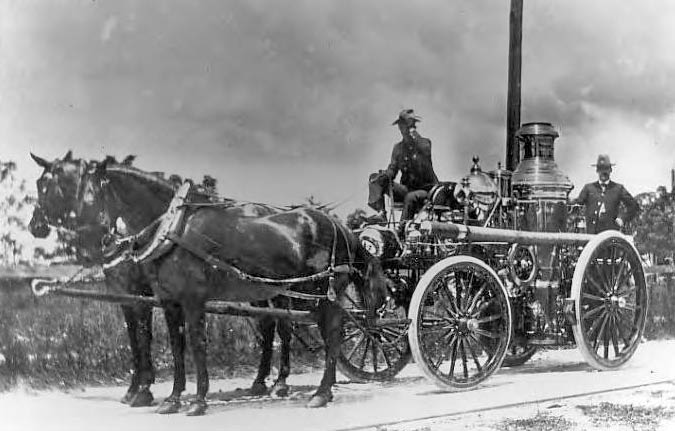
La France horse drawn steam piston pumper, named Elmer
Webb, assigned to Station 4 of the Tampa Fire
Department. Burgert
Brothers photo from the Hillsborough County Public
Library Cooperative Digital collection.
|
MAYOR
FRECKER
REMOVES
FIRE
CHIEF A. J.
HARRIS
On
June 26,
1906
Tampa
City
Council
approved
newly-elected Mayor Fecker's
appointments
to Chief
of Fire
Dept,
Chief of
Sanitary
Dept.
and
Asst.,
Plumbing
Inspector,
Electrician,
and
Veterinary
Surgeon.
Frecker's
decision
to
remove
Andrew
J.
Harris
as Fire
Chief
wasn't
too
popular
with
many
Tampans,
as
Harris
had
proven
himself
for
"nineteen
years."
(Harris
was with
the
department
for
almost
19
years,
since
1888,
but he
was
not the
elected
Chief
for all
those
years.
He was elected
Chief
for 13
years
when the
first
paid,
professional
dept.
was
organized
in
1893.)
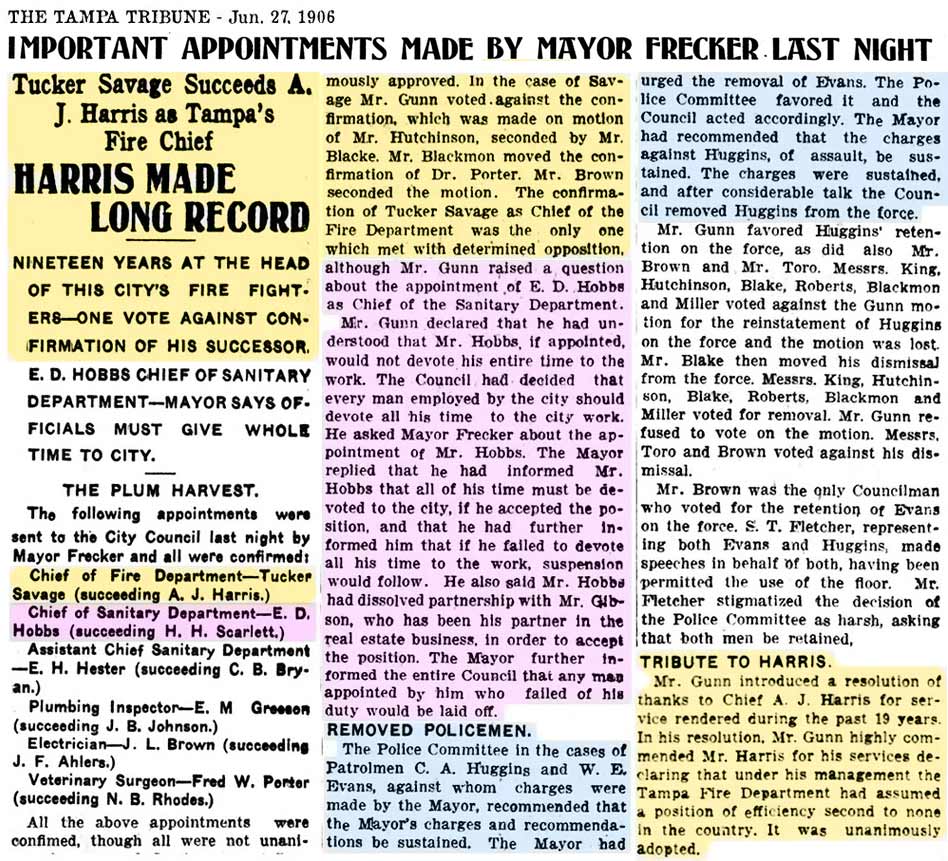 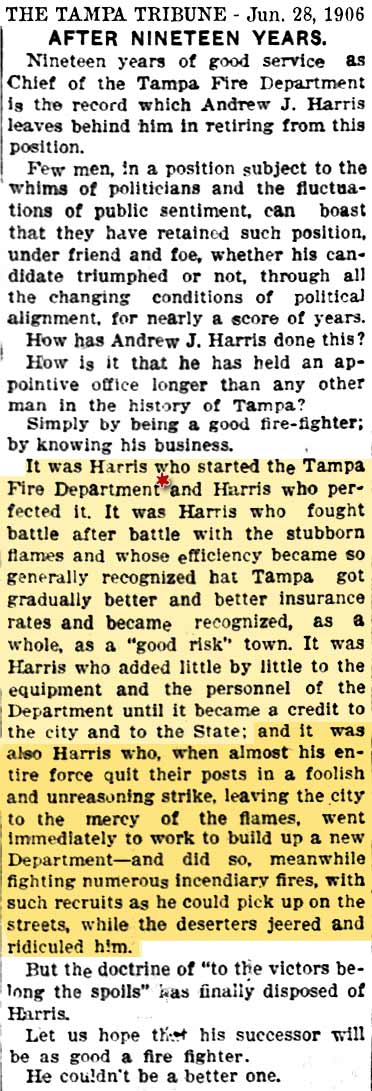
*Harris
was not
Fire
Chief
for
nineteen years.
Nineteen
years
earlier,
in 1887,
Tampa
had a
volunteer
dept.
and the
Chief
was
Augustus
Wuerpel.
When Frank Wing was elected mayor in 1908, he removed Savage and reinstated A. J. Harris as Fire Chief.
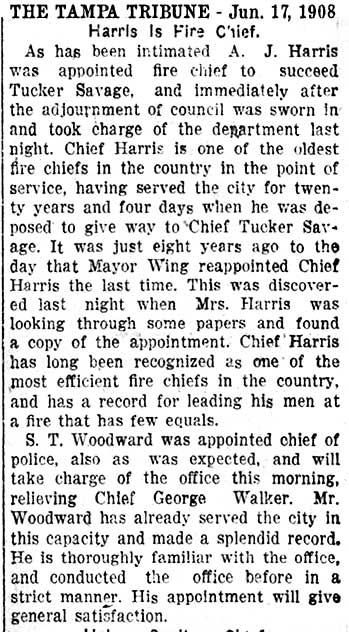 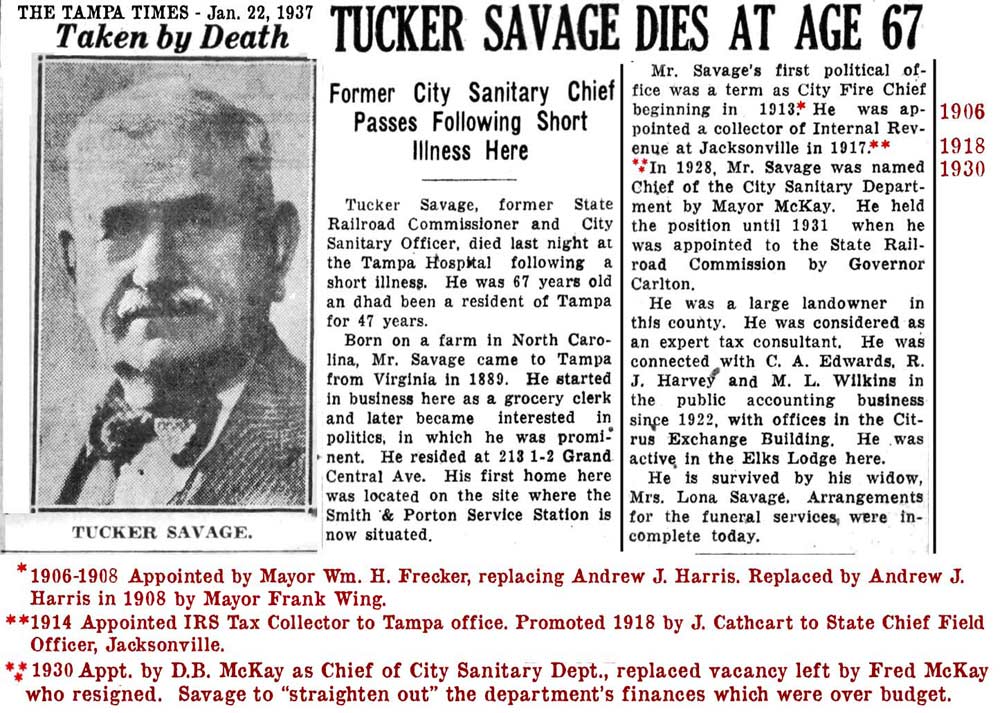
|
| |
1910 Census, Tampa - 314 Florida
Avenue between Lafayette & Jackson St.

The Harrises were living in the old Stringer house next
to City Hall.
A. J.'s age was a bit underreported, he was 70 years
old at this time. M1 means it was the first marriage
for both AJ and Mary, but they indicate they had been
married for 27 years, only one year longer than reported
on their 1900 census. Maggie Harris was a secretary for
the fire dept., Andrew M. was an advertising agent for
the theatre. This was his professional name for
what he did, he was a street barker/town crier.
A. J.
Harris died on June 20, 1910 at age 70, two months after
his 1910 census was taken. (He would have been 71 in
late August.)
 For
the past quarter of a century actively identified with
the Tampa Fire Department, its father, founder and
chief, Andrew J. Harris died suddenly at 1:50 p.m.
yesterday at his office. The cause of death is given
out as acute indigestions. This covers a ramification
of ailments including angina pectoris, apoplexy and
internal hernia. It is believed that his death was
caused from either apoplexy or heart disease, he having
in past years suffered at periods with his heart. For
the past quarter of a century actively identified with
the Tampa Fire Department, its father, founder and
chief, Andrew J. Harris died suddenly at 1:50 p.m.
yesterday at his office. The cause of death is given
out as acute indigestions. This covers a ramification
of ailments including angina pectoris, apoplexy and
internal hernia. It is believed that his death was
caused from either apoplexy or heart disease, he having
in past years suffered at periods with his heart.
This city was shocked at the news. Many people heard it
and were incredulous. That the fire chief should die
from natural causes came as a surprise to all since he
has escaped from so many narrow calls of tragic death in
the past, the his most intimate friends could not
believe that he would meet his end in equally tragic
manner.
He was born in Gibraltar, England, but came to the
United States while in his teens. He accompanied his
step father to America. He fought in the Confederate
army during the War Between the States and while a young
man, with the late Geo. T. Chamberlain of Tampa, served
as volunteer in the Philadelphia fire department.
Other
sources say he was born in Liverpool, Eng. Which
one is correct is not known; it may be that he was born
in Gibraltar and living in Liverpool, which was a
popular port of emigration to the U.S.
This is a very
long and interesting article about the life, character
and dedication of A. J. Harris published the day after
his death. It contains many accounts of his
"close calls" and heroic efforts.
The article
states: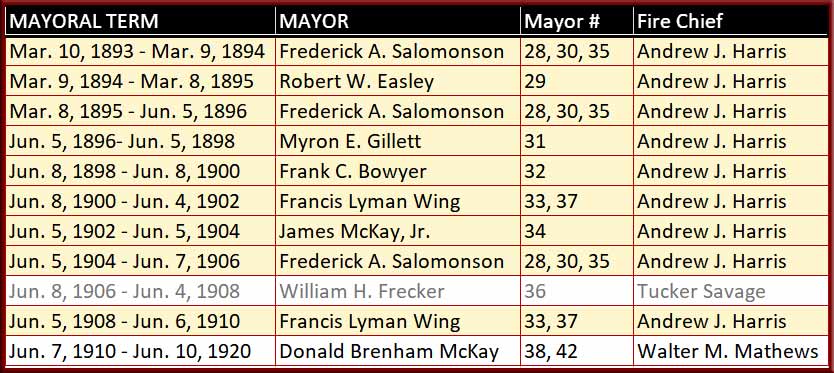
"He was
born in Gibraltar, England, but came to the United
States while in his teens." Harris' son's
death certificate says A. J. was born in Liverpool.
The information was given by A.J.'s daughter,
Marguerite Leslie Harris.
"He
fought in the Confederate Army while a young man, and
with the late Geo. T. Chamberlain served as volunteer in
the Philadelphia fire dept. Then he removed to
Savannah.." These statements are not in
chronological order. Harris was first in
Philadelphia, then came to Savannah and enlisted in the
Confederate Army.
"With
Mrs. Harris, he came to Tampa in the fall of 1885..."
Harris was still living in Savannah in the summer of
1886, as the article about the police street altercation
wrote, Harris was walking home with his wife. If
they came in the fall, it was the fall of 1886.
"Tampa
had no fire dept...He suggested one." Tampa
had a volunteer dept. with A. C. Wuerpel as the chief.
"In
1890, Mayor Easeley placed him in charge of
the Tampa department..." Robert W. Easeley was
mayor of Tampa from March 9, 1894 to March 8, 1895.
Harris was ELECTED to the position of Fire Chief in May
1893, taking his position in early June, during the
administration of Fred Salomonson's second
(nonconsecutive) term as mayor.
"During
a state fair some years ago, while inspecting an
inclined plane...the fire chief fell from its highest
point, something like sixty feet." The Nov.
23, 1904 article published the day after the accident
says the fall was 32 feet.
Read the entire article.
The article
below published in the Tampa Tribune claims that some
details are "slightly off." However, it is the
opinion here that the details of Harris's life in
Savannah are more accurate than those depicted in the
Tribune's
eulogy.
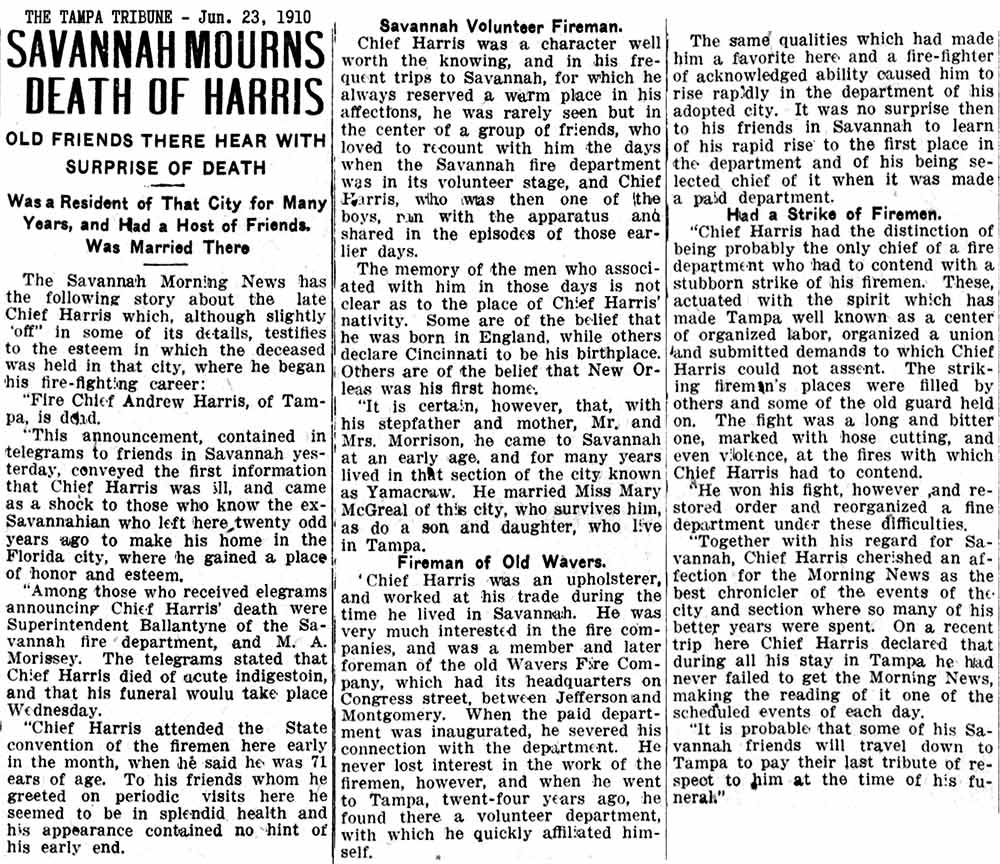
|
MARGUERITE HARRIS, DAUGHTER OF A. J. & MARY
HARRIS |
|
Maggie Harris was quite the socialite,
appearing in newspaper articles for various
reasons such as readings, musical talent,
party hostess, and civic events.
Announcement is made on Dec. 14, 1900 that Miss Harris was to
recite "How He Saved St. Michael's" at an
entertainment on Dec. 18th. St.
Michael's is the historic old church in
Charleston built in 1761. The belfry
in the spire was used for many years as a
fire lookout.
A
“steepleman” was posted in the open
arcaded area, and if he saw evidence of
a fire, would go down the narrow stairs
to the “ringing room” and pull eight
strokes on a rope attached to the
largest bell above. This 1900-pound bell
could be heard throughout the old city,
and firemen on the old “engine
companies” were trained to listen for
the signal. From almost any vantage
point, they could have seen St.
Michael’s steeple, and the steepleman’s
next job was to climb back up to the
arcade, light a lantern, and hang it on
a pole pointing in the direction of the
fire. This method was used until the
city put up separate fire bell towers in
the 1880’s as part of Charleston’s first
municipal fire department. S. Michael’s
steeple was also used during wars as a
military look-out, manned by local
soldiers during the Revolution and War
Between the States to observe besieging
forces around Charleston. By 1863, Union
troops on Morris Island were bombarding
the city regularly with rifled cannons
that could easily hit the glaring target
that St. Michael;s made, so the city
painted church and steeple a slate gray
so that it would blend in with the
horizon from a distance. (From
Charleston Footprints - St. Michael's
Steeple.)
Maggie had previously delivered her recitation at the
Charleston convention of fire engineers and
was an "instantaneous hit."
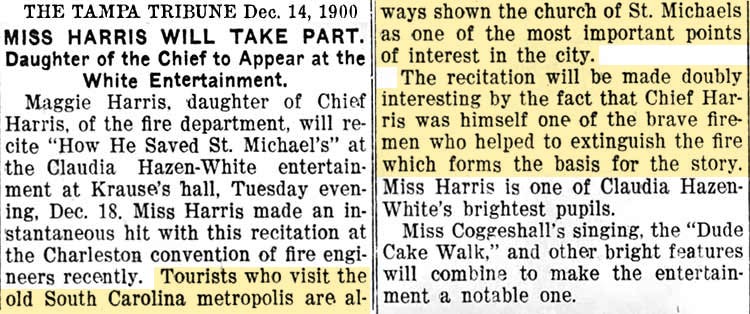
The great
Charleston fire of
December 1861 destroyed a third of
the city, and apparently spared St.
Michael's church. By Jan. 1, 1862, Harris was
already stationed at Camp Iverson in
Savannah, Georgia.
|
From the Charleston Mercury,
Dec. 12, 1861,
courtesy of Post & Courier
article.
“This morning dawned drearily
upon a night of terror and
disaster,” The Charleston
Mercury reported. “About nine
o’clock last evening the alarm
rang out, calling the citizens
to quell the beginnings of a
fire which, in the subsequent
extent and rapidity of its
ruinous sweep, will compare with
the most terrible conflagrations
which have ever visited the
American continent. The wild
work of the flames, and the
immense destruction of property
which has thus far taken place,
is chiefly attributable to the
sudden and unfortunate change in
the weather, which occurred
almost simultaneously with the
breaking out of the fire. The
mild and spring-like calmness of
the atmosphere during the last
fortnight was broken by heavy
gusts of wind, which swept the
dust and smoke and sparks hither
and thither in blinding clouds.
Great flaming bits of wood were
borne in dense showers for a
distance of nearly a mile in a
southwest direction, and the
whole city was brightly lit up
by the dreadful and widening
glare.
“Toward midnight the fire had
assumed proportions of appalling
magnitude. ...From the precincts
of Market, East Bay and
State-streets, the conflagration
had now reached Meeting and
Queen-streets, the terror of the
families (in many cases without
their usual protectors, owing to
the military exigencies of the
times) was contagious, and much
farther up into the city the
work of packing up valuables and
getting ready to desert their
homesteads became general. ...
“Twelve o’clock —
Meeting-street, from Market to
Queen, is one mass of flame. The
Circular Church and Institute
Hall are burning. The Mills
House is thought in imminent
danger, while the fire seems
stretching its red arms around
the Charleston Hotel. ...
“Three o’clock – The steeple of
the Circular Church has just
toppled and fallen with a heavy
crash. ...In the lower part of
the city the fire has done its
work in thorough style. Its path
is now burned out, and nothing
now remains to mark where it has
passed, save smoldering piles of
cinders and gaunt and smoking
walls and chimneys. The
Charleston Hotel is safe, and
Hayne-street, too. The wind has
swept the danger off, farther to
the south. Although the fire
rages on three sides of the
Mills House, that fine structure
has not caught [fire].
“Four o’clock — A change in the
wind has bent the course of the
fire toward Broad-street. ...
The Cathedral seems now in
exceeding danger. The buildings
on the west side of
Friend-street, near the corner
of Queen, are burning fiercely.
St. Andrew’s Hall is on fire,
and the noble spire of St.
Fingar’s glitters with a
splendor of portentous import.
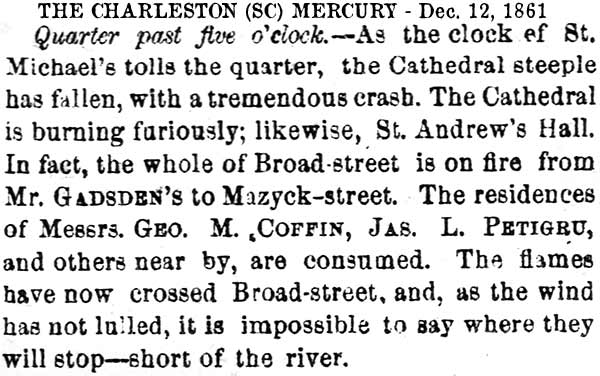
“Quarter-past five o’clock [the
newspaper’s deadline] — As
the clock of St. Michael’s tolls
the quarter, the Cathedral
steeple has fallen, with a
tremendous crash. The Cathedral
is burning furiously, likewise,
St. Andrew’s Hall**. ... The
flames have now crossed Broad
Street, and, as the wind has not
lulled, it is impossible to say
where they will stop, short of
the river. ... “Great indeed,
has been the calamity which has
fallen upon our noble old city.
But let us, with unfailing hope
and courage, bestir ourselves at
once to amend the losses we have
sustained, and to relieve, each
one according to his means, the
great suffering which the fire
must entail upon its poor
victims.” — The Charleston
Mercury, Dec. 12, 1861.
**The "Cathedral steeple
mentioned here is that of the
Cathedral of St. John the
Baptist at Broad St. between
King St. and Legare St., two
blocks from St. Michael's
Church. The reference to
St. Michael's is only the fact
that its clock was tolling 5:15.

It would take many years, many
heartbreaks and much sacrifice to
restore the damage done by the Great
Fire and the destruction destined to
come. Union guns would use St. Michael’s
steeple as an aiming point during the
bombardment that covered the peninsula
from just north of Calhoun street to The
Battery.
From
Post & Courier article.
The Charleston Daily Courier
also published stories about the
fire. Their Dec. 12, 1861
article gives a similar timeline
as the Mercury did, but the
Courier's coverage ends with the
fire's progress as of 2:00.
It does, however, mention
efforts of firefighters, those
excerpts are shown below.
Click the article to see the
original in its entirety.

Their Dec. 13 article gives a
street by street list of
building damage. St.
Michael's is not mentioned in
the Broad St. assessment, but
"the Cathedral" of St. John is
mentioned, as well as efforts of
firefighters. Below is the
beginning of that article and a
portion that mentions the
Cathedral. No mention
anywhere of damage to St.
Michael's church. We can
only assume that Maggie Harris'
story is true and that the
flames were somehow kept
away from this church.
See the whole article.
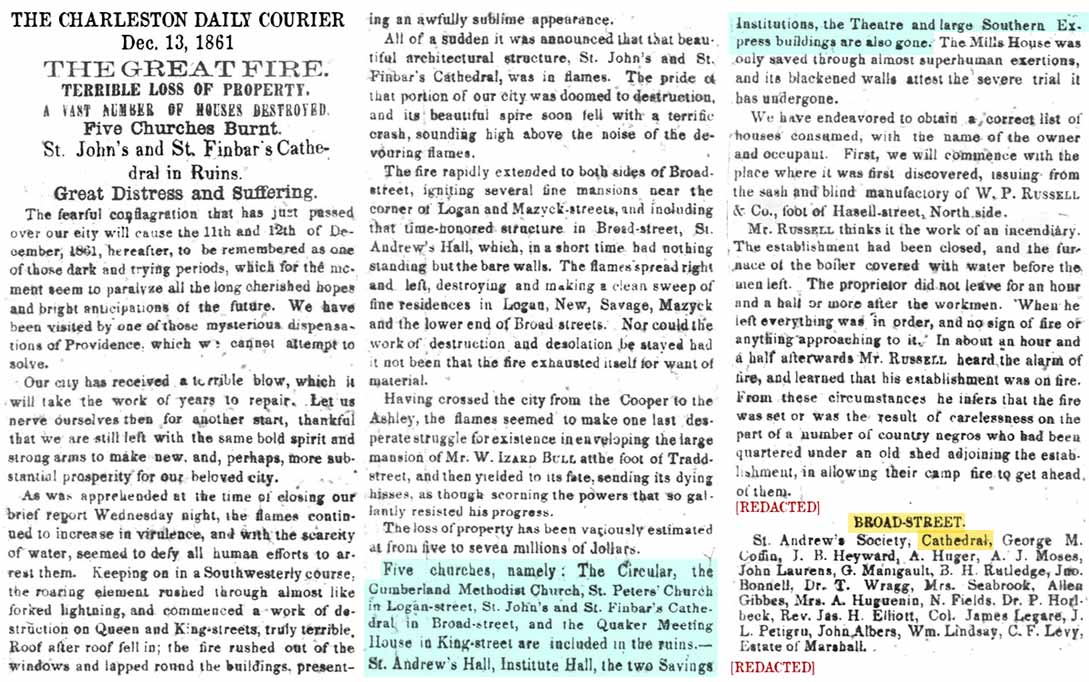 |
| |
MAGGIE TURNS FOURTEEN
|
Maggie turned fourteen on Oct.
18, 1901, thereby establishing
her birthday on Oct. 18, 1887.
Among her guests were friends
her age, including Irma and
Hortense Oppenheimer, daughters
of Dr. Louis Oppenheimer, and
Jessie Maas, daughter of Abe
Maas of the Maas brothers.
Listed second to last was
Maggie's brother, Andrew
(Martin) Harris. |
On May 12,
1902, Maggie hosted a trolley
party in honor of the 10th
anniversary of the establishment
of a paid fire department.
The party was three years too
early, as it was on March 22,
1895, the city council passed
ordinance #128 authorizing
Tampa's first professional, paid
fire department.
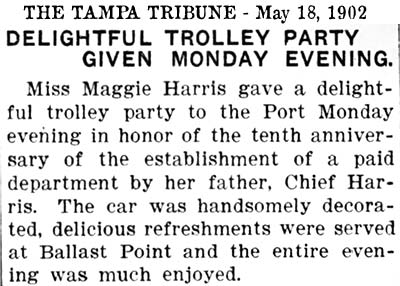 |
|
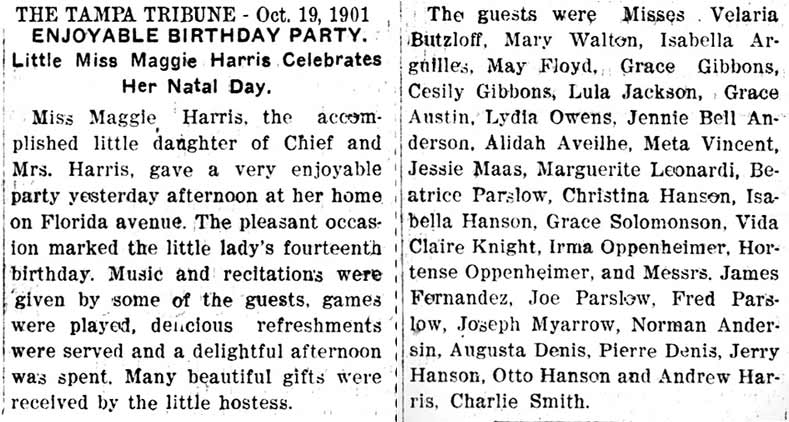 |
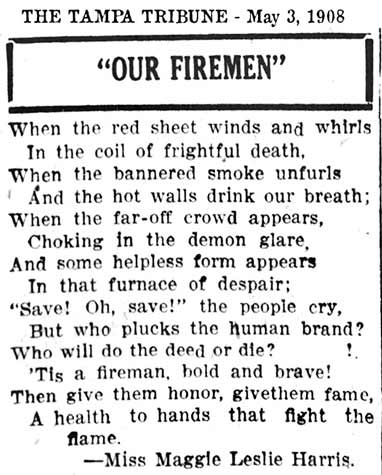
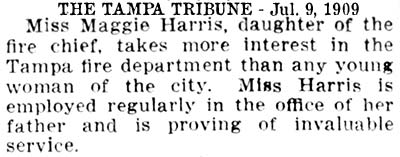
MAGGIE HARRIS ORGANIZES PORT TAMPA FIRE
DEPT,
MAKES HISTORIC STRIDE
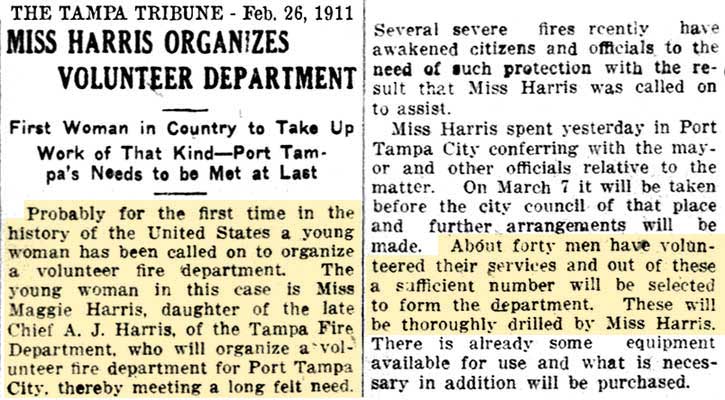
"Probably for the first time in the history
of the United States a young woman has been
called upon to organize a volunteer fire
department."
Maggie Harris was no ordinary young woman,
she was the daughter of the legendary A. J.
Harris, Tampa's favorite and longest-serving
Fire Chief who passed away in 1910.
Several recent fires in Port Tampa (which
was a separate municipality from Tampa)
prompted the citizens and officials to call
upon Maggie Harris to assist.
Forty men volunteered for service.
Those selected would be thoroughly drilled.
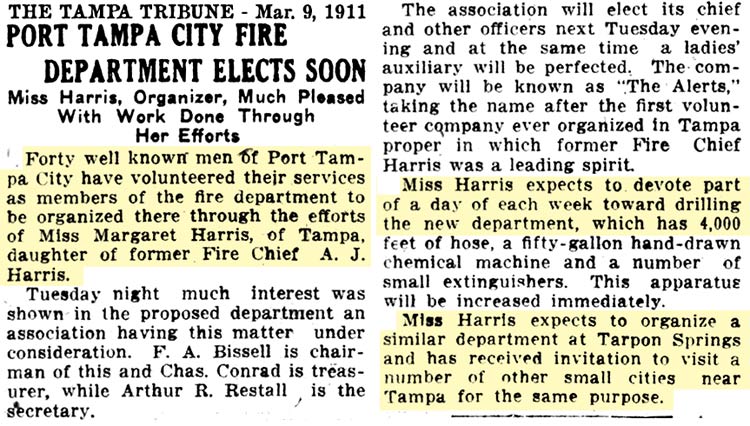
The association formed for the purpose was
planning to elect officers the following
week. The fire company would be named
"The Alerts" taking the name of the first
volunteer company ever organized in Tampa of
which the former chief, A. J. Harris, was a
"leading spirit."
Miss Harris was expecting to organize a
similar department in Tarpon Springs and had
received invitations to visit other small
cities in the area to do the same.
|
The Tribune made it known that a
Philadelphia newspaper printed
an erroneous story concerning
Miss Harris, stating that the
article claimed it was the City
of Tampa's PAID fire dept that
she was training. The
paper also went on to trivialize
and mischaracterize her position
as being for the purpose to
induce men to serve by choosing
a "sweetsome young lady" to be
the chief. |
Margaret Harris continued her
work with the City and on May 1,
1912, the Tribune announced that
she and two other ladies had
been sworn in as Deputy Clerks
of the Circuit Court. |
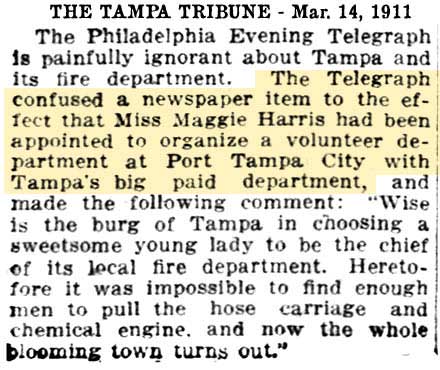 |
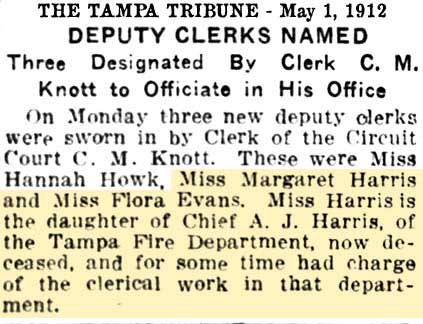 |
Maggie Harris made national news in 1911 when
Popular Mechanics magazine published a short
article about her organizing and training the Port Tampa
volunteer fire department. Several
newspapers across the country picked it up
and published it as well.
Popular Mechanics magazine images courtesy
of Google Books.
Mouse over the third page to see the article
larger.
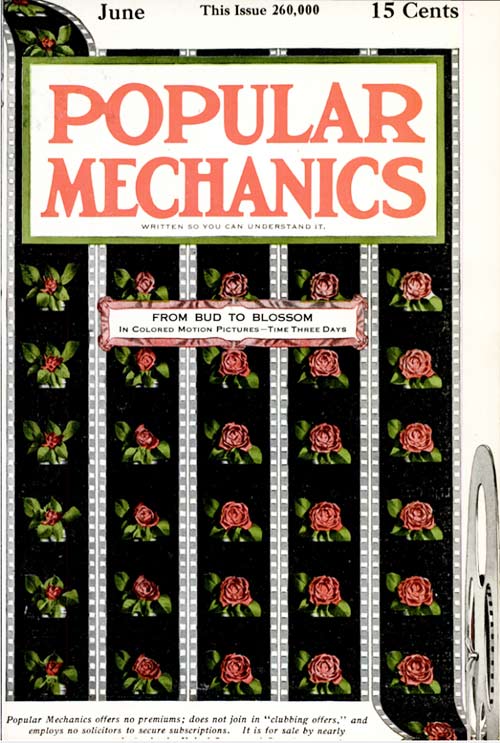
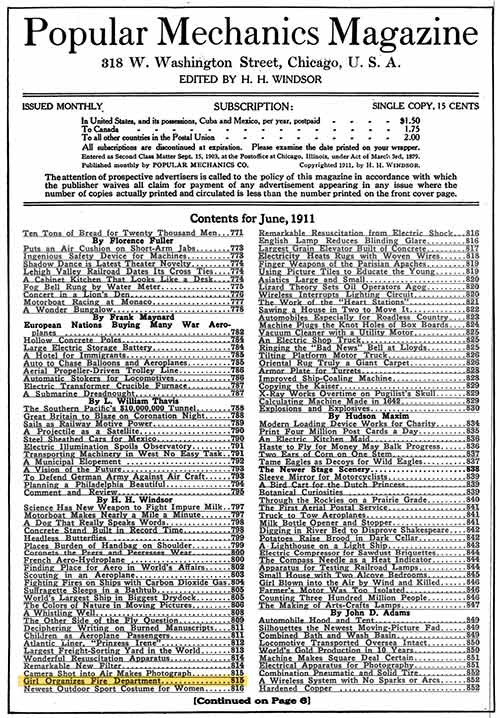


-Girl-Fire-Chief.jpg)
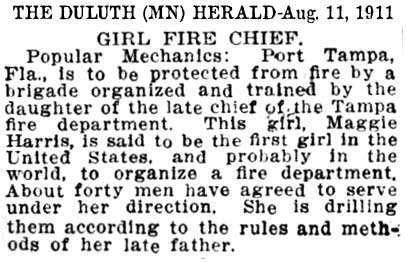
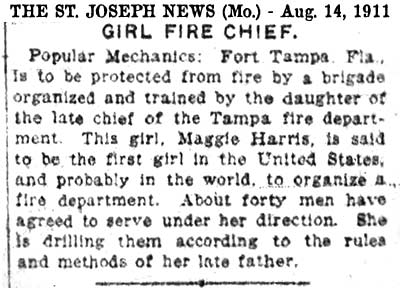
-DAILY-HEADLIGHT-Girl-fire-chief.jpg)

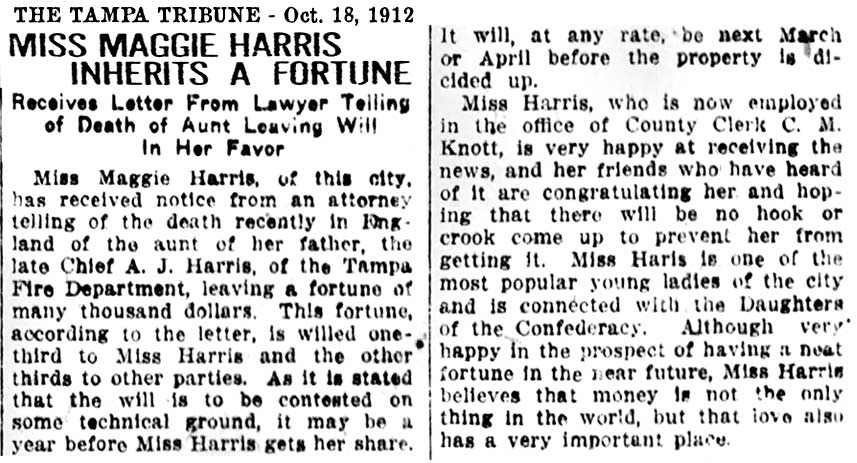
Nothing more
is ever published about this. |
THE HEROICS OF CHIEF HARRIS
REMEMBERED BY AN ANONYMOUS FRIEND
Below: On
the 1-year anniversary of his passing, the Tribune paid
this tribute to him from a letter received by his widow
from a friend (The letter incorrectly states his middle
name was James, and says he was born in 1839, arriving
in Philadelphia when he was sixteen years old.
This would put his arrival at 1855 instead of 1850.)
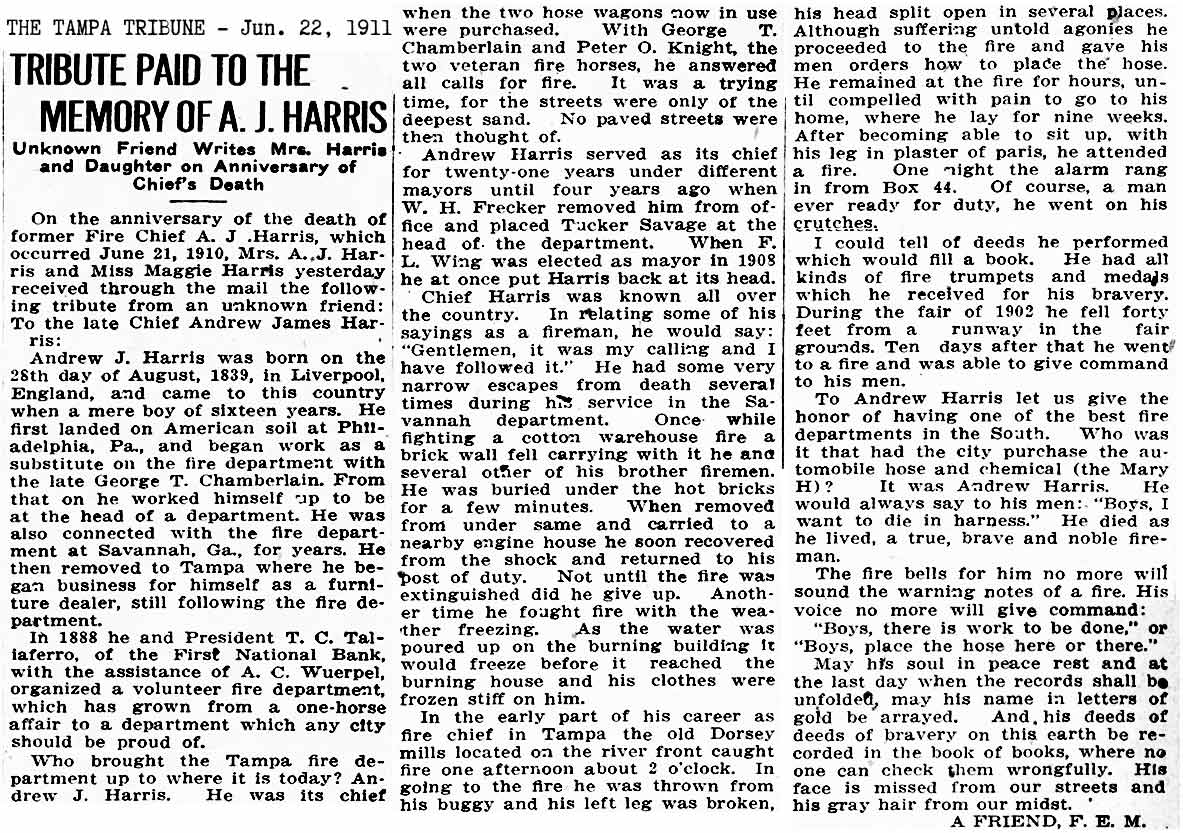
| |
|
DEATH OF MARY ELIZABETH MCGREAL HARRIS |
|
-widow-of-AJ-Harris.jpg) |
According to
her 1870 Census, she was 14 so she was born
around 1855-56. Mrs. Harris was 73,
not 63.
If she was in
Tampa for 44 years, the Harrises came in
1885. But they were still living in
Savannah in Jun. 1886 according to the
police/street mob incident article in the
Savannah Morning News.
George M.
Morris was A.J.'s half-brother.
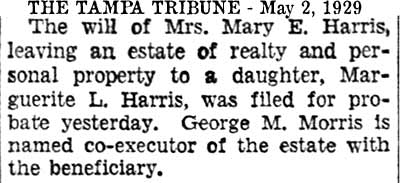 |
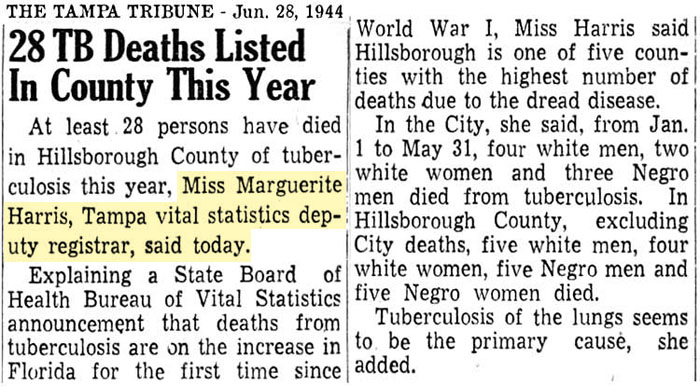
In the 1940s, Maggie Harris was deputy
registrar of the Hillsborough County Vital
Statistics bureau.
.jpg)
|
|
GEORGE MORRIS, HALF-BROTHER OF A. J.
HARRIS
George Marshall Morris was a fireman
with the Tampa Fire Dept. during the
years Harris was fire chief. He
was 30 years younger than Harris and was
born in Savannah, Ga. on Nov. 1, 1869.
He first comes up in Tampa newspapers on
Oct.. 9, 1895 when at the scene of a
fire at the City Hotel, he handed his
gold pocket watch to fellow fireman
Parrish for safekeeping, who put it in
his pocket. But the gold chain was
hanging out, and boy who saw this
snatched it and ran. He was
eventually caught and the watch
recovered, but damaged.
On the 1900 Census in Tampa, George is
single, age 30, and living in a boarding
house. His birthday is Nov. 1869,
b. Georgia. He indicates his
father was born in Spain, and his mother
was born in Ireland. She would
have been A.J. Harris' mother as well.
George was working as a switchman for
the railroad.
Articles from 1901 for several years
mention a George Morris with a "sweet
singing voice," appearing often in local
performances with others in Tampa.
This can be assumed to be A. J. Harris'
half-brother; evidence appears in a
Tribune article of Jun 8, 1934 when
George B. Morris, son of George M.
Morris, marries Aida Sierra in Tampa at
Sacred Heart Church, the bridegroom's
father was to sing Millard's "Ave
Maria."
On Aug. 11, 1902, George Morris married
Miss Annie Lula Knight in Tampa,
daughter of Dr. James A. Knight of
Eatonton, Ga. The Tribune
article names him as "George Michael
Morris, Jr....one of the most popular
young men in the city. He was for
a long time in the employ of the
Seaboard Air Line railroad, but later
with the Tampa Fire Department and the
Tampa Electric Co. He has friends
by the score, who will wish him the best
of good fortune." They were to
live with Mr. and Mrs. Lopez on Fla.
Ave., Mrs. Lopez was a sister of the
bride. They received many gifts,
among them was a "handsome silver set
and suite of furniture from the Tampa
Fire Dept., of which Mr. Morris was for
a long time a valued member.
Apparently, Morris' fire fighting days
were not over. A March 8, 1903
Tribune article covers an explosion and
subsequent fire on the roof of the
Citizens Bank bldg on the northeast
corner of Franklin and Zack. The
explosion took place in the Southern
Bell Telephone Co. on the top floor, and
though the fire was put out with
extinguishers by the employees, the
melting insulation of the hot wires
leading to the roof started a fire in
the attic which spread to the roof in
sheets of flames. The article
says, "there was difficulty reaching the
roof...George Morris, who, although not
a member of the department, always does
good work when needed, climbed to the
roof with the agility of a squirrel,
carrying a line of hose. Among the
hundreds of wires and on the slippery
slate roof, it was a most dangerous
hazard that Morris took, but he did not
hesitate, and soon, followed by others,
turned the water into the roaring blaze
that was eating its way through the
timbers at the top of the building...It
was only a few minutes before the flames
were under control that Morris, still
carrying his hose, made a hazardous trip
around the slipper edges of the roof,
and drowned out the last remaining
tongue of fire bursting through a
skylight on the south side.
An article the next day describes the
damage, phone service being
restored, and George Morris being
rewarded by Pres. John Trice of the
Citizens Bank, owners of the building.
Morris was given a $10 check in
appreciation for his heroic services.
On Aug. 23, 1903, the Tribune published
that George Morris Jr. has located to
132 Laurel St. in West Tampa. "He
says West Tampa is a coming place."
By 1904 Morris was made the West Tampa
Fire Dept. Chief. The Sept. 29,
1904 Tribune published that "The Little
Chief", daughter of Mr. & Mrs. George
Morris of West Tampa, was born
yesterday, and the George is still able
to attend to his duties as Fire Chief.
(This is his only daughter, Marie.)
A Sept. 7, 1906 Tribune article
announces George M. Morris, Jr, former
Chief of the West Tampa Fire Dept, is
the proud father of a 7 1/2 lb. boy,
Leon Meriwether Morris, named in
honor of his old friend, Leon
Meriwether, the furniture man.
An article in the Dec. 20, 1908 Tampa
Tribune announced the birth of Mr. &
Mrs. George M. Morris Jr's ten-pound
baby boy in West Hyde Park. This was
George B. Morris. "This makes two boys
and one girl at the home of Mr. & Mrs.
Morris now."
The 1910 Census of Tampa lists George M.
Morris and wife Lulu living at 1816 Fig
St. Their daughter Marie is
5 and son Leon is 3. It's
not known why their infant son George B.
Morris isn't listed. The family
was enumerated at the bottom of the page
ending with Leon Morris. It could
be he forgot to list George B. at the
top of the next page. (George
Bernard Morris later goes on to
college in 1927 at Spring Hill College
in Mobile, Ala. to study mechanical
engineering and in Sept. 1928 leaves for
University of Michigan to obtain his
3-yr degree in Architecture. Sept.
28, 1928 Tampa Times, the source of his
middle name. He returns and
marries Aida Sierra, daughter of Mr. &
Mrs. Antonio Sierra in Tampa on Jun 8,
1934. )
Annie Lulu (Knight) Morris died on May
5, 1911 in Tampa. The only article
in the newspaper about her death was
titled "TRIBUTE OF LOVE" and was written
by her aunt. "Mrs. George Morris
was the third daughter of the late Dr.
Jas. A. Knight, and is survived by four
brothers and five sisters. She was
well known in Putnam County, having
lived here until she married Mr. Geo.
Morris of Tampa eight years ago.
Three children came to bless this
happy union, Marie (6), and so like her
gentle mother, Leon (4) and George (2)....Her
life, like the Master's, was not long as
we count years--only thirty-two on the
15th of Sept. 1910. ("By her
loving aunt, Mrs. Johnson King.)
Under the article is a "Card of Thanks"
from George Morris to the kind people of
Eatonton and Putnam County, Ga.
On the 1920 Census of Tampa, George
Morris is 50, living on Chapin St. in
Palmetto, (the area opposite the Ybor
Channel from downtown), his wife
is Armenia (45), born in New Jersey.
George shows he was born in Ga., father
born in Spain, mother born in IRELAND.
George's children would be 15, 13, and
11, but aren't listed in their home.
Maybe they were living in Georgia with
their mother's family. (The
1920 Census of Harrison, Putnam Co, Ga.
shows a 15 year old Marie Morris, born
in Florida, related as a niece to the
the head of house, A. L. Clements (53)
wife May (43) and son Luther (23).
Marie Morris says both her parents were
born in Georgia, but that her father was
"Spanish." No doubt this is George
and Annie Morris' daughter.)
George was working as a switchman for
the railroad. An article in the
Oct. 20, 1924 Tribune titled "Doctors
give up hope for Mrs. George Morris"
states that a letter the Tampa Times
received reads "George Morris, who was
recently called to Jersey City on
account of the serious illness of his
wife, writes that the physicians who are
attending her have given up all hope of
her recovery. She was first taken
to a specialist in NY for treatment for
cancer and later to a hospital in Jersey
City."
Unable to locate George M. Morris on the
1930 Census.
On the 1935 Census George Morris is
found at the same place as in 1920, at
2017 Chapin St. in Palmetto. he is
66 and a disabled "team man." His wife
is Mary, 45, born in Austria.
They have a son Michael Morris who is 5
years old. It's not known if he
was a son of George's previous wife,
Armenia, or his present wife, Mary.
According to his age, he would have been
born a year after doctors had given up
hope on Armenia Morris surviving cancer.
If he is a son of George's current wife,
and her age is correct, Mary was 40 when
Michael was born.
Also on this same 1935 Census, George B.
Morris and his wife Ida (Sierra), are
listed on the next census page at 2013
Chapin St.
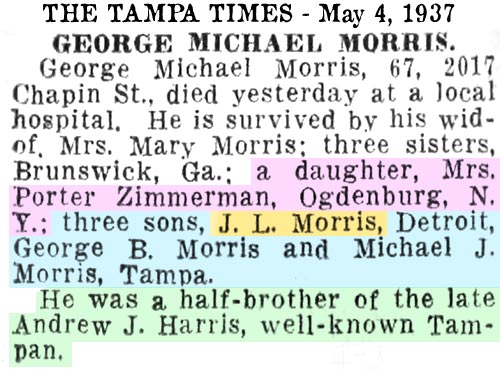 George
M. Morris died May 3, 1937 at St.
Joseph's hospital in Tampa.
According to his death certificate, info
for which was given by his son, George
B. Morris of 2013 Chapin St, George's
name was GEORGE MARSHALL MORRIS.
His name in the newspapers varied as
George Michael Morris and George
Mitchell Morris, or George M. Morris Jr.
He was none of those. George
M. Morris died May 3, 1937 at St.
Joseph's hospital in Tampa.
According to his death certificate, info
for which was given by his son, George
B. Morris of 2013 Chapin St, George's
name was GEORGE MARSHALL MORRIS.
His name in the newspapers varied as
George Michael Morris and George
Mitchell Morris, or George M. Morris Jr.
He was none of those.
As can be expected, his obituary
contains numerous errors. Information
may have been obtained from his current
(3RD)
wife who probably didn't know much about
his past or his family.
J. L. Morris was actually his first son,
Leon Meriwether Morris. Michael J.
Morris would have been his son from his
2nd or 3rd wife.
|
BUREAU OF VITAL STATISTICS |
STATE
FILE NO. 8988, Registered
No. 446 |
|
GEORGE MARSHALL MORRIS |
Length of time in Tampa: 43
yrs. |
|
Residence: 2017 Chapin St.,
Palmetto Beach. |
Occupation: Switchman, SAL
Railroad |
|
Husband of: Mary
Hricinda* |
Last worked at this
occupation: July 11,
1936, worked 18 years. |
|
DOB: Nov. 1, 1869, Savannah,
Ga. |
DOD: May 3, 1937 |
|
AGE: 67 yrs, 6 mos, 2 days. |
Cause: Septicemia |
|
FATHER:
GEORGE MORRIS, b. Barcelona,
Spain |
Buried:
Myrtle Hill Cem, May 5,
1937. |
|
MOTHER: MARY JANE GILLIAN,
b. Ireland |
Informant: George B. Morris,
2013 Chapin St, Tampa |
|
*Only
3 instances of the surname "Hricinda"
occur in all millions of
pages at newspapers.com, for
all time. Two occur in
the obituary of Paul Burcin,
a coal miner who died in
Hazelton, Pa. in 1985.
Hricinda was his mother's
maiden name. The other
use is in Tampa, on a
marriage license published
in the Tampa Times in 1919,
the license of Evaristo
Lorences and Ena Hricinda.

Assuming the above is
correct, George M. Morris
and Andrew J. Harris' mother
was Mary Jane Gillian, born
in Ireland.
FATHER OF GEORGE MARSHALL
MORRIS
1920 Census, Glynn,
Brunswick, Ga.
George M. Morris, age 99,
immigrated 1832, Naturalized
1840, born Barcelona, Spain,
parents born Spain.
 |
|
This would be A. J. Harris'
stepfather, with whom he was
supposedly immigrated to the
U.S. with in 1850 to 1855.
But it's not known if they
immigrated along with A.J.'s
mother, or if she died
before they left England,
and George M. Morris
remarried in the U.S. before
coming to Savannah.
 The
Savannah newspaper said that
A. J. Harris came to
Savannah at an early age,
with his step-father and
mother, but they may not
have known if she wasn't his
mother, but a
step-mother--someone whom
his father may have married
in the U.S. after arriving. The
Savannah newspaper said that
A. J. Harris came to
Savannah at an early age,
with his step-father and
mother, but they may not
have known if she wasn't his
mother, but a
step-mother--someone whom
his father may have married
in the U.S. after arriving.
DEATH OF GEORGE MARSHALL
MORRIS' FATHER |
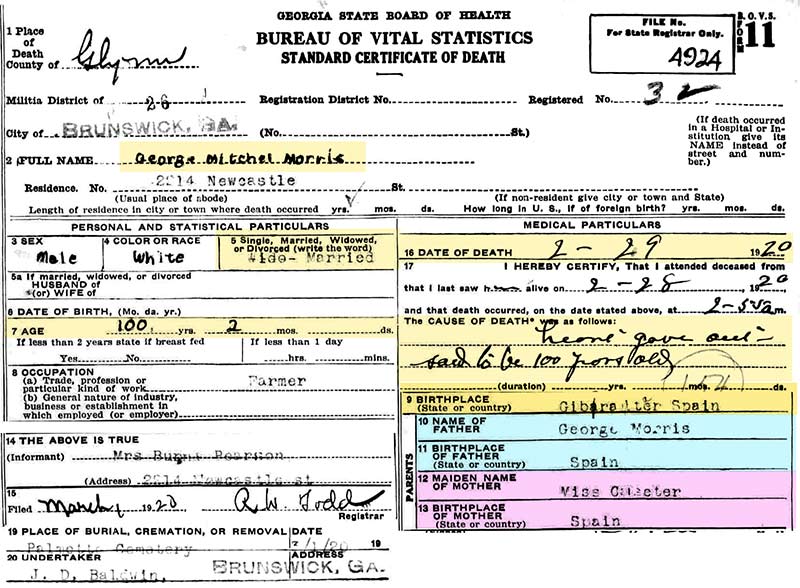
GEORGE MITCHEL MORRIS
George Mitchel Morris died Feb. 29, 1920
in Brunswick, Ga.
His cause of death shows "heart gave
out, said to be 100 years old."
Here is the Gibraltar connection:
He was born in Gibraltar, Spain.
While geographically, Gibraltar is
located at the southern tip of Spain, it
was a British Colony since the early
1700s and primarily a military base.
Somehow, sometime, somewhere, George
Mitchel Morris of Gibraltar met Mary
Jane (Gillian) Harris of Ireland and
they married some time after her son
Andrew J. Harris was born (Aug 1838).
Possibly in Gibraltar.
Did they all leave England from
Liverpool in the 1850s and arrive in
Philadelphia, eventually making their
way to Savannah by 1860? Or did
Mary Jane die before her son and George
Mitchel Morris came to America,
resulting in only Andrew and his
step-father emigrating?
Following the Great Siege,
the civilian population of
Gibraltar – which had fallen
to under a thousand –
expanded rapidly as the
territory became both a
place of economic
opportunity and a refuge
from the Napoleonic Wars.
Britain's loss of North
American colonies in 1776
led to much of her trade
being redirected to new
markets in India and the
East Indies. The favored
route to the east was via
Egypt, even before the Suez
Canal had been built, and
Gibraltar was the first
British port reached by
ships heading there. The new
maritime traffic gave
Gibraltar a greatly
increased role as a trading
port. At the same time, it
was a haven in the western
Mediterranean from the
disruption of the Napoleonic
Wars. Many of the new
immigrants were Genoese
people who had fled
Napoleon's annexation of the
old Republic of Genoa.
By 1813 nearly a third of
the population consisted of
Genoese and Italians.
Portuguese made up another
20 per cent, Spaniards 16.5
per cent, Jews 15.5 per
cent, British 13 per cent
and Menorcans 4 per cent.
The young Benjamin Disraeli
described the inhabitants of
Gibraltar as a mixture of
"Moors with costumes as
radiant as a rainbow or
Eastern melodrama, Jews with
gaberdines and skull-caps,
Genoese, Highlanders and
Spanish." The
inhabitants had a clear
pecking order, with British
officers at the top and Jews
at the bottom. The American
naval officer Alexander
Slidell Mackenzie, writing
in 1829, described the
market traders and shoppers
in what is now John
Mackintosh Square:
The high handed
hauteur of his majesty's
officer, as he lounges
at a corner in utter
scorn of the busy crew
of bargainers; the
supple citizen who bows
breast low to him in
hope of a nod of
condescension ... ; a
rough skipper,
accustomed to bang and
bully and be a little
king upon his own
quarter-deck; the sullen
demeanour of the
turbaned Moor, who sits
crosslegged at a shady
corner ... the filthy,
slipshod, abject Jew,
who sells slippers or
oranges, or serves
officers, merchants,
sailors, or Moors, as a
beast of burden ...
(Above
from Wikipedia, "Gibraltar
as a Colony.")
|
|
| |
THE BEGINNINGS OF TAMPA'S FIRST
VOLUNTEER FIRE DEPT & CHIEF A. C. WUERPEL |
|